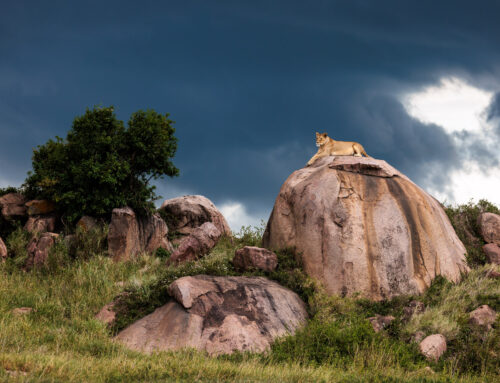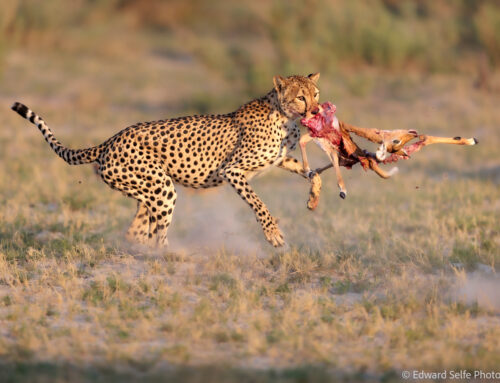It is a strange fact that over the last 2 safari seasons, I have run just two photo tours, but both of them have been long trips, with international guests, covering multiple areas of Zambia. My latest trip, with guests from North America, was my longest ever, spanning a full 26 nights in 7 different camps. The world is truly a strange place when some people are not able to travel freely as they wish and others are able to join me on extensive travels. To those who could travel, thank you from me and from the camps to which you brought valuable business; and to those who cannot, I sympathise and I very much look forward to sharing that excitement when the time comes.
Over the last 4 or 5 years, I have run increasingly long safaris; partly this is because Zambia is hard to get to and guests want to maximise their experience here, but probably more because there is so much diversity and opportunity for safari in this great country. As you will see in the coming report, there is much to explore in Zambia and even 4 weeks on safari does not exhaust the opportunities. However, that is not to say that 5-, 7-, 8- or 10-night safaris are not still long enough to enjoy wonderful sightings and many of my trips are still of this length and bring great results.
As anyone reading this report will see, we spent no more than 4 or 5 nights (and sometimes less) at each camp, and every camp gave us sightings that contributed to the overall enjoyment of the trip. The fact that a brief 2 nights at a camps still offers great sightings truly reflects the wealth and abundance of the wildlife heritage of Zambia. I hope you enjoy the journey and thank you for reading.
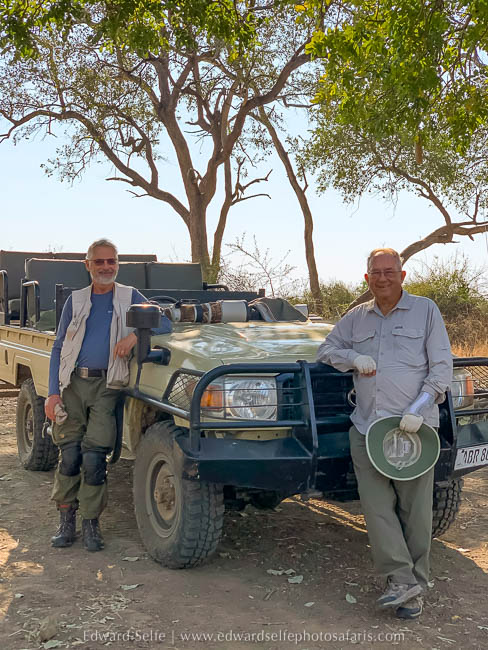
Tom and Kent, early on in our safari in South Luangwa.
We started our safari at Flatdogs Camp, a beautiful camp set on the banks of the Luangwa River, just 3 minutes’ drive from the National Park. One of the very special features of this large, open camp is that wildlife freely moves in and out. We arrived and were greeted by elephants feeding on fallen seed pods.
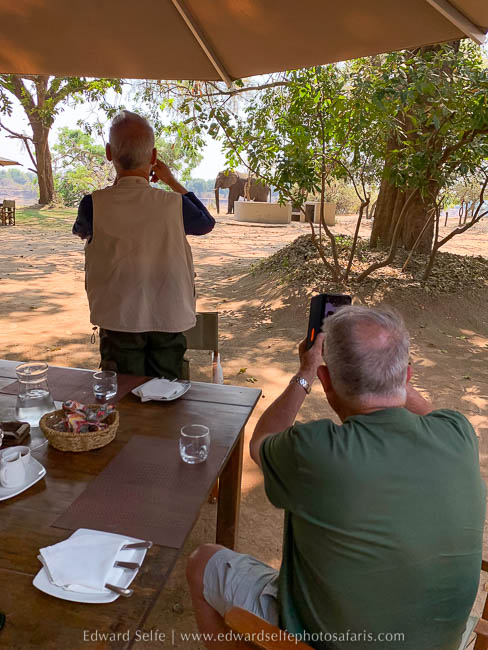
Arriving at Flatdogs Camp, lunch was delayed by some visitors.
So what follows are the photo sightings that we enjoyed from Flatdogs Camp, where we spent 4 nights. Of course, there are many more that did not give photo opportunities or which I haven’t included; sometimes it’s just better to watch!
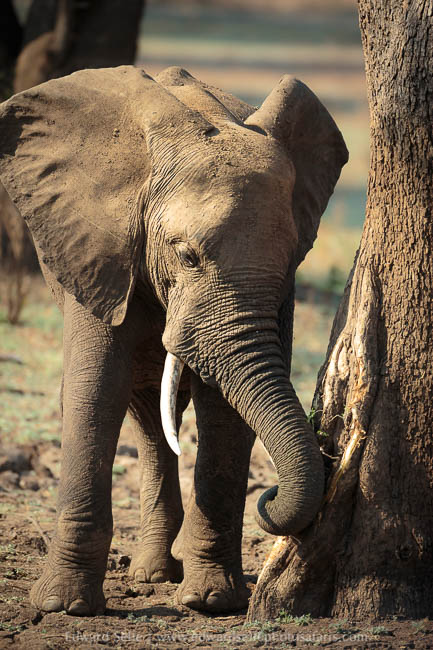
On our first afternoon out, we took things slowly, spending time with everything we found and making sure that cameras were set up correctly. Since most people last travelled, mirrorless cameras have gained considerable market share and my guests were using Canon and Sony mirrorless kit. Neither had much experience using it in the high-speed wildlife safari setting, so it was useful to take things slowly.
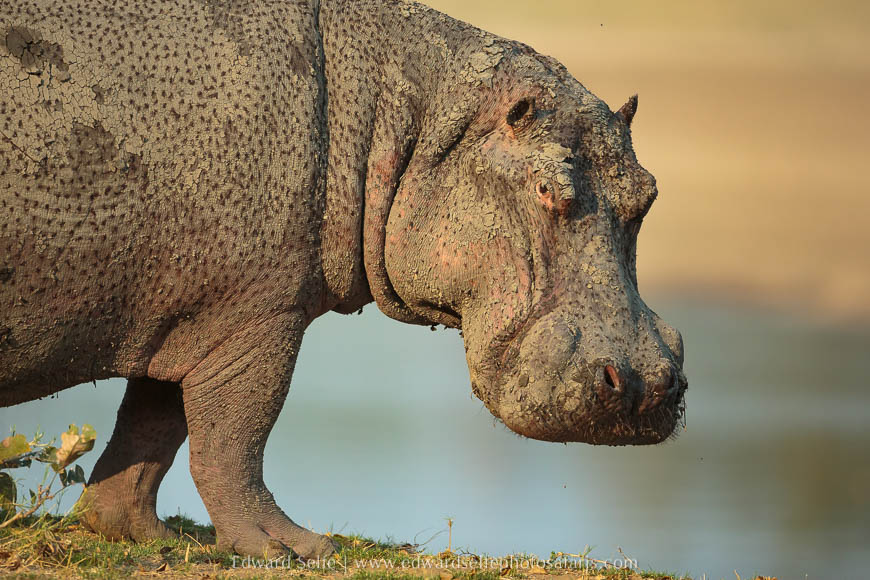
We had a bit of a stand-off with this hippo. He was standing at the top of a steep bank, with nowhere to go, and we inadvertently cut off his escape route back into the bush. We sat quietly until he settled and then moved away!
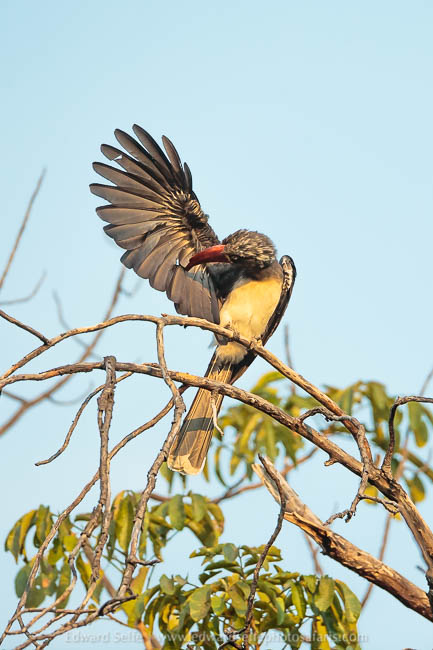
Mirrorless cameras’ AF tracking systems are one of their key selling points. We were keen to see how the Canon and Sony did with birds in flight, so we took every chance to practice…however this Crowned Hornbill refused to fly, preferring to preen his secondaries!
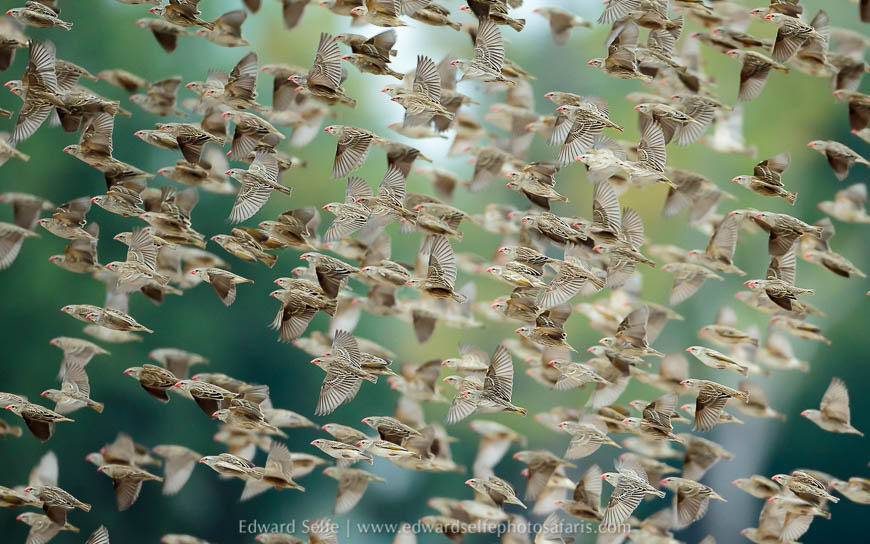
We had one murky, cloudy day which is unusual at this time of year. The soft light can be helpful though and we focused on shape, form and panning blur shots which are less dependent on “nice light”. I was happy to get one of my favourite Red-billed Quelea shots….
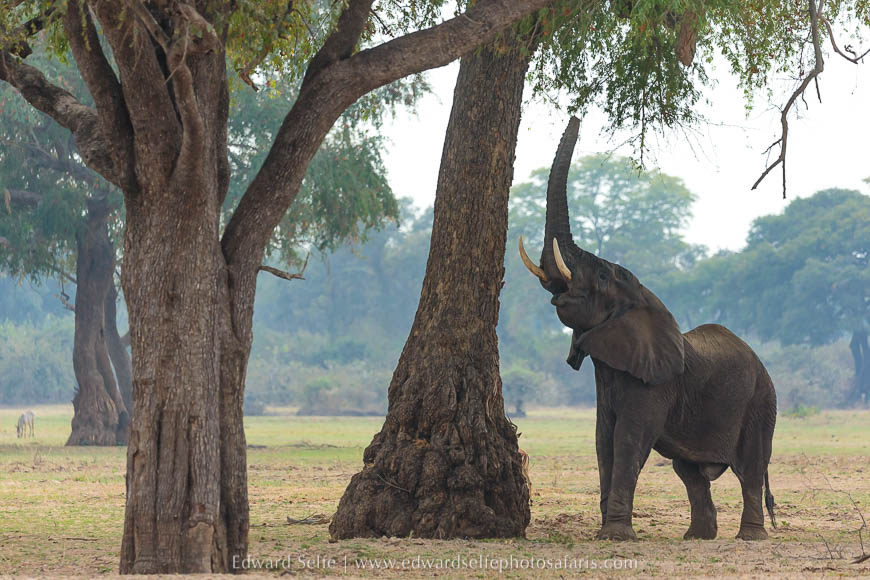
…and this young bull elephant was very obliging with his display of reaching and shaking trees.
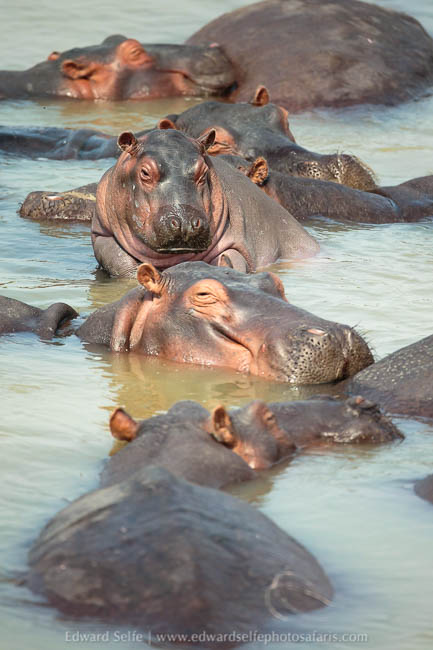
With guests who stay for a long time, it’s possible for a guide to follow any small lead that the bush might give, or just to sit and watch where a situation seems promising. In this case, the high density of hippos in one spot was very interesting, so we sat and watched, photographing the hippos and birds as they flew by. All of a sudden, a young hippo climbed out onto his mother’s back and we had a great photo!
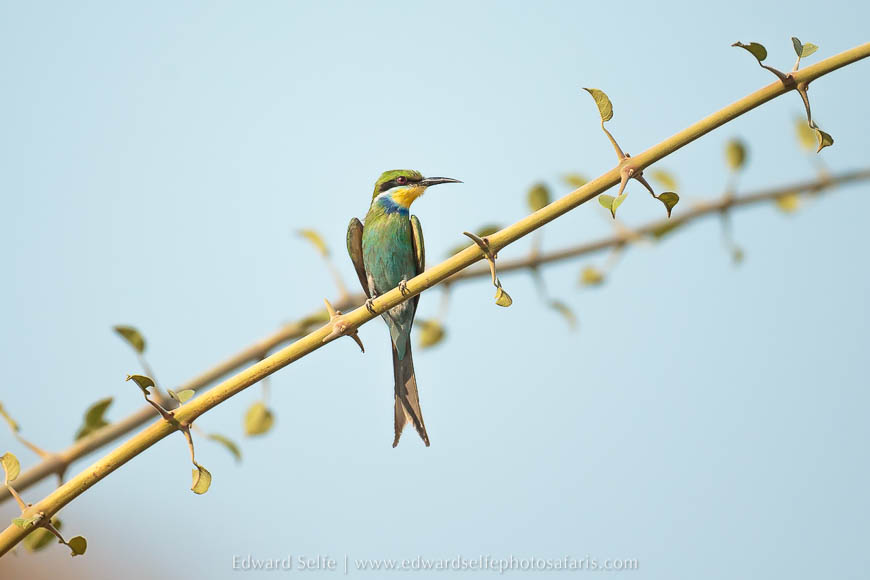
New cameras often have very high megapixel counts so birds are more achievable targets than ever before. We had fun with these beautiful Swallow-tailed Bee-eaters (and with the Lesser Striped Swallows below) though you have to be quick as they never sit still for long before launching their next aerial sortie!
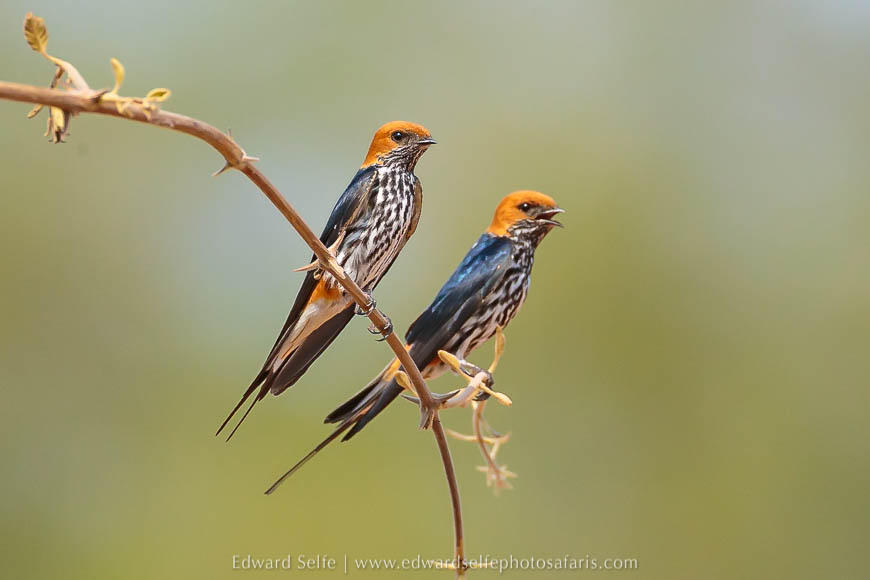
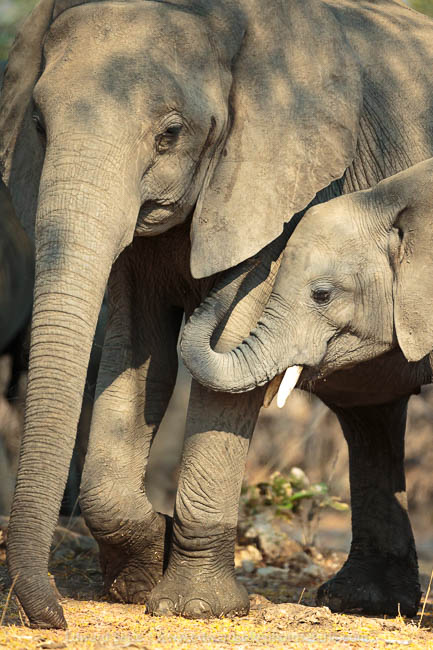
An afternoon heading north gave us wonderful elephant sightings including this youngster greeting a family member….
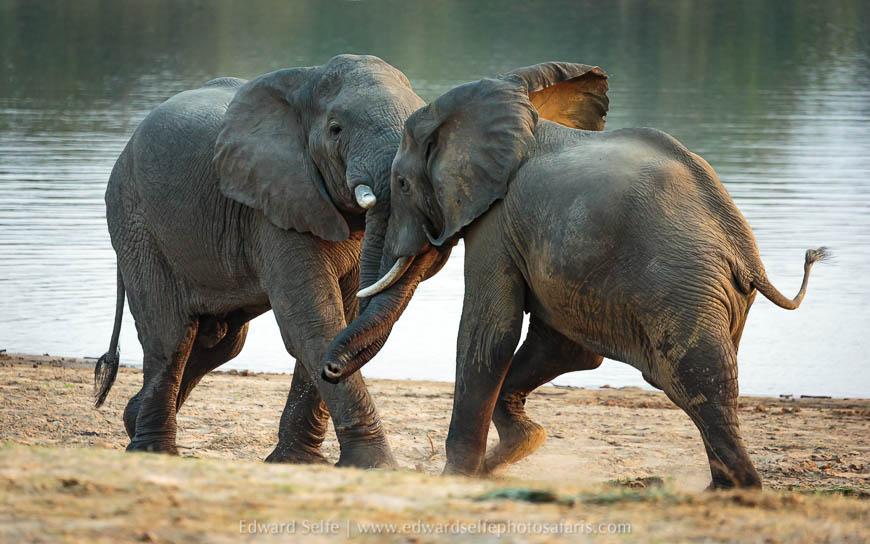
…these two bulls play fighting on the banks of the river…
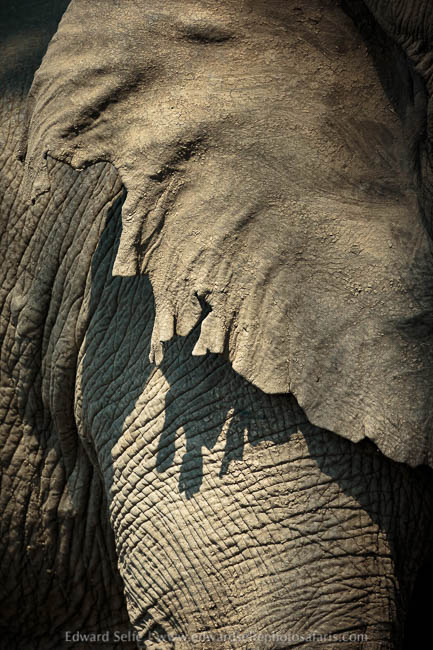
…the beautiful textures of this old man’s ragged ears….
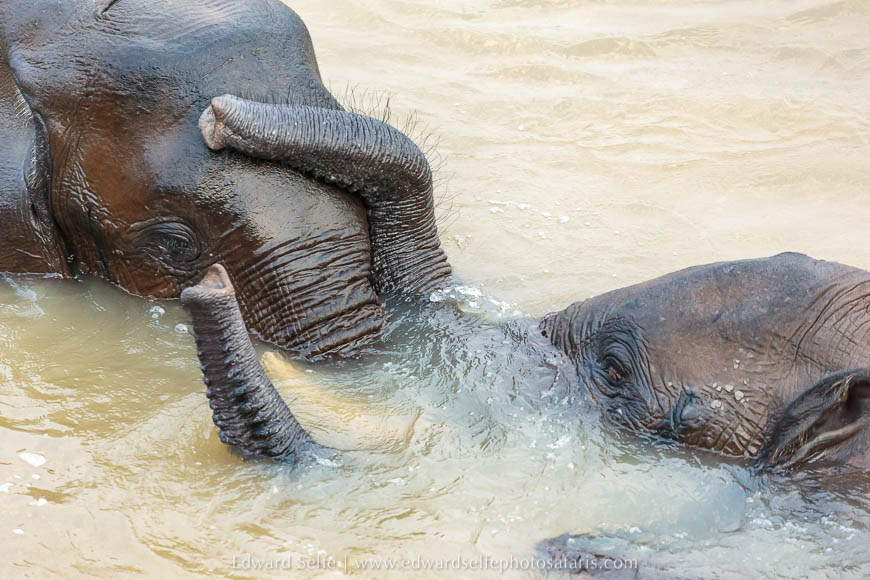
and a couple of young bulls who played in the deep water for more than half an hour while we sat above them on the steep bank and watched the sun set.
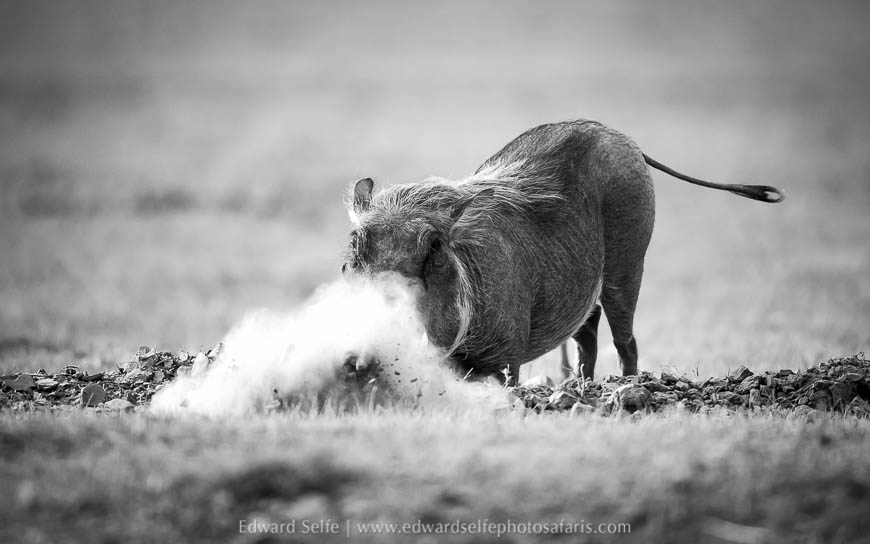
With the soft, diffused light of late dry season, it’s possible to shoot into the light and capture the spray of elephants drinking or the puff of dust lifted by a warthog when digging for roots.
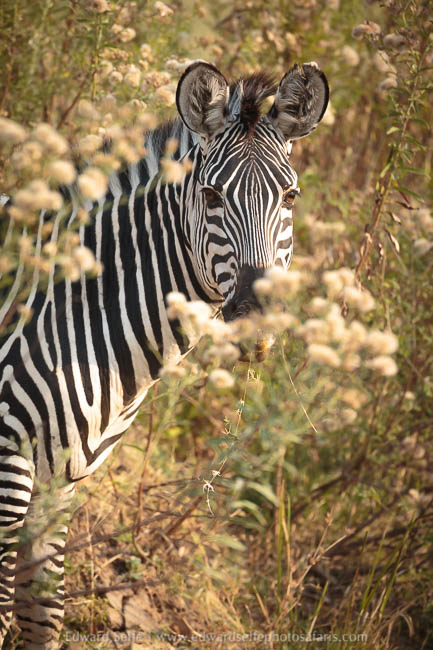
Veronia seed-heads making a natural frame around a zebra in great light!
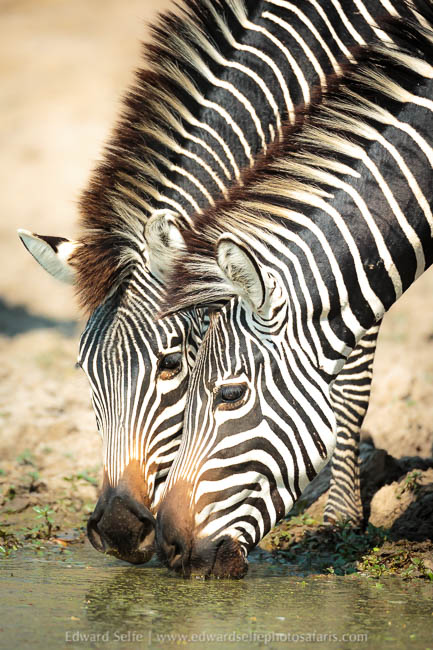
We stopped for coffee break late one morning at a waterhole and were surprised to find a herd of zebras coming to join us. They seemed unbothered by us, or just very thirsty!, so we kept still and they drank just 10 meters away.
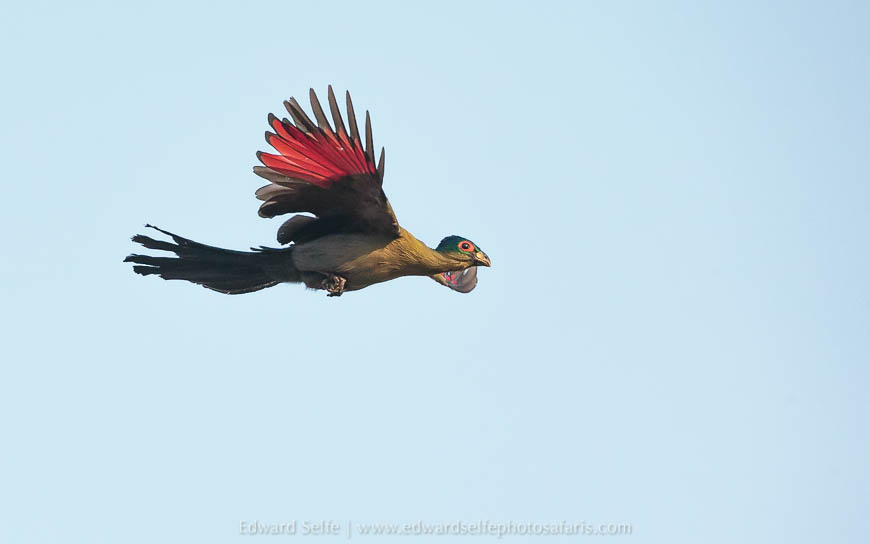
I mentioned my long-time ambition to capture a Purple-crested Turaco in flight and immediately Tom and Kent were keen to join in! We found a family in a promising location and positioned ourselves ready to photograph them as they moved from one tree to another. In the end, we all got some good shots, but my take away feeling is that they are not as good looking in flight as they are when perched!!!
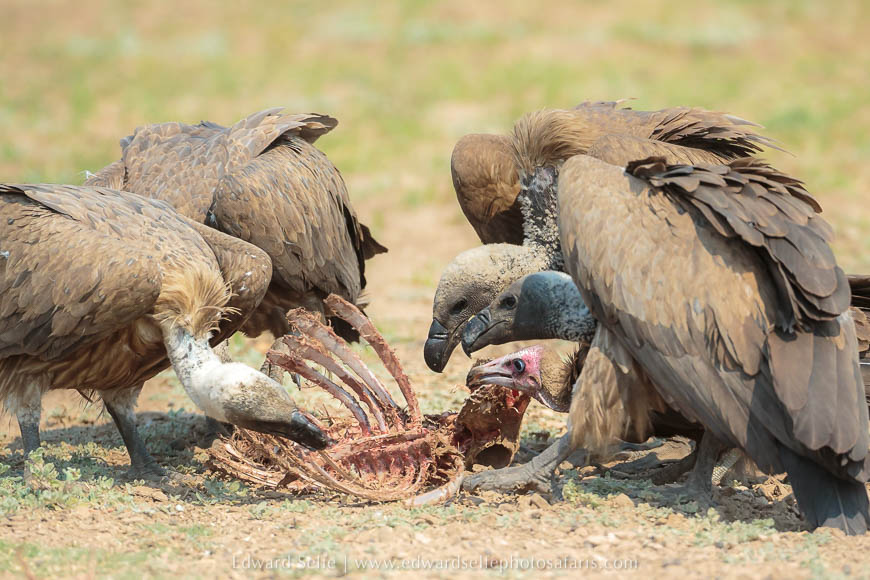
That same day, we found a fresh kill on the ground (we think made by wild dogs) and we spent time watching the vultures and other scavengers clearing up the remains.
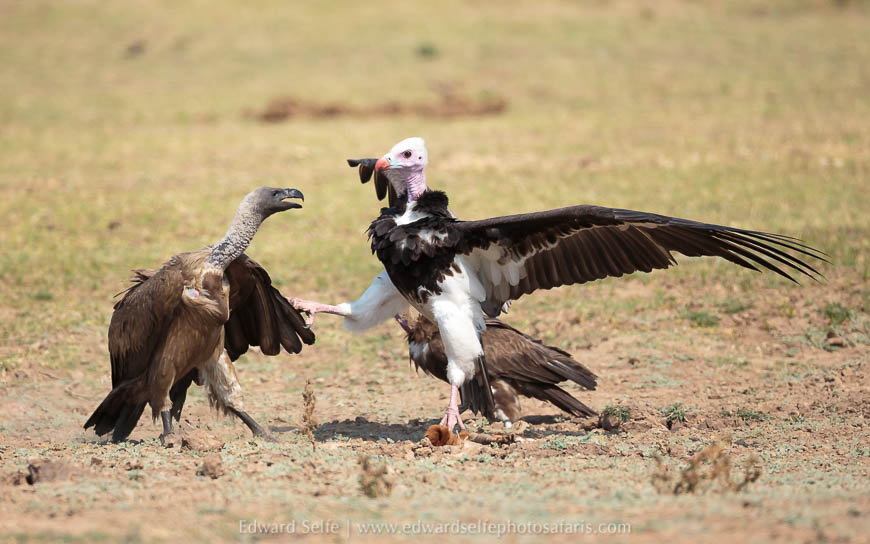
White-headed Vultures used their superior size to chase off White-backed Vultures….
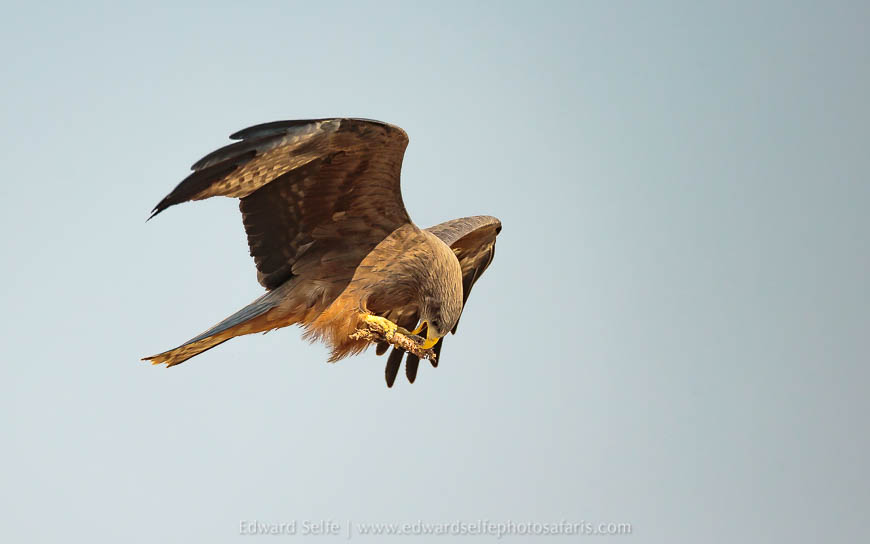
…and Yellow-billed Kites swooped down to collect scraps off the ground and then fed on the wing.
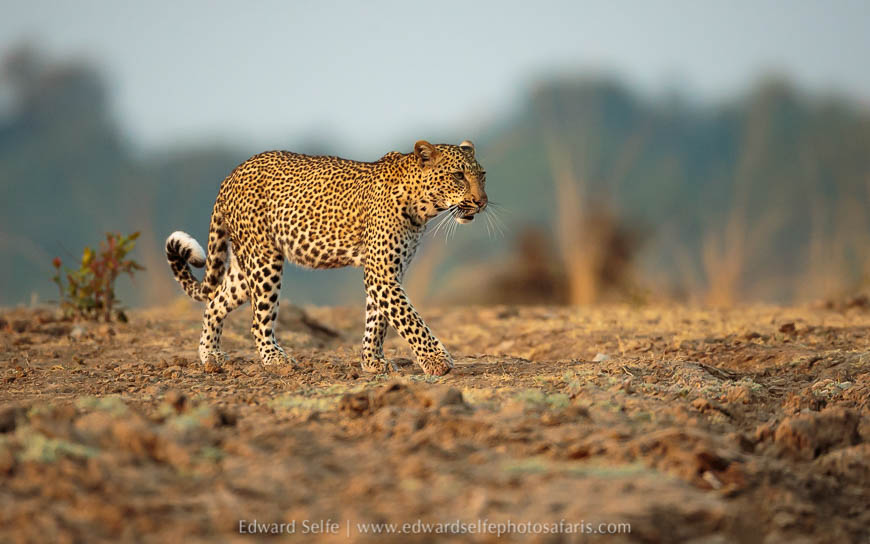
Early the next day, we were alerted to a leopard by barking baboons. But it was an usual situation as the leopard was still up in the tree with the baboons, having killed one of the troop! As daylight came, she was overwhelmed by the baboon troop and fled for cover, returning only in the afternoon.
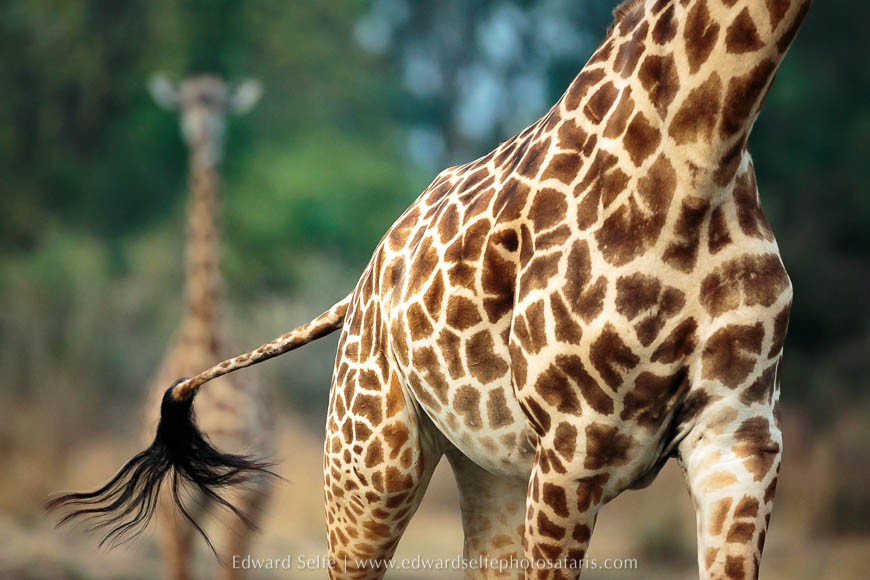
Giraffe abstracts one afternoon…..
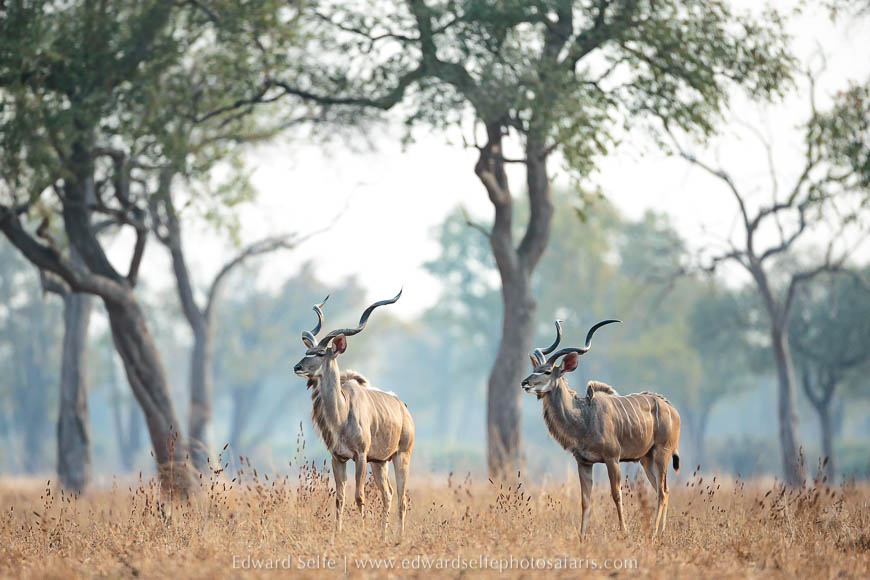
…and a very memorable time with greater kudu on our last morning before heading to Nsefu Camp.
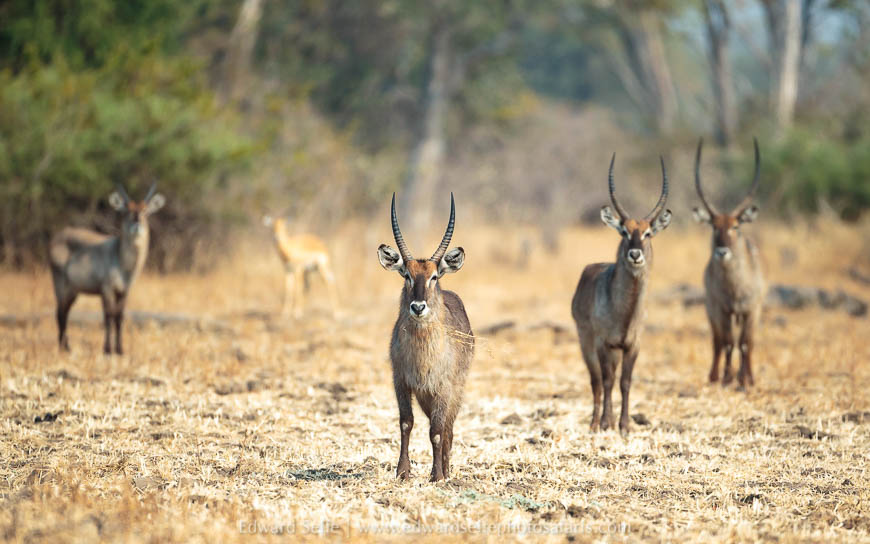
We had loved our time at Flatdogs Camp with the relaxed game, convenient meal-times (in that there aren’t set meal times in the camp!) and plentiful wildlife in camp. But we were ready to move on to the Nsefu Sector where we would be spending 4 nights at Nsefu Camp.
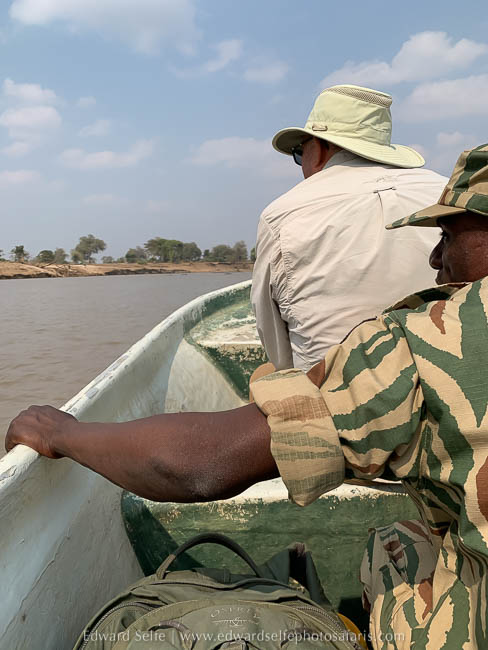
Crossing the river into Nsefu Sector.
I always love spending time in the Nsefu Sector and especially in the beautiful and game-dense areas around the Nsefu Camp. Prior to our arrival, I had been following the exciting news about the Milyoti pack which had denned close to the Luangwa river in the southern part of the Nsefu Sector. This was slightly unusual as wild dogs tend to prefer more secluded areas where there is a lower chance that their den will be discovered by lions or hyaenas. However, the adults were doing well and had reared a litter of pups, despite this apparent threat.
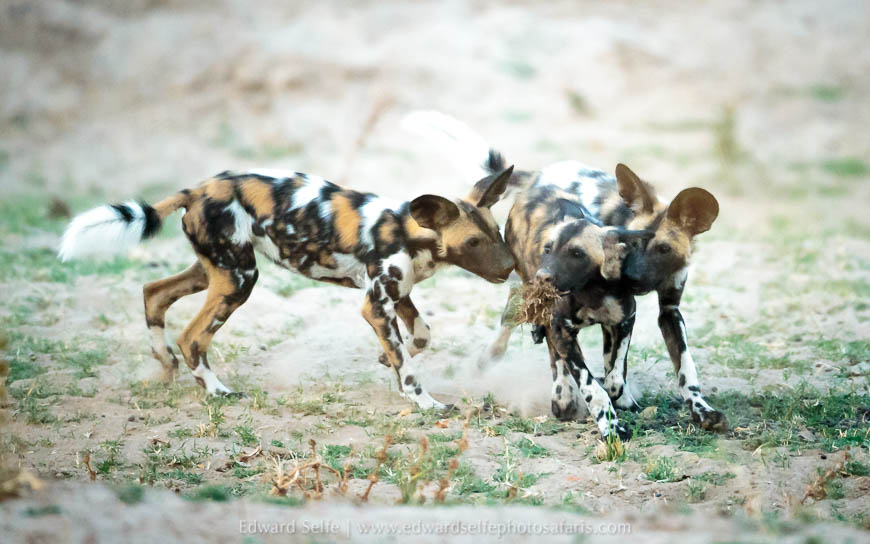
We were fortunate to find the pack just as they moved away from the den and went mobile with the puppies for the first time. I won’t easily forget the sight of the whole pack, coming down the road towards us in the dawn light, passing on both sides of our vehicle and then running through the camp as they hunted north along the river!
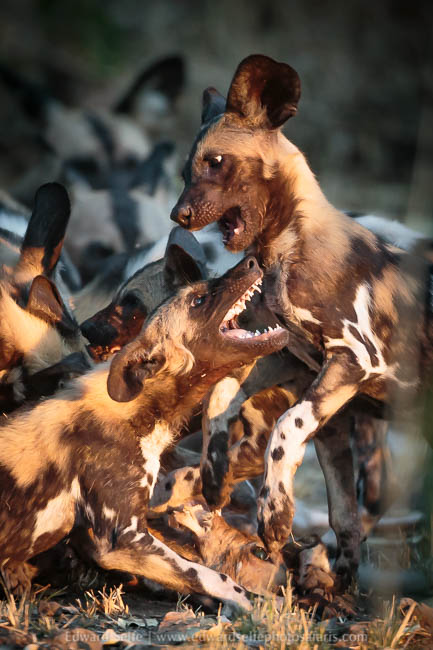
Because the pups were still very young (perhaps 4 months at this stage) they tended to hunt early and then hide up in very deep thickets during the day. Our encounters with them were therefore brief but always exciting, including finding them with a bushbuck kill one morning.
The light in the Luangwa in dry season is fantastic for photographers; very early in the morning, placing the light behind the subject creates a soft halo, especially around ‘fluffy’ animals such as baboons and waterbuck; later in the morning, side-lighting animals brings out the definition of animals’ shapes; and even late in the morning, the dusty light is soft enough to shoot as long as the light is behind the camera. With very experienced photographers as guests, we spent a lot of time on certain sightings, preferring to take a chance on creating something really special. We weren’t always successful, of course, but we had a lot of fun trying.
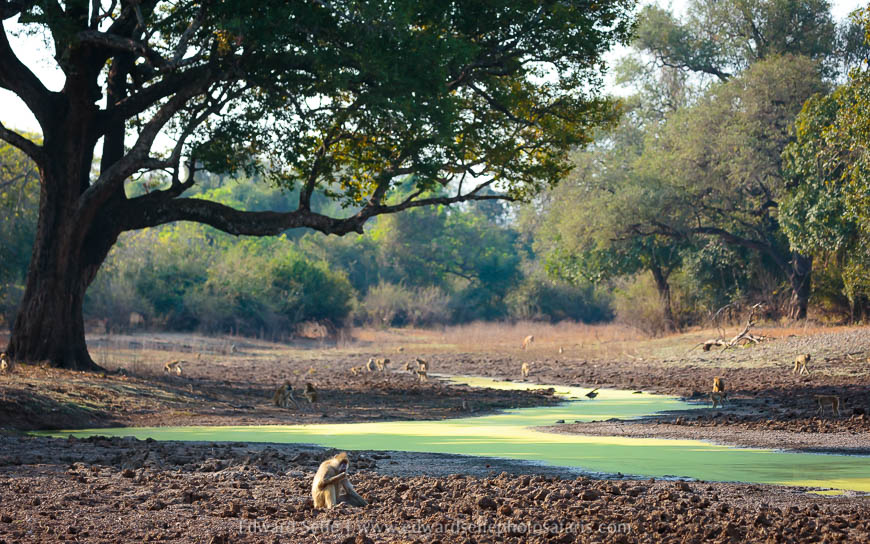
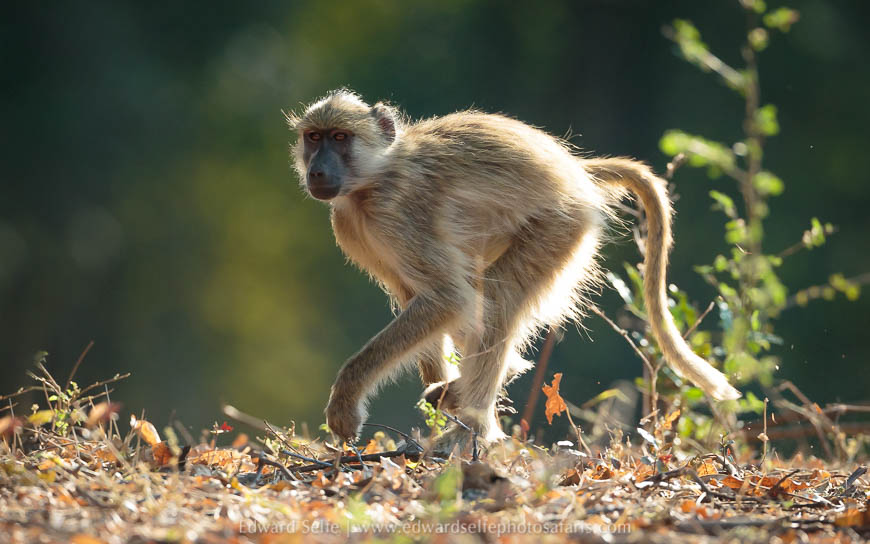
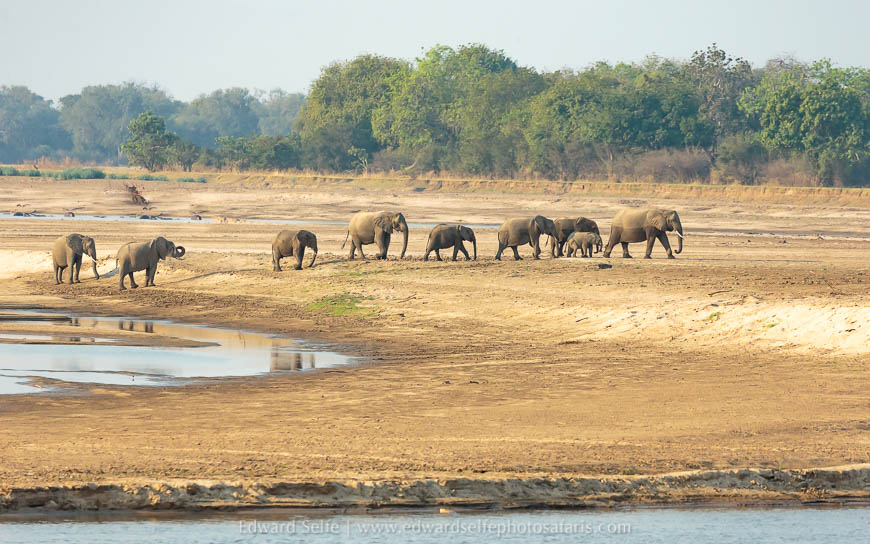
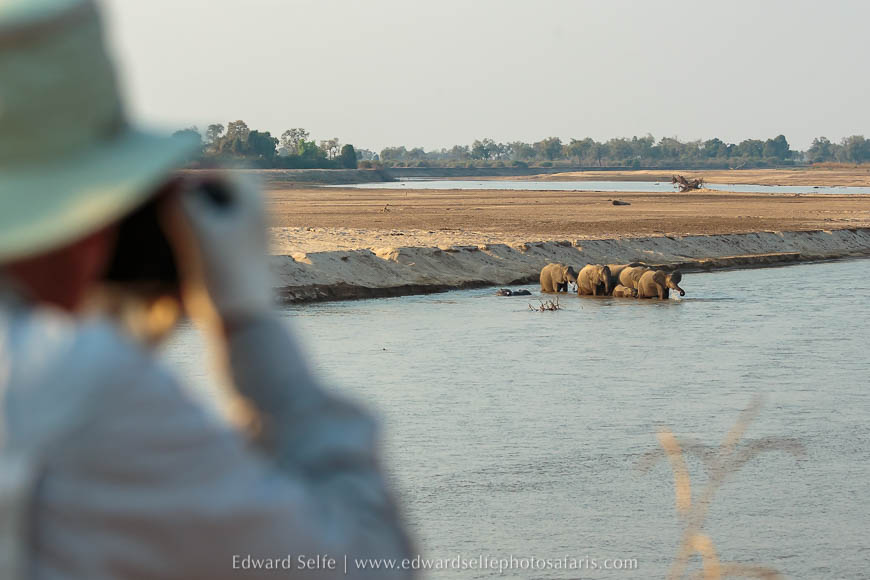
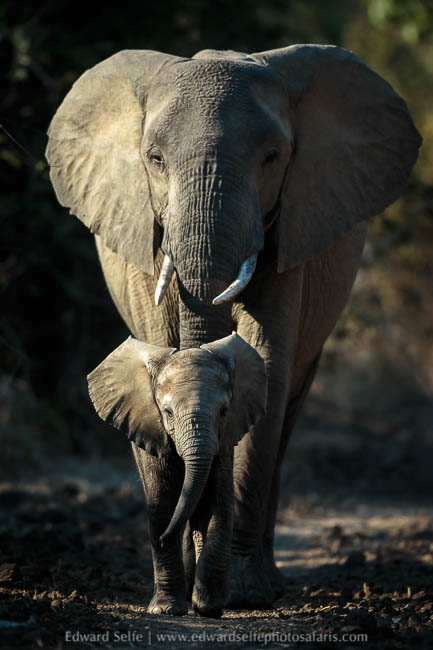
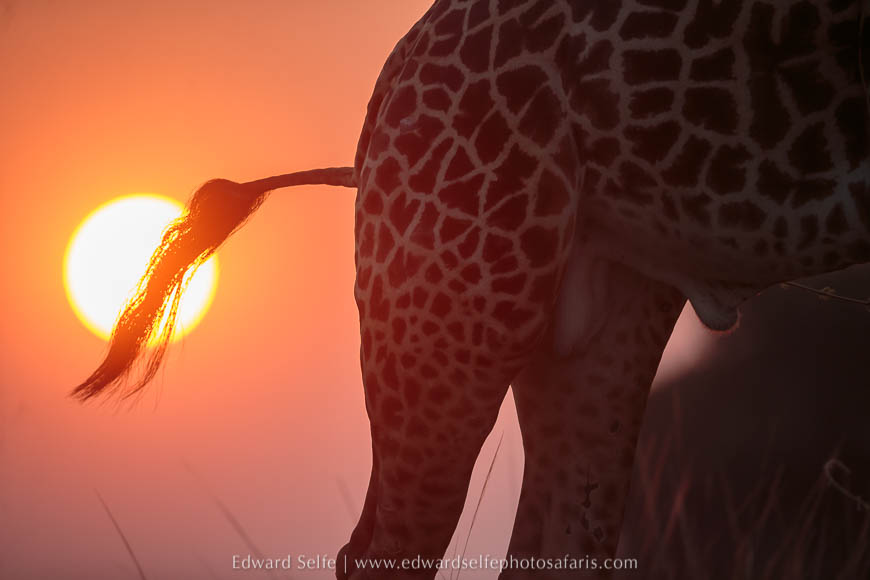
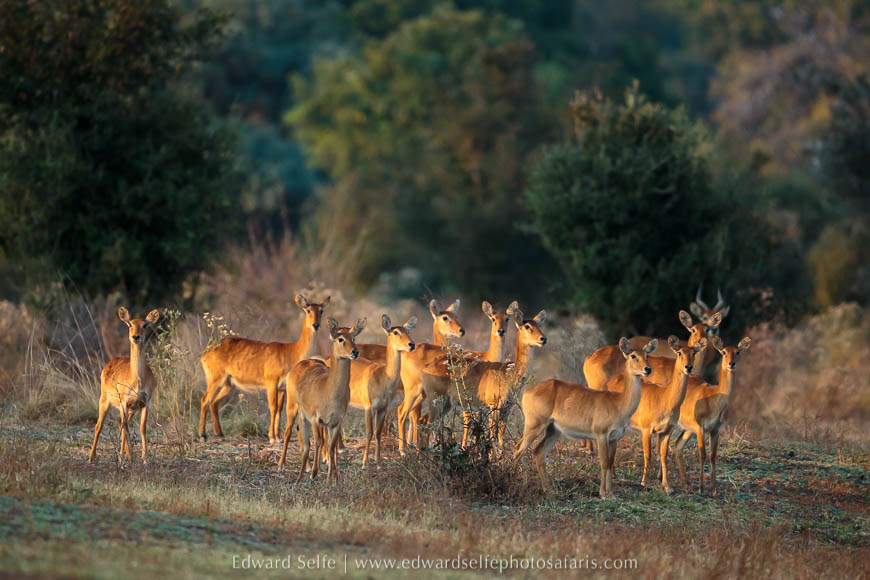
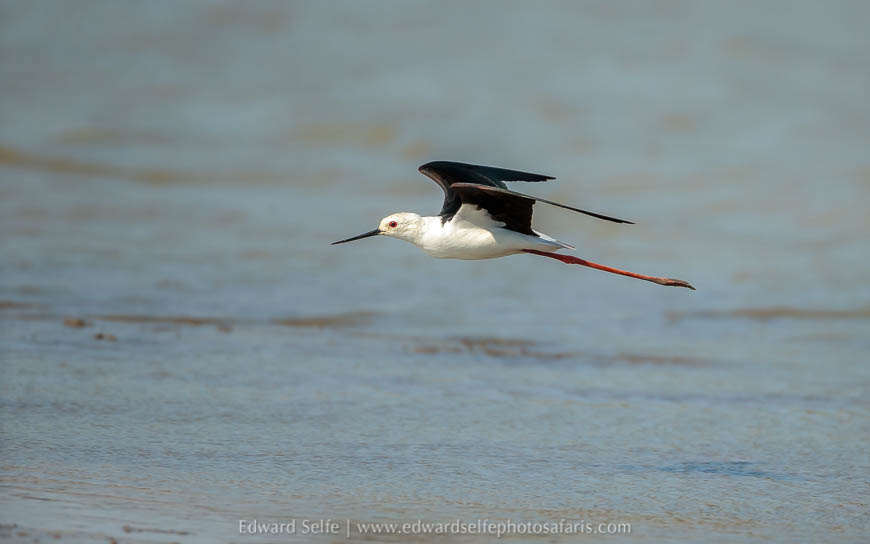
We enjoyed time sitting at the edges of the lagoons, soaking up the activities of creatures large and small as they drank, fed or competed for space. Alongside the resident waterbirds, such as Stilts and Ibises, we spotted some of the first returning migrants from Europe as the palearctic autumn begins.
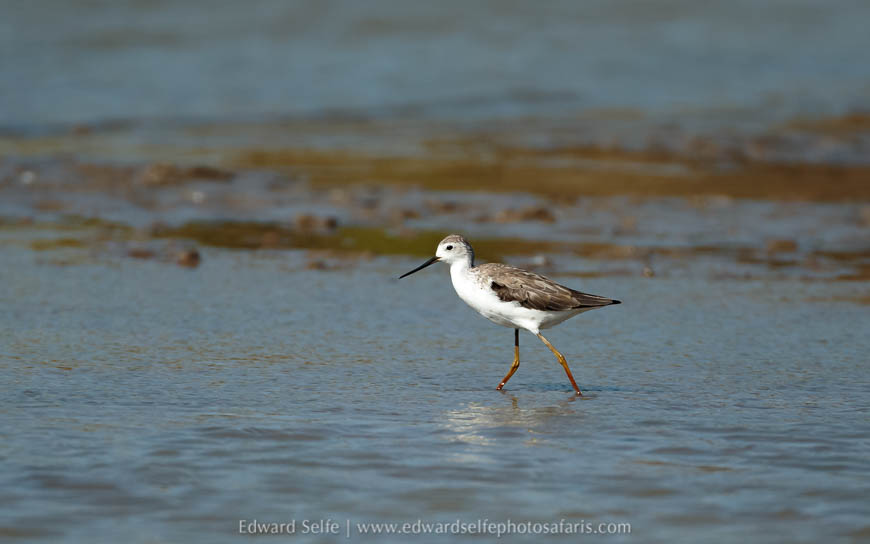
Marsh and Wood Sandpipers joined large numbers of Ruffs which appear to have migrated early this year as they are still wearing more of their breeding plumage than normal.
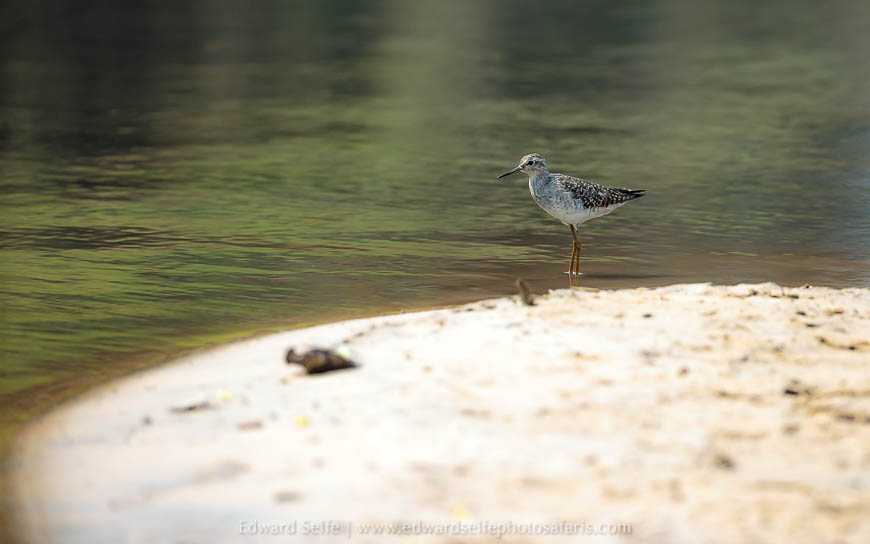
One particular morning, we went in search of Olimba, made famous by Will & Lianne Steenkamp’s Leopard Legacy film, and her two cubs. Some careful searching around the wafwa island revealed her male cub who was making the nearby puku very nervous.
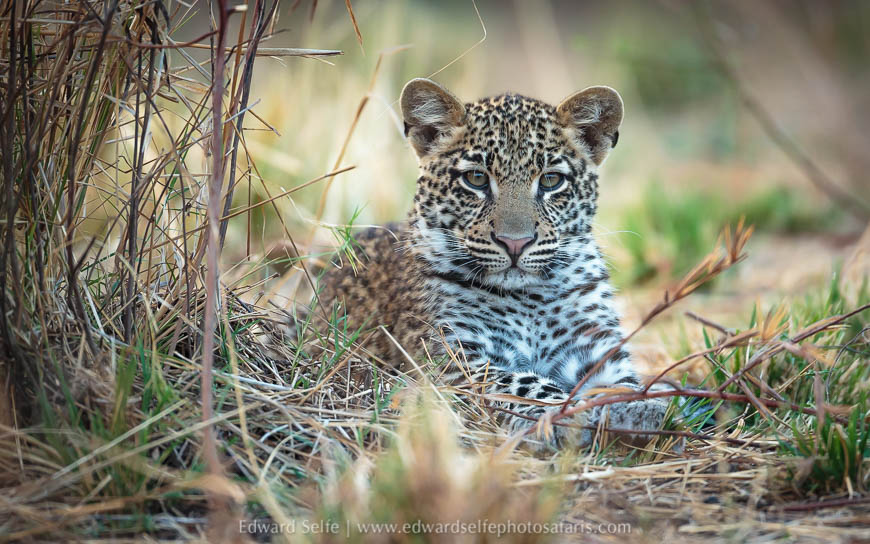
We spent over an hour with him and it was special to watch as his initial nervousness slowly eased and turned eventually to intrigue. Slowing the pace and taking time on sightings always pays.
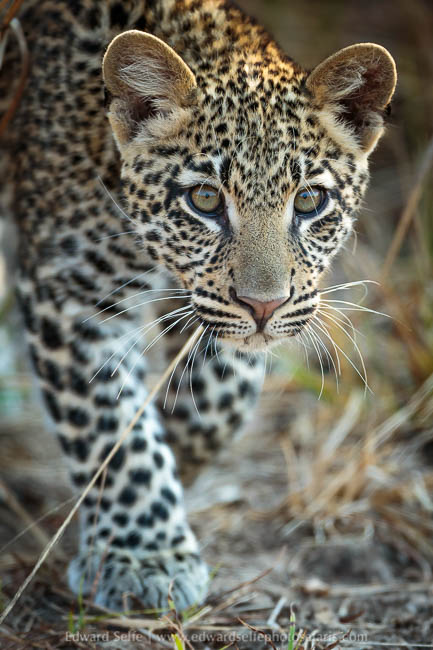
We wondered where his mother was so we drove carefully around the island and found a sausage tree which had a thick layer of flowers on the ground underneath. We presumed that there was a reason that they hadn’t been eaten by antelope and, sure enough, Olimba was resting on a high branch! It wasn’t a good spot for photos, but it was a great hunting situation, so we quickly moved on to allow her the best chance to catch something and feed her cubs.
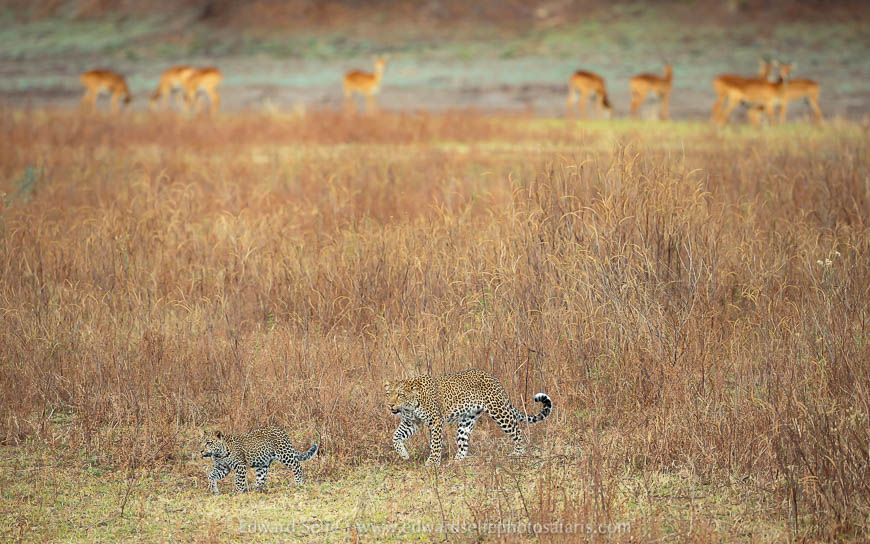
We were rewarded! In the afternoon, she had made a kill and seemed keen to go and get the cubs; this involved a short journey for her, but a long one for us as we had to cross the Croc River in two places. So, much as we wanted to see her collecting her cubs, we decided to sit tight and wait for her to bring them across the floodplain towards the kill.
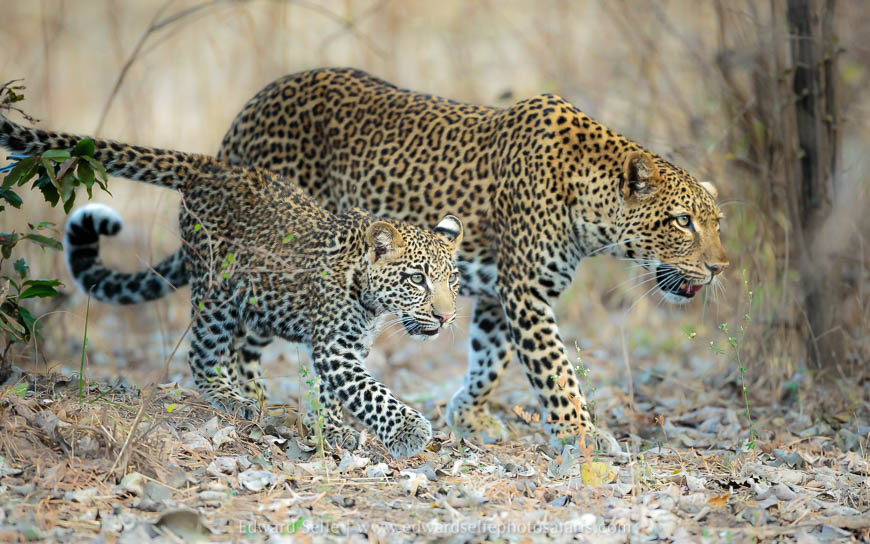
Once again, we were lucky because she first collected the male cub, and then retraced her steps to collect the female, giving us the chance to capture the scene twice….who says you never get a second chance with nature photography!? After wonderful time with them, we left as it grew dark, not wanting to attract hyaenas or lions to the kill.
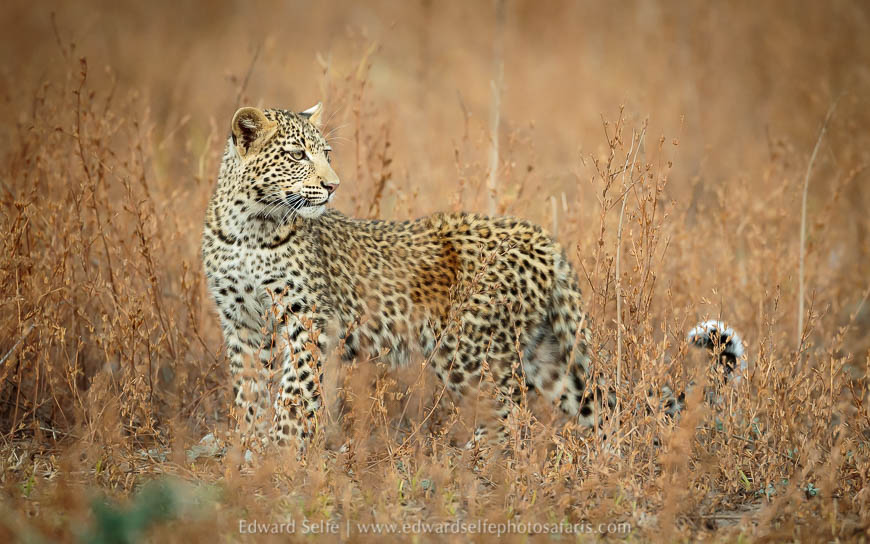
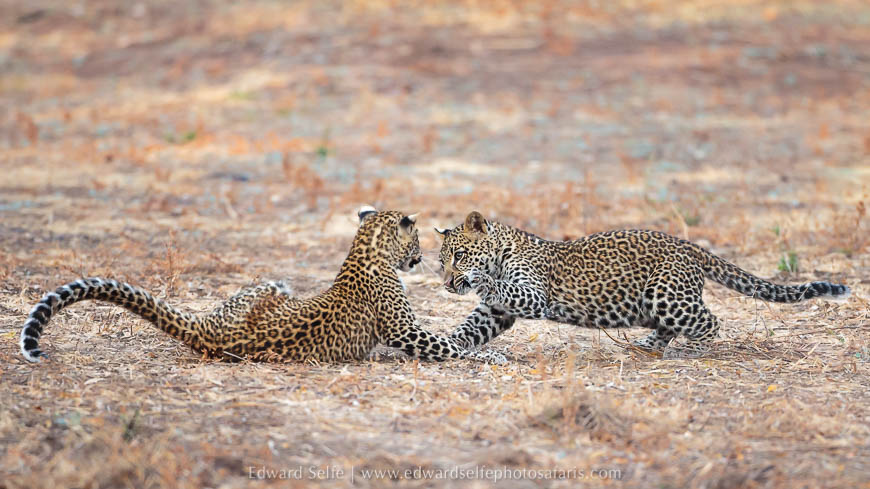
The following morning, we found the cubs playing close to the site of the kill and Olimba still guarding what was left of the carcass. They had done well not to lose it in the night.
(I learned subsequently that Olimba’s male cub was killed by lions a few weeks later. While this kind of rivalry between predators is common, it is still very sad, and highlights the challenges that even mothers or predators at the top of the food chain face in raising young in the bush.)
The river was high this year, and the inland water of the Croc River was still flowing until August, so game is more dispersed than normal for September. This meant that the Hot Springs, an inland natural water source, did not attract the game that we normally find there. However, it is still a beautiful area and we enjoyed kudu, Crowned Cranes and waders at the source of the spring. We also had a true sundowner (at sundown time) which is a rare event for photographers as we usually continue photographing until dusk!
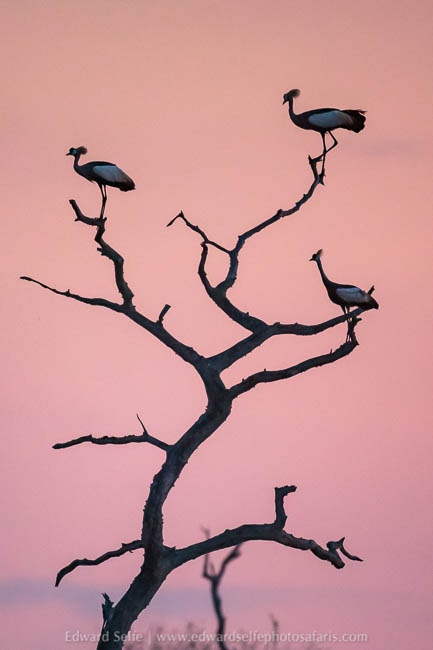
Increasingly, the measure of luxury on safari is the exclusivity of the experience. Whenever I visit the Nsefu Sector, I know that I will enjoy wonderful sightings and I’ll be able to help my guests create stunning images without having to plan around other people. This is increasingly rare and I am always grateful for it.
After 4 nights, we were excited to move on to Lion Camp, a camp that my guests always love in a wonderful part of the National Park. While our sightings had been great so far, we were looking forward to seeing more lions, and knew that Lion Camp would offer this!
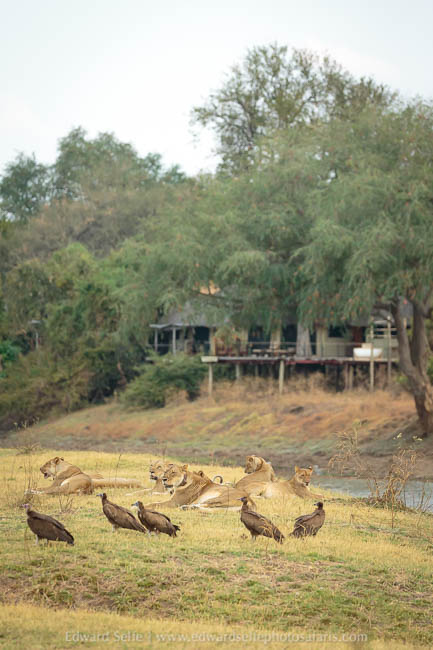
Well that didn’t take long! Arriving at Lion Camp, we could see lions on a kill in front of the camp. The previous night they had taken down a buffalo, causing a lot of noise and most of the guests to miss out on sleep….but surely for a good reason!
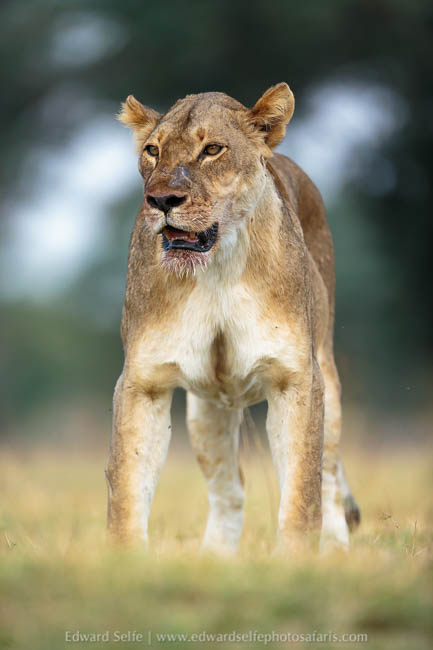
We parked in the bottom of the gulley where the road crossed and spent time at eye level with these well-known lions. The different impression that one gets of the size and power of lions from this angle, compared to looking down from a safari vehicle, is dramatic.
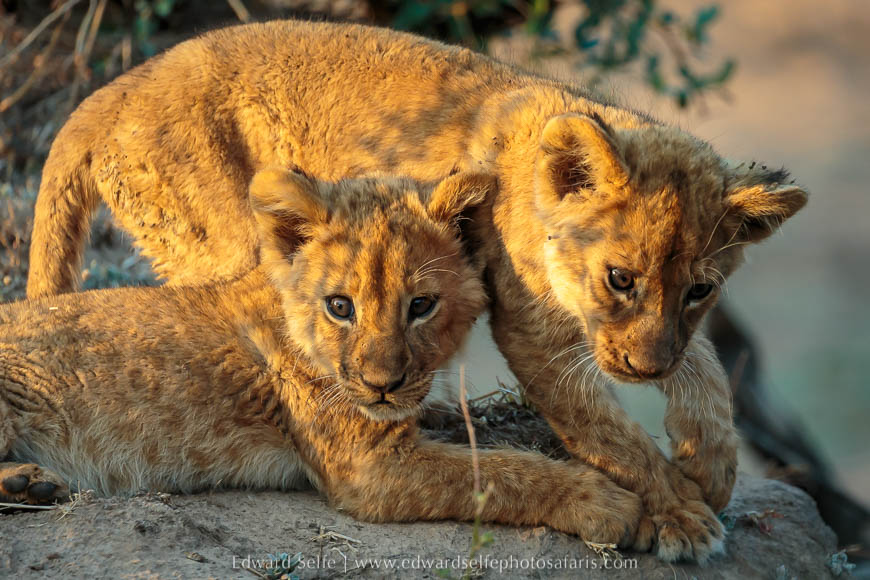
But we weren’t done with lions for that day. On the way in to camp, we had seen the MK Pride near Lion Camp and, amongst all the sleeping bodies, we could see 4 little cubs. We decided that cubs took priority….and this was the scene that greeted us on arrival!
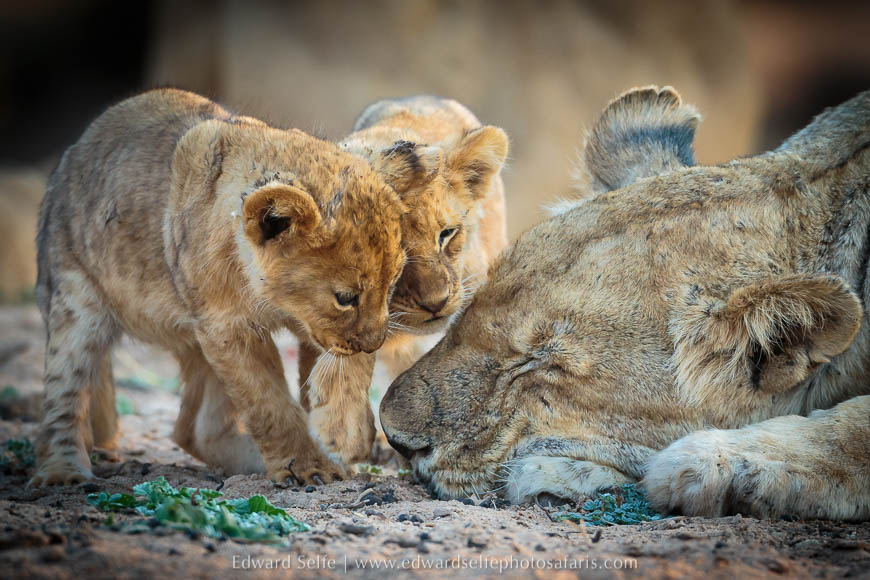
As the cubs roused, they tries to wake the adults, who were much less keen to get up! These tiny cubs are just 8 weeks old and had been introduced to the pride just 2 days before.
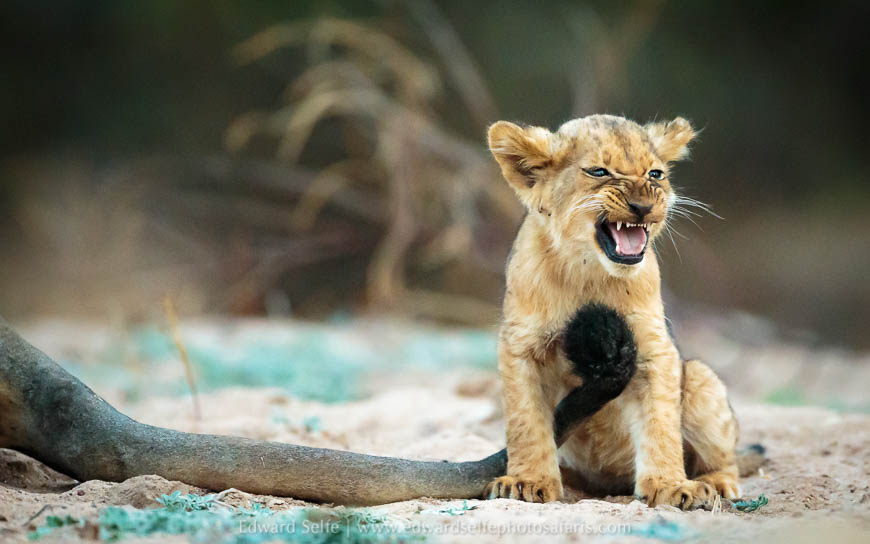
Eventually, they settled for playing with tails, the only part of the adults which seemed to be showing any signs of life!
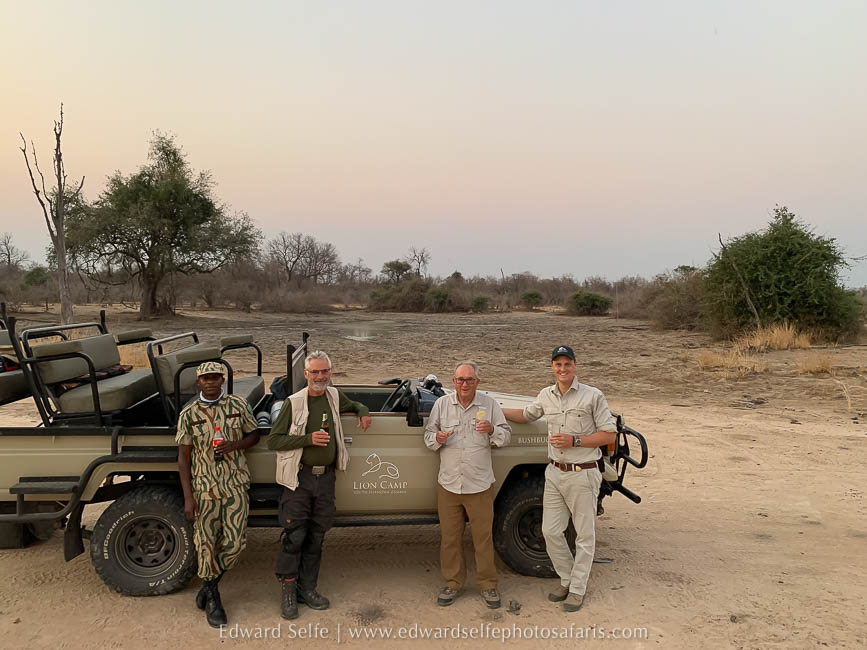
After such a successful afternoon, we decided to celebrate with a short break just after sunset and asked Wayne from Lion Camp to take some photos!
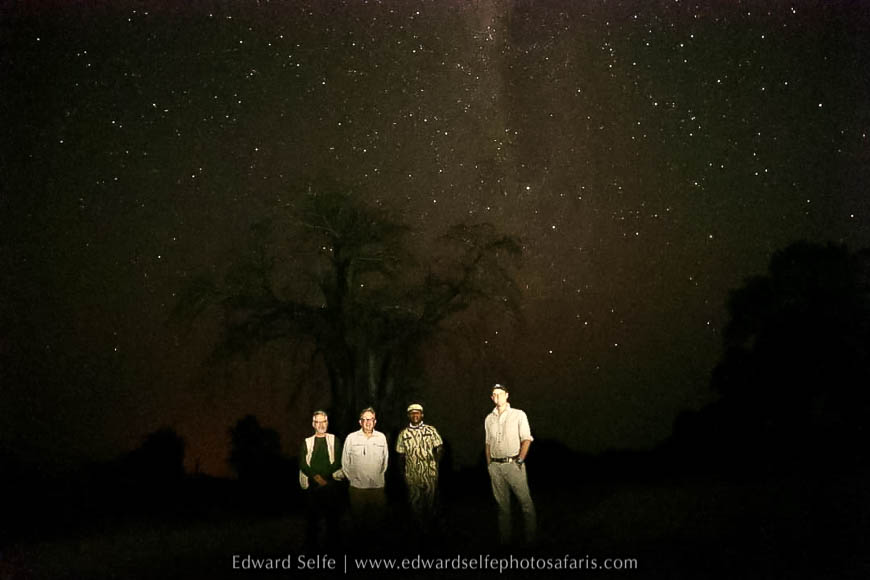
Wayne then joined us when we went to photograph stars that night and we set up this cool shot of the 3 of us and our scout Stuart from the Dept for National Parks.
Our time at Lion Camp gave us perhaps the best sighings from Luangwa; here come some of the most memorable:
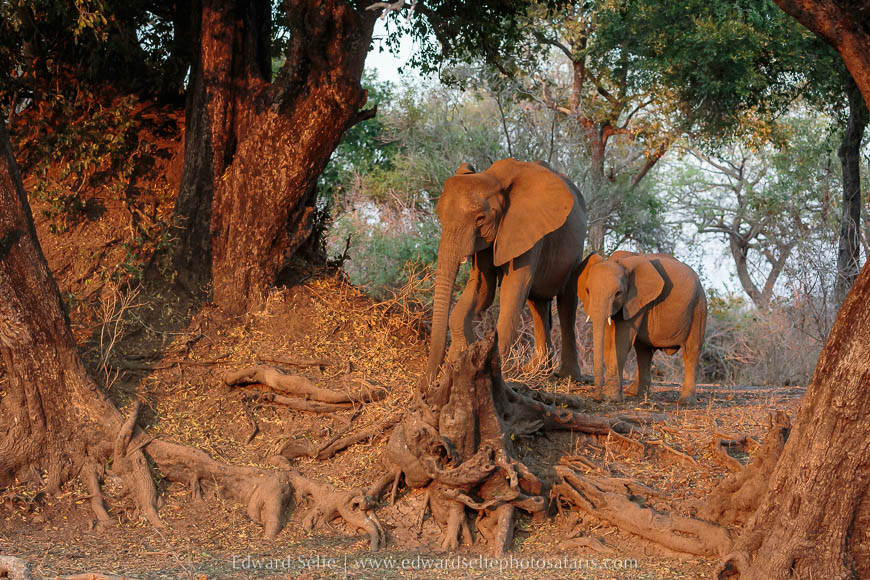
Beautiful pink/gold light on a elephant and her calf just after sunrise one morning.
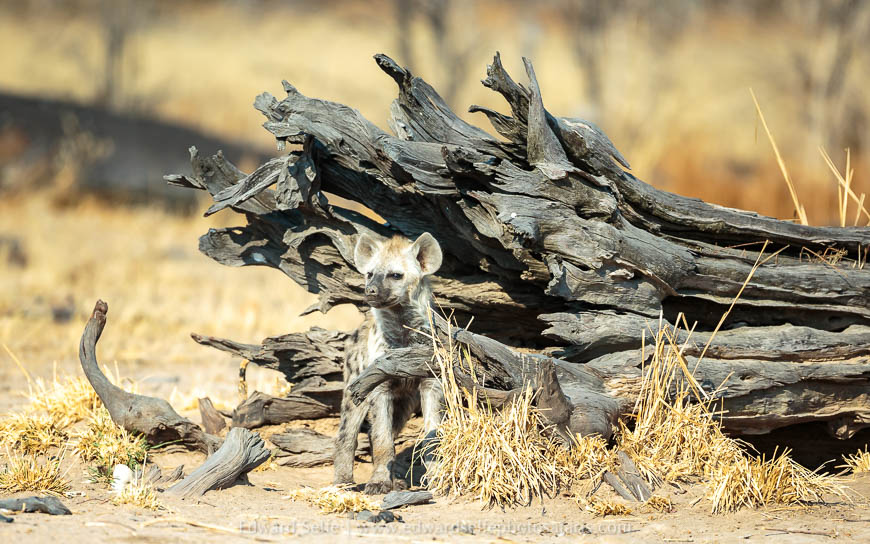
A clan of hyaenas were using a fallen Mopane tree as a den site; two youngsters were resting nearby while the adults were out, or resting in the shade nearby.
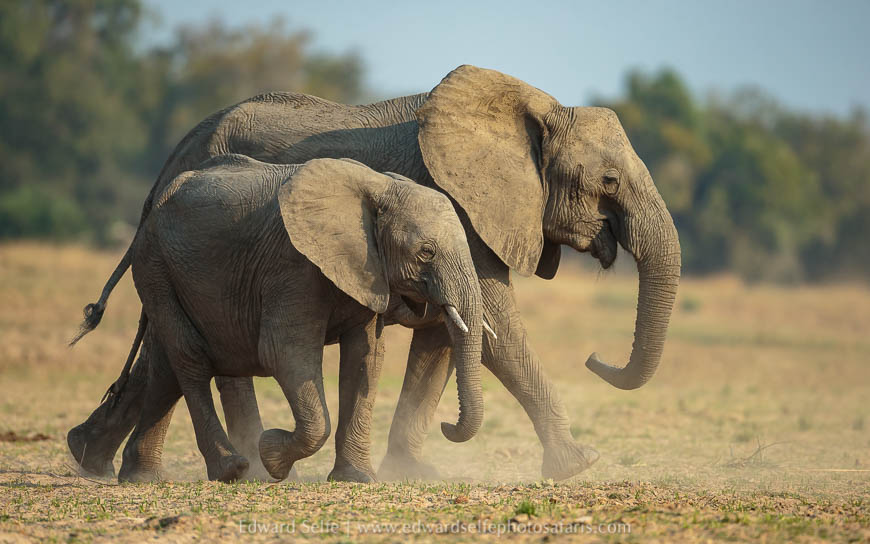
One of the days brought a significant increase in temperature and with it some haze and smoggy weather. The light was heavily diffused but very good for shooting late into the morning.
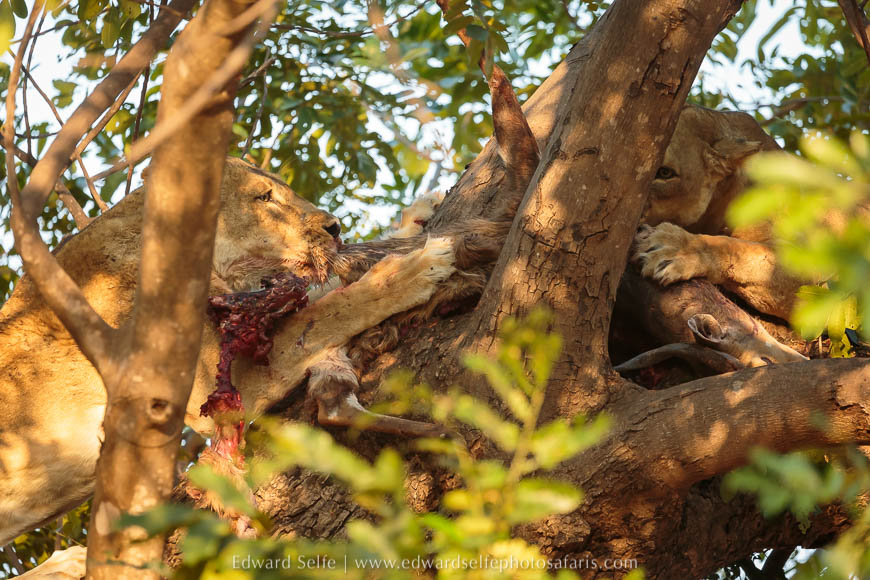
Late one afternoon, we went in search of the local lions which we had left in one spot that morning. We couldn’t find them initially, so we scouted around until we saw one at the base of a tree. I approached, and then saw that the ones on the grounds were looking up……
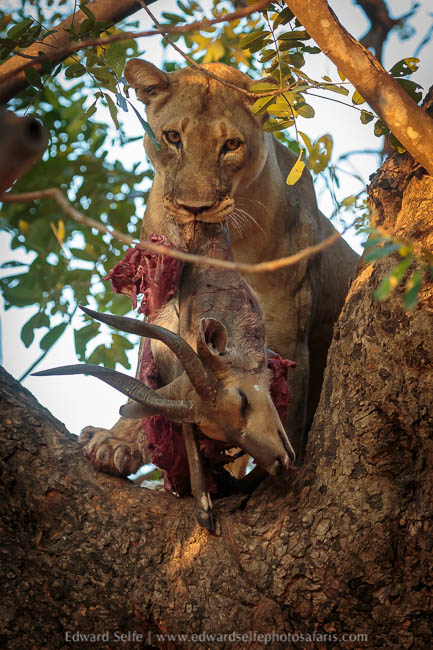
Two lionesses were up the tree, fighting over a bushbuck carcass which they had clearly stolen from a leopard…..!
I looked up into the higher branches to see if the leopard was still there, but couldn’t see it, so we carried on watching and photographing the lions. However, in fact, the leopard was still there, but was hidden from where we had parked. Without warning, he decided that he was not enjoying the attention he was getting from 10 lions and a vehicle with 4 people on board and leaped from the branches, dropping around 4 meters to the ground and disappearing into the bushes. Several lions chased him and he climbed another tree that was vertical for the first 5 meters with no side branches…an incredible feat! We tried to follow but he was, not surprisingly, fairly upset about losing his kill to 10 lions so he didn’t hang around for photos!
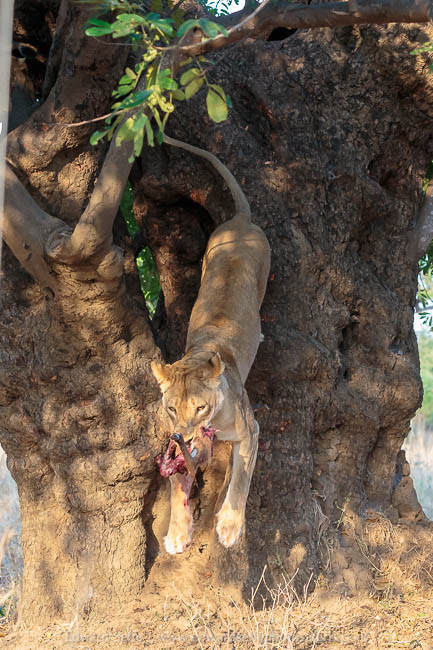
We returned to the lionesses in the tree and waited for a while. In the end, the remaining female became uncomfortable and dropped from the lowest fork with part of the carcass in her mouth. She was set upon by the others, keen to take their shares! It was quite an afternoon, to say the least!
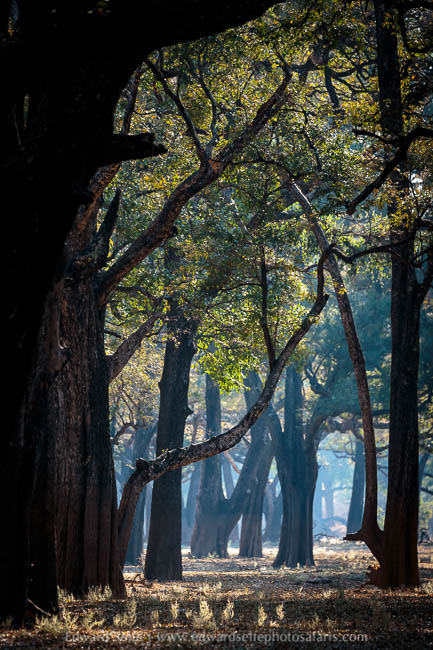
As always, we spent time in the ebony grove….
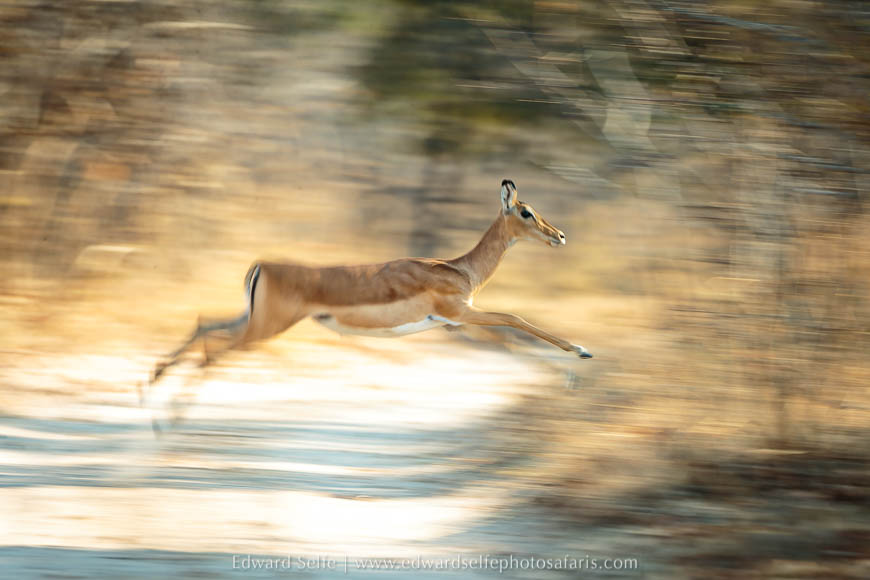
…and playing with light, panning, zooming with long exposure…
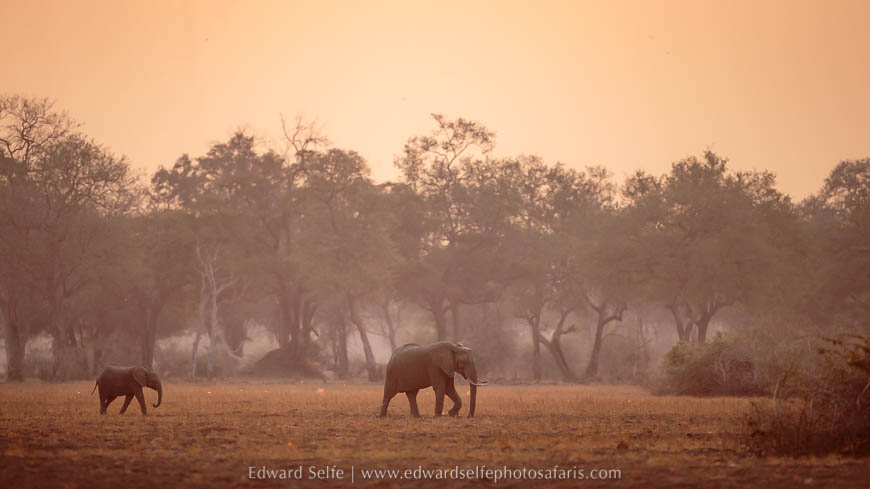
…and enjoyed sightings of all kinds in every possible lighting scenario.
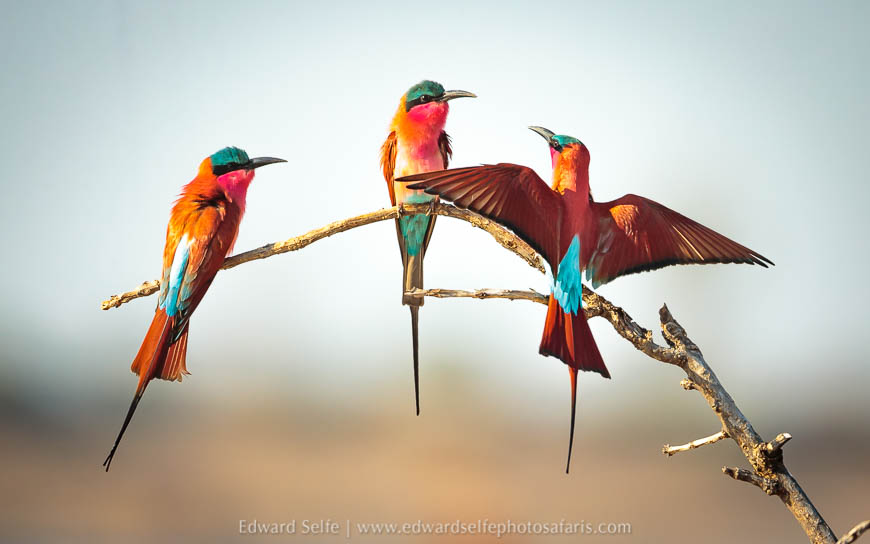
A fallen tree was a perfect spot for carmine bee-eaters to rest above the cliff that hosts their long burrows.
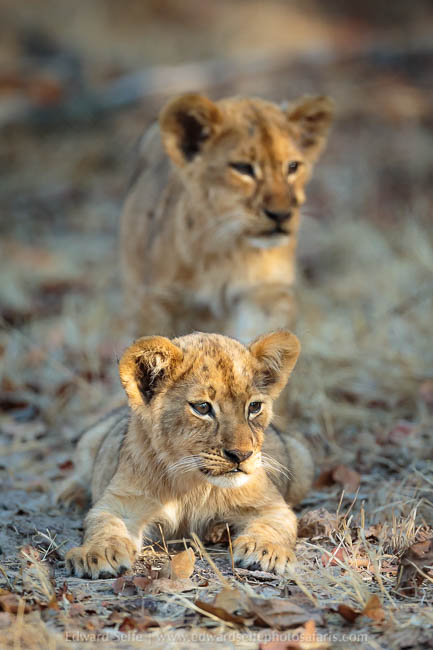
On a particularly memorable morning, we spent time with 4 lion cubs, all born to the same mother, which is quite unusual, in Luangwa at least….
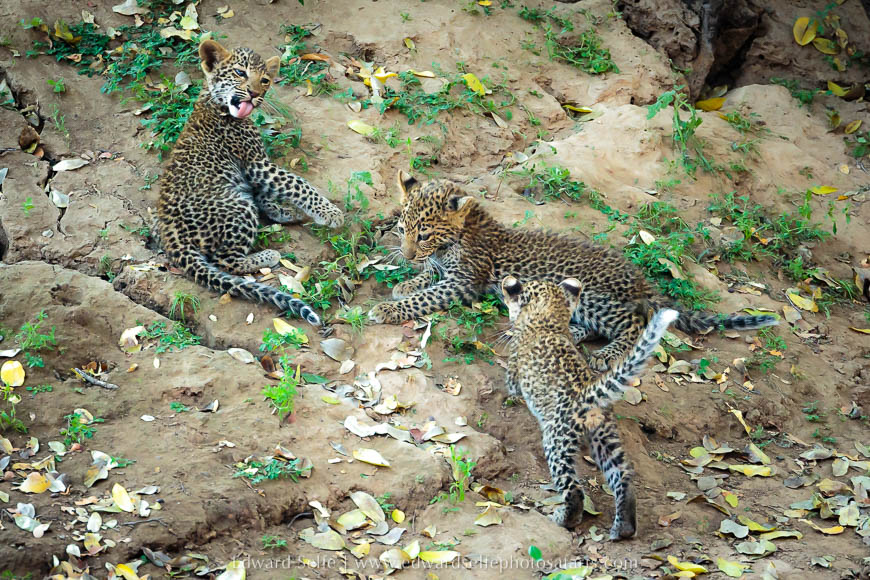
….and with 3 leopard cubs who played non-stop in the dried-up Kamima stream bed.
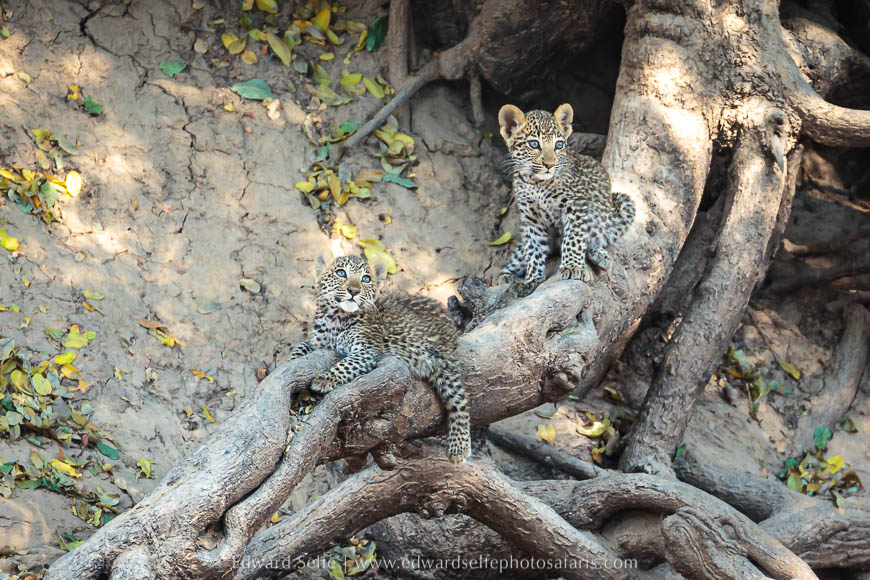
The 3 rarely played together at the same time, so we only got a few photos of them all, but we had hundreds (perhaps thousands) of shots of two playing. We wanted to be closer, and we wanted to change the angle, but the terrain wouldn’t allow it and there are times when a sighting (not to mention the subjects) are just too valuable to risk moving or trying to get a different perspective. We were just thankful for the chance to see such a special sighting and we took the photos we could get…..and spent a lot of time just watching!!
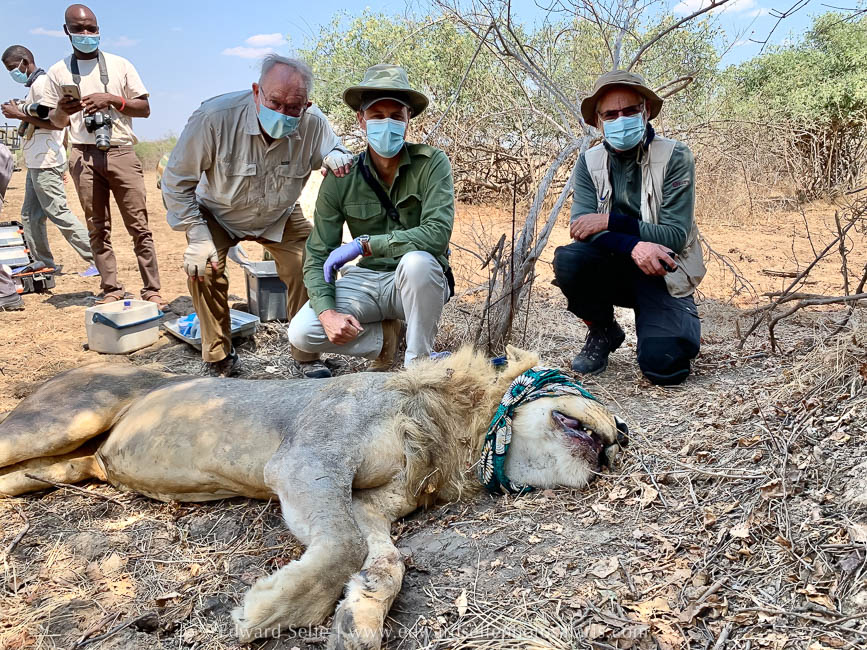
Later that same day, we were fortunate to be present at the darting and treatment of a large male lion who we had been watching over the previous 3 days. He had seemed very lethargic and then his lip and gum started to swell. We reported to Conservation South Luangwa, the Department for National Parks and Wildlife and the Zambian Carnivore Programme and they came to check on him. After examination, it seemed he had sustained an injury while hunting or fighting and it was a natural cause so nothing to be worried about, but we were happy to rule out poison or a natural soil-borne pathogen. He got some antibiotics and the wound was cleaned and he’s made a full recovery.
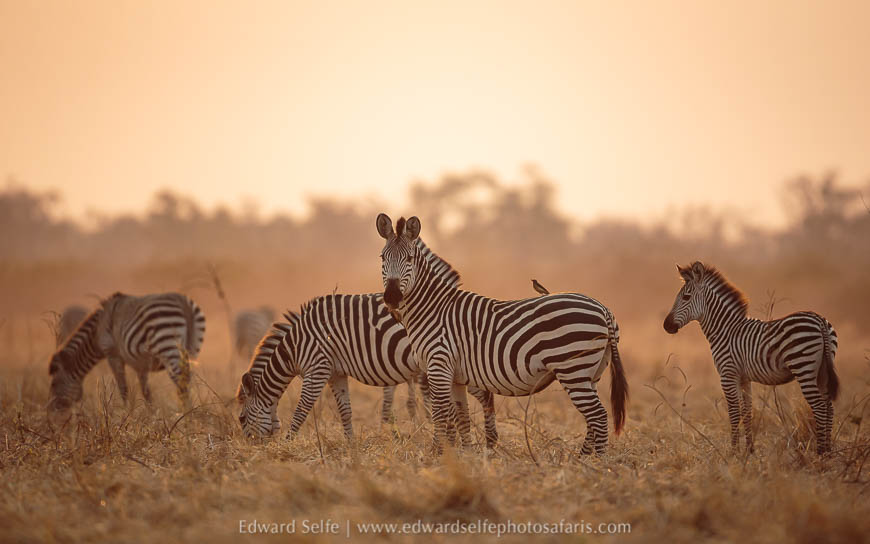
With so many predator sightings in the time we had been there, we decided to go looking for zebras and buffalo on our last morning. The light was spectacular on the plains and we found both a large herd of buffalo and lots of zebra scattered across the area.
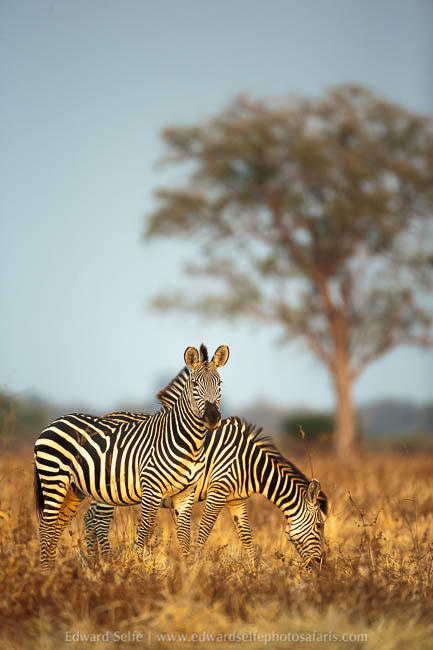
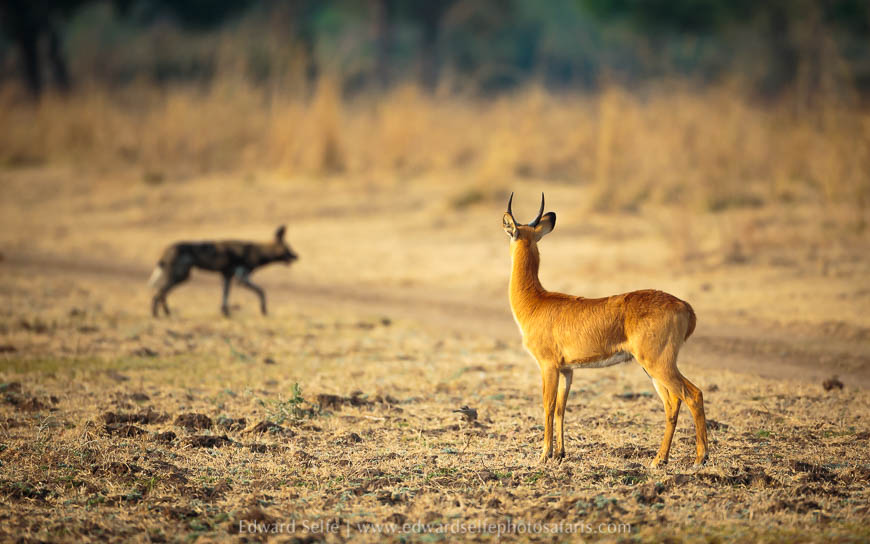
As is often the case when you stop looking for them, predators were still there to be found. A single wild dog (an unusual sighting) was terrorising antelope on the shelf in front of Lion Camp, and was then being chased himself by baboons who did not care for the threat he posed to the youngsters!
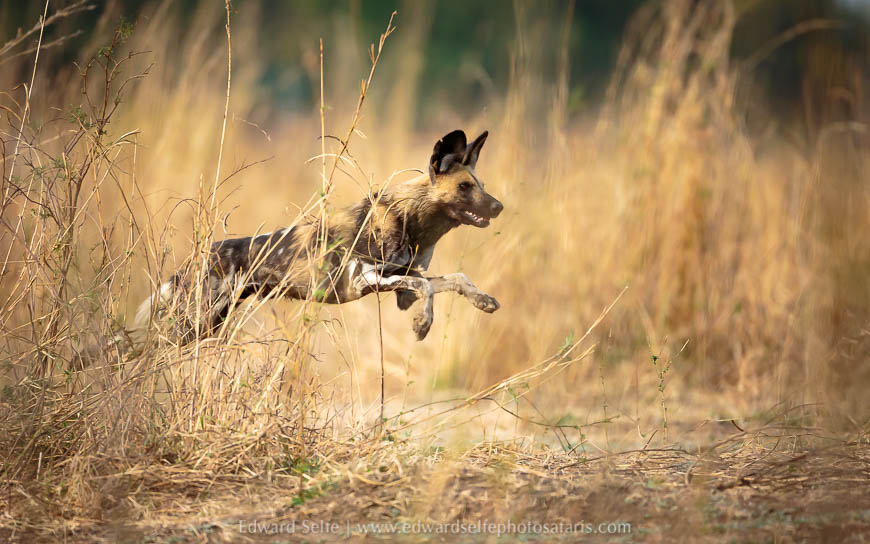
He evaded the baboons and chased more antelope, eventually catching a bushbuck in deep thickets.
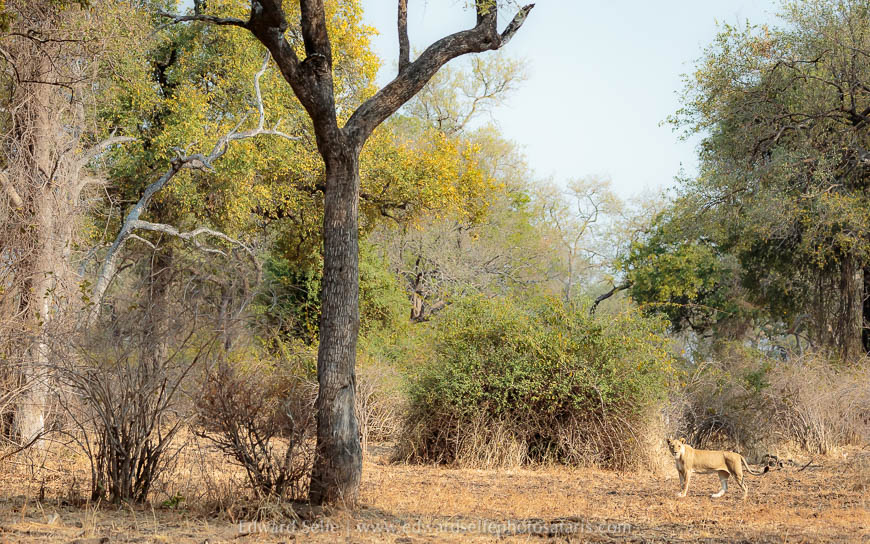
At the end of the morning, we found the Lion Camp lions in a mature forest…there is something special about the Luangwa scenery, and the chance to see lions in woodland!
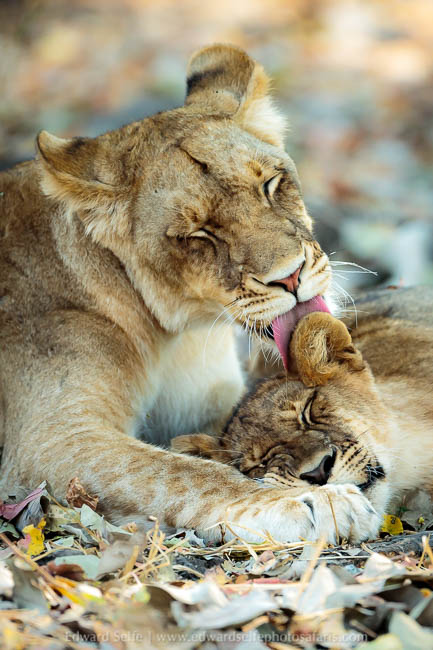
The lions were settling down and grooming each other, so we left them in peace and headed back to camp, ready to start the next part of the adventure in Lower Zambezi National Park.
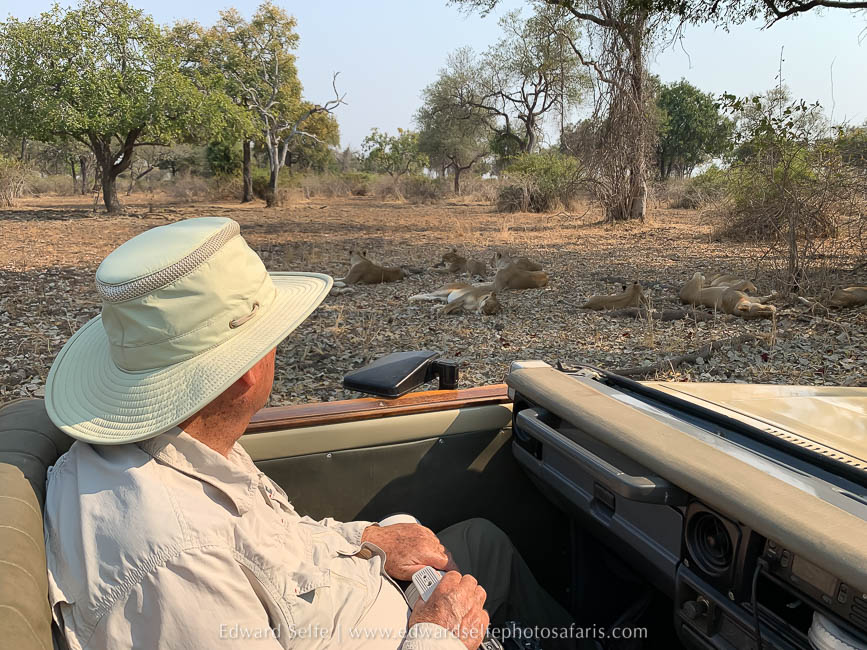
Kent soaking up some memories…
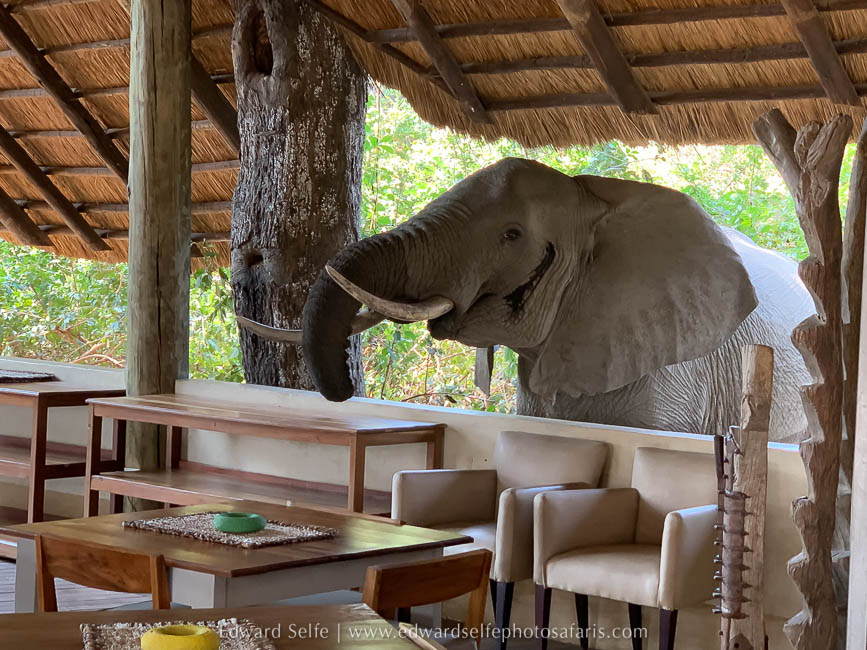
We arrived back to camp to find that breakfast had to be held somewhere different as the resident camp elephant was threatening to eat the fruit salad!
We caught an afternoon charter flight from Mfuwe in South Luangwa to the Lower Zambezi; it was hazy and smoggy, due to a temperature inversion, and the views from the aircraft were somewhat limited…but we knew that the haze would contribute to soft light on the ground so we didn’t mind too much!! We settled in to Sausage Tree Camp and chatted with excitement about the 4 days of safari that we had coming up. As before, here are the highlights and memorable sightings from the Lower Zambezi!
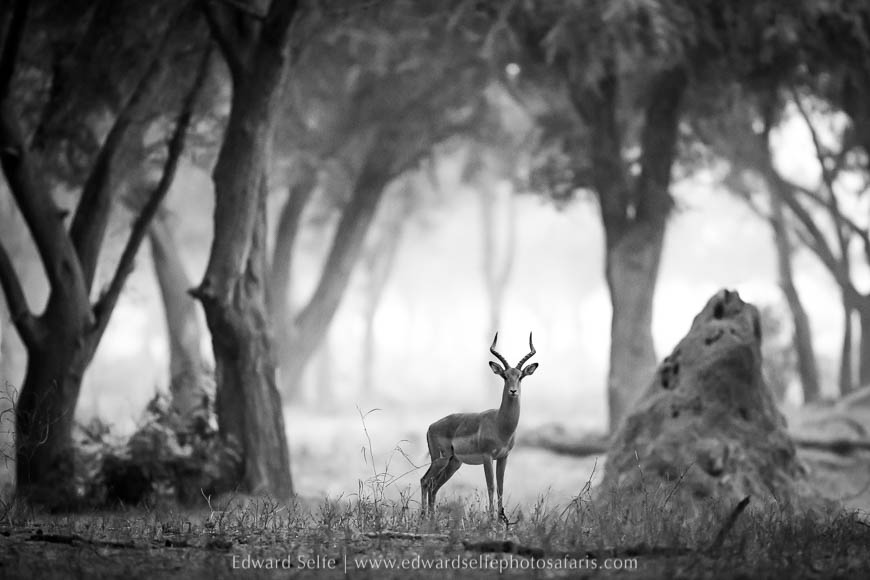
We left camp very early on our first morning, scouring the thickets with a spotlight for predators still moving around. There was word of a leopard with 2 cubs on a floodplain nearby so we went to that area hoping to track her down. She wasn’t around at that time, so we enjoyed the incredible scenery as the light started to improve…
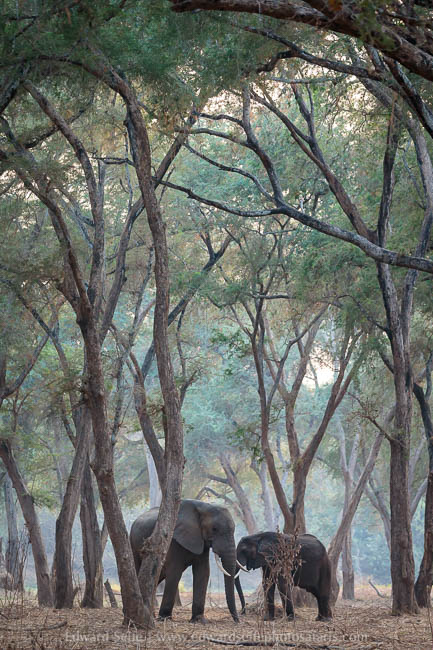
Elephants, dwarfed by their surroundings, among the winternthorns of the Zambezi floodplain.
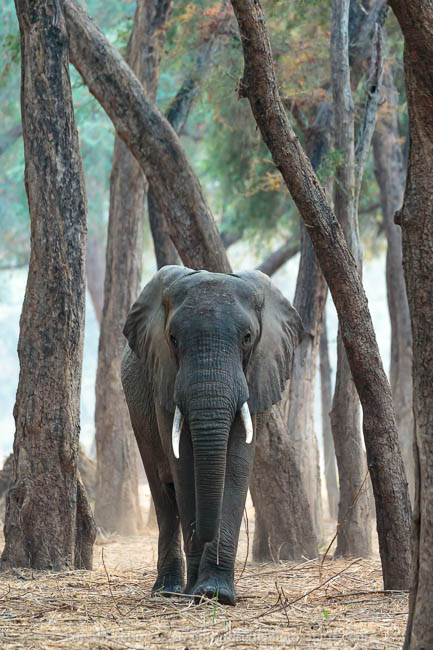
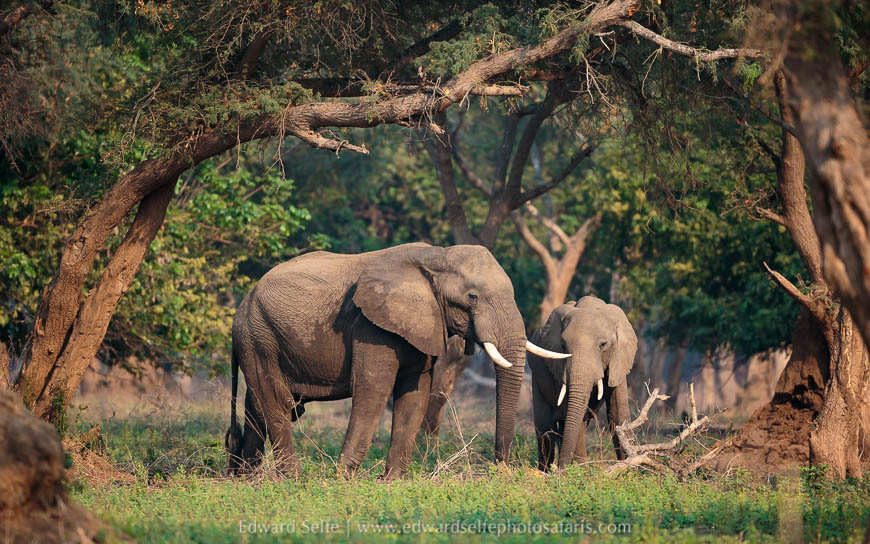
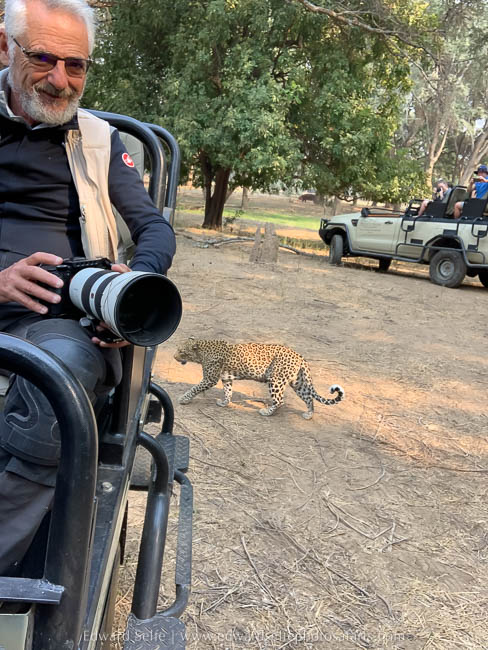
Eventually, the female leopard did turn up, and wandered around the floodplain apparently looking for the remains of a kill which she had stashed the night before. Perhaps scavengers had finished off what was left!
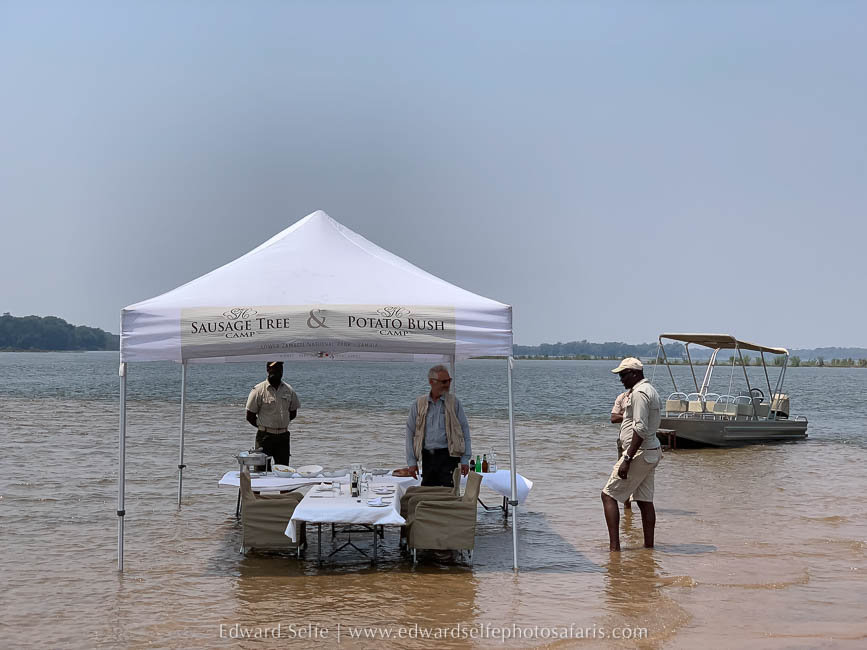
We have all heard of bush lunch, but a river lunch is something quite memorable… Imagine being dropped on a sandbar with 6 inches of water flowing over your toes while you enjoy a delicious lunch!
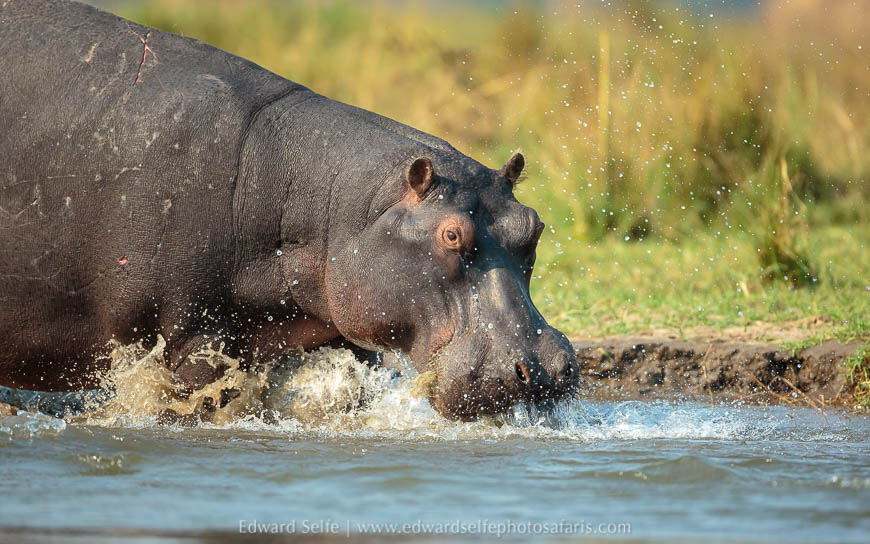
In the afternoon, to avoid the intense heat of the September day, we took a boat cruise on the Zambezi. This is by far the best way to photograph hippos and a multitude of birds….
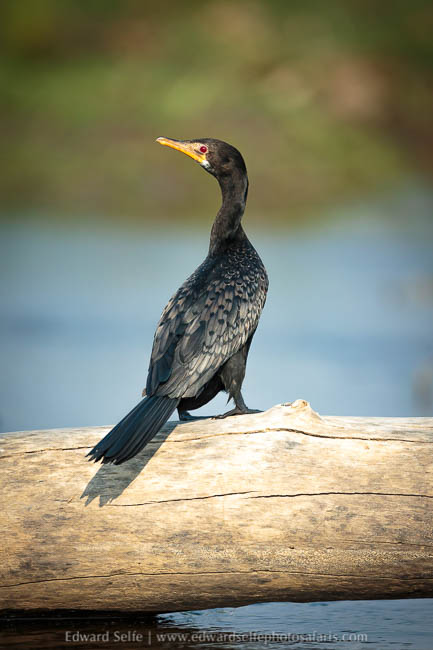
…such as reed cormorants….
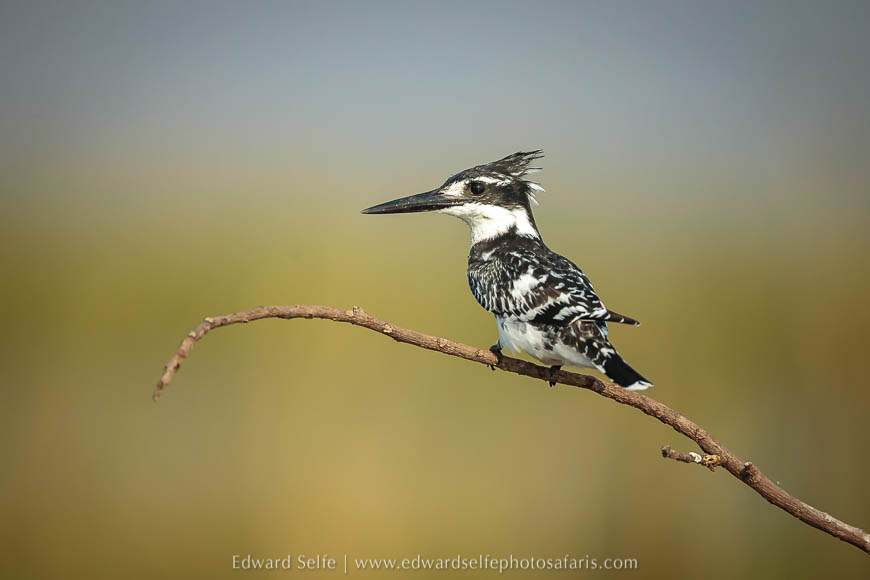
…pied kingfishers….
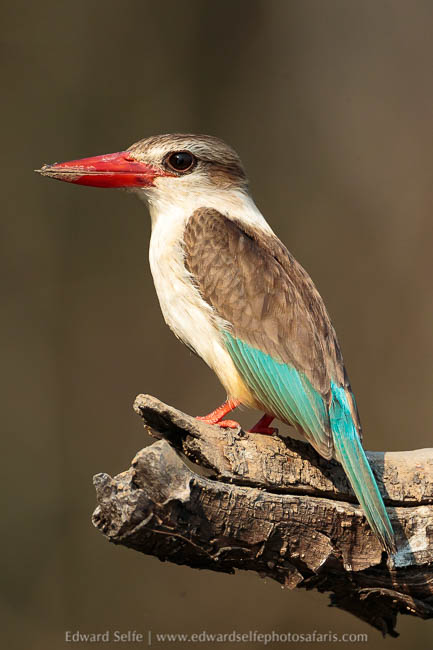
…brown-hooded kingfishers…..
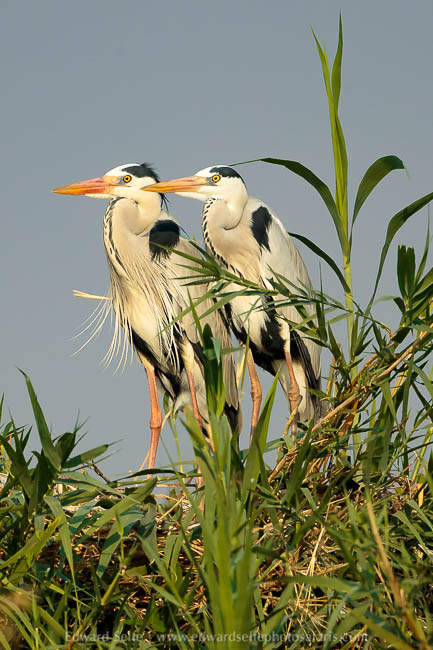
….grey herons….
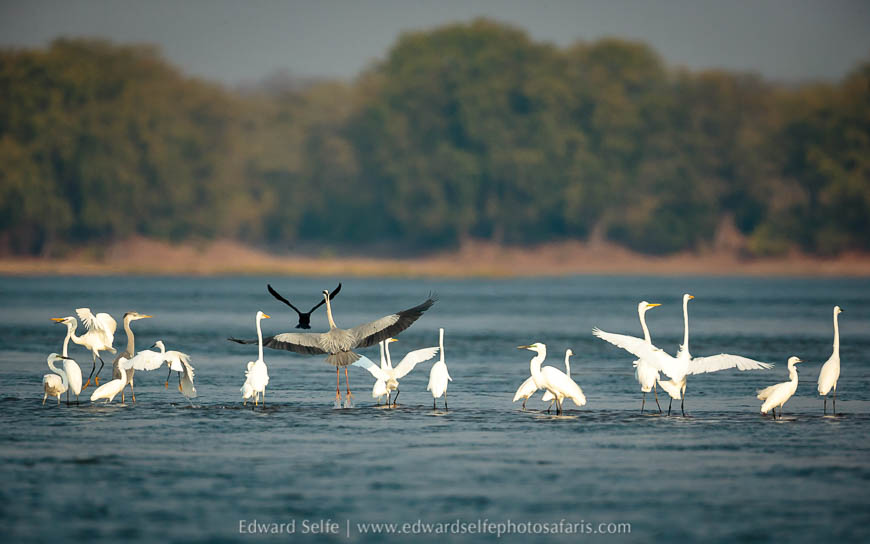
…and a variety of egrets!
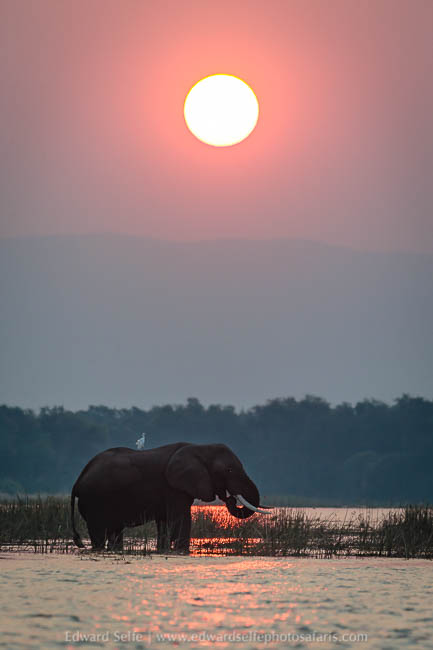
And there is little to compare to a Lower Zambezi sunset with an elephant feeding on a small island.
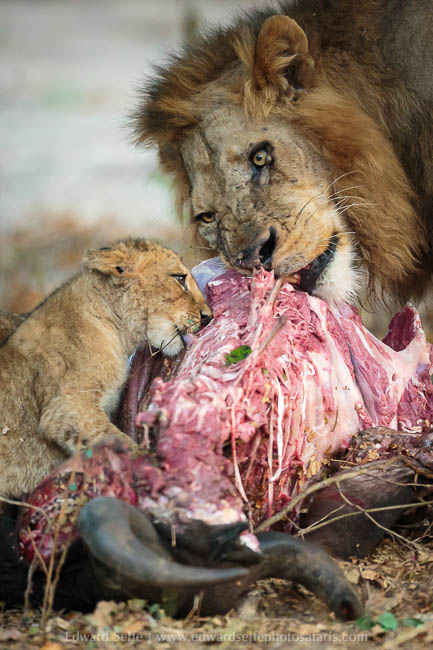
The following morning, in search of a drab bird called a sombre greenbul, we came across the local lion pride feeding on a freshly-killed buffalo carcass. This was a fantastic sighting to locate so early in the morning. We watched for a while and then thought about what the lions might do next….
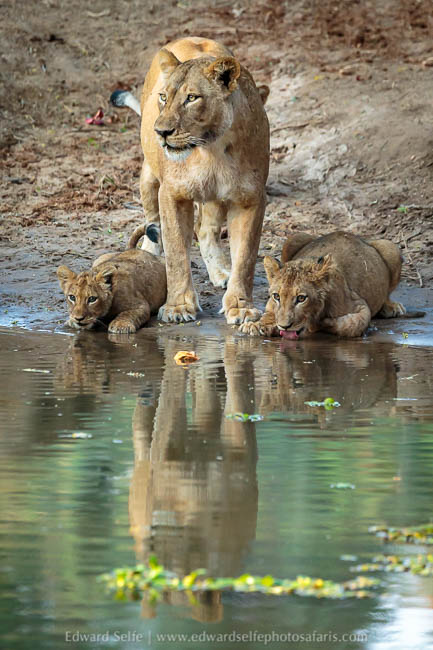
There was water nearby so we found a crossing point and waited on the other side for the lions to come to drink. When they did, we were in the best possible position to capture lovely reflections and get images of the lions from the front.
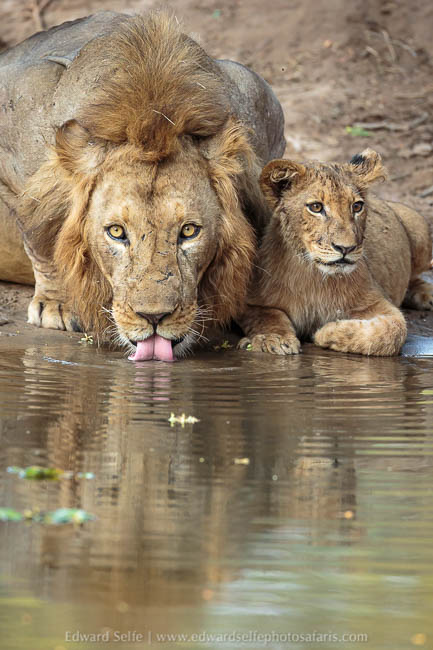
There were two other vehicles at the sighting who had not pre-empted the lions’ movements and they found themselves stuck on the far bank photographing the lions from the back. These are the kinds of decisions that we make on a photo safari to ensure that guests get a much better photo experience than they would have done on a ‘normal’ safari.
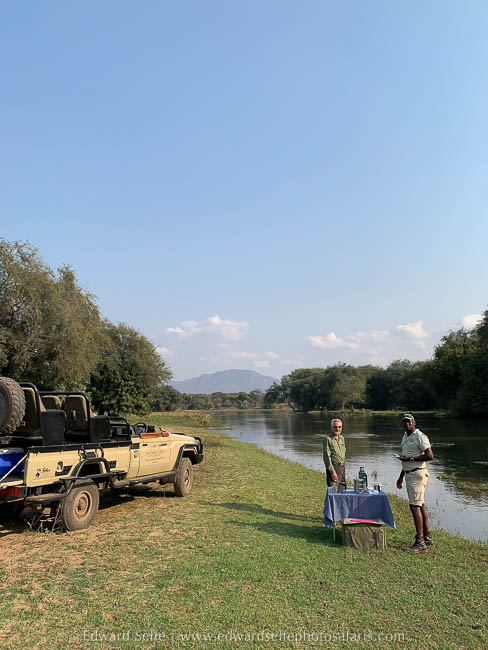
Thrilled with our morning, we went for a coffee break alongside a small channel and waited for the light to rise a little more so that we could shoot backlit hippos…
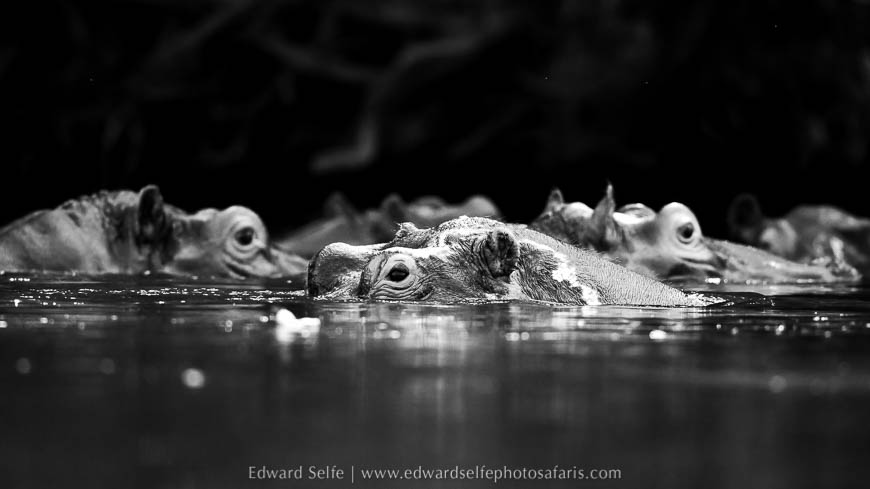
….like this!
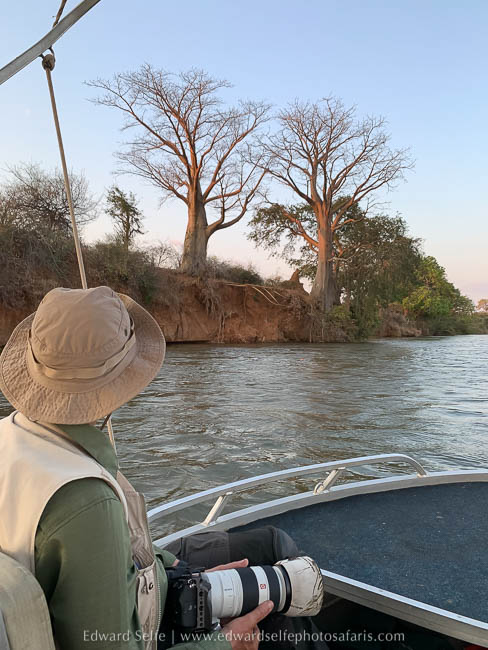
We were back in the boat that afternoon, having loved the experience so much the day before, and enjoyed more waterbirds….
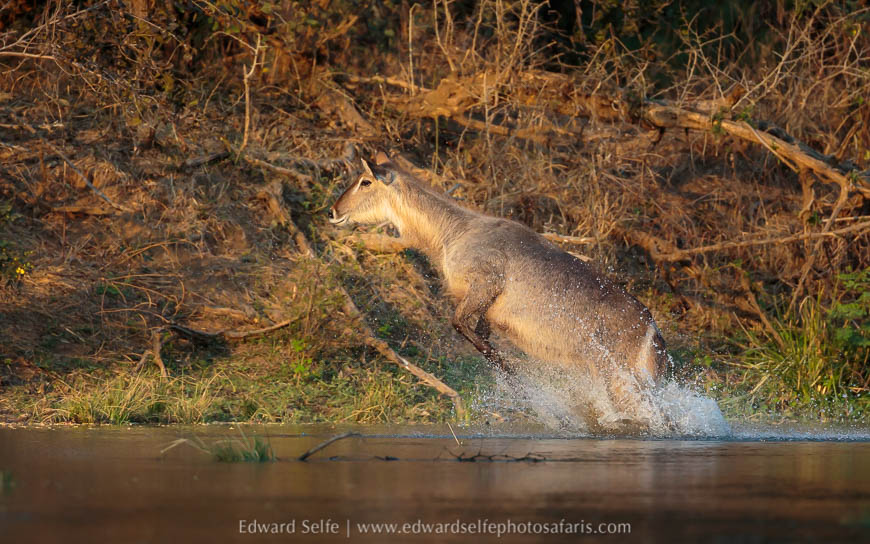
…and some waterbuck which ran through the deep water to get off a small island where they had been feeding.
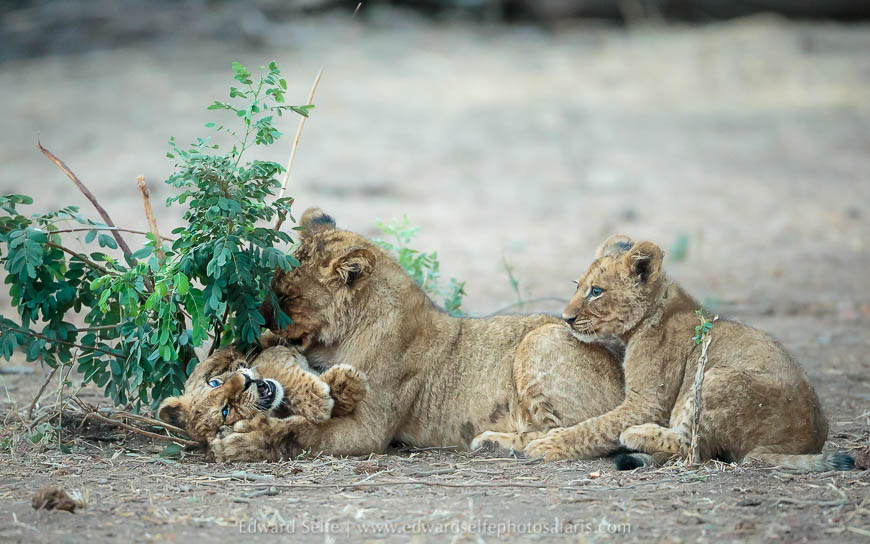
A frustratingly cloudy day greeted us the following morning; such that the lovely sighting of the lion cubs playing was very tricky to photograph. We made the best of it, but as they settled down, we decided to move on….we could hardly complain after the sightings that we had enjoyed up to now!
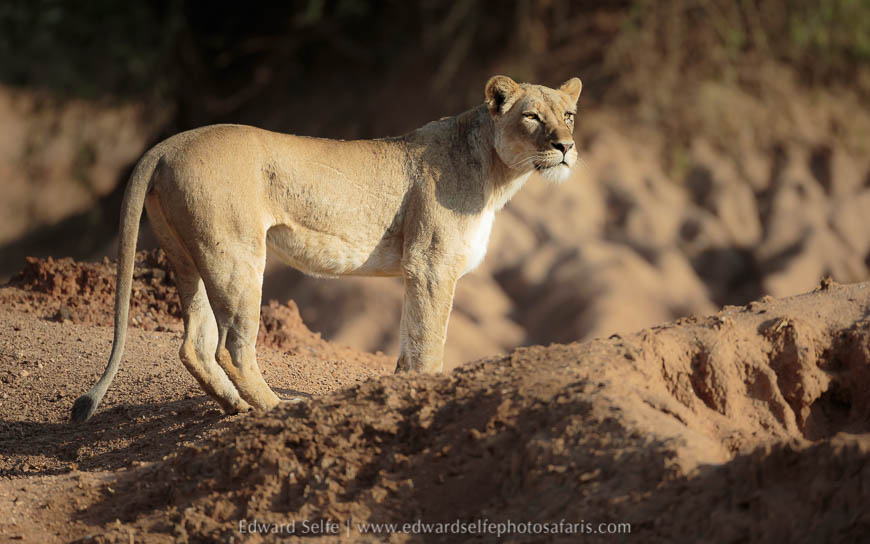
And moving on turned out to be a very good choice. We headed to the Jeki Plains where we found a lone lioness hunting warthogs in the windy weather….
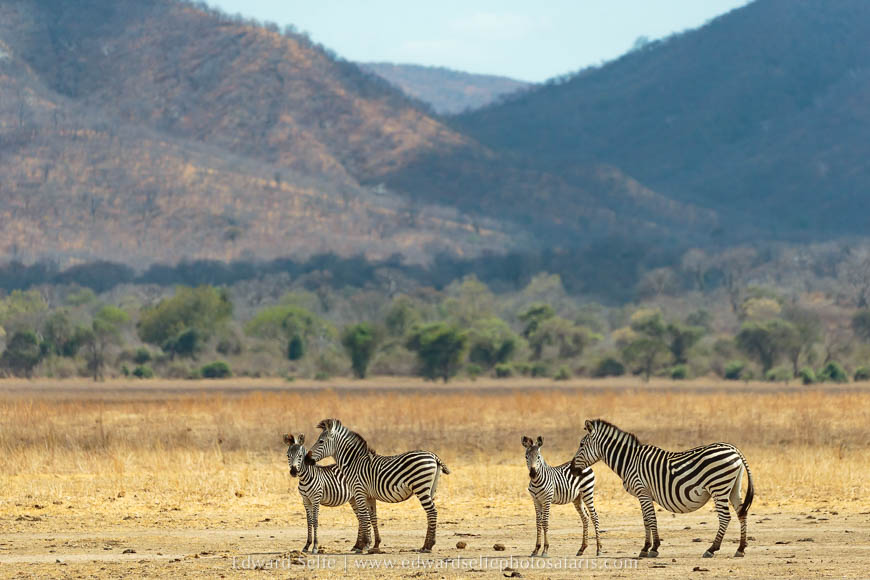
…and a beautiful scene with zebras against the Zambian escarpment.
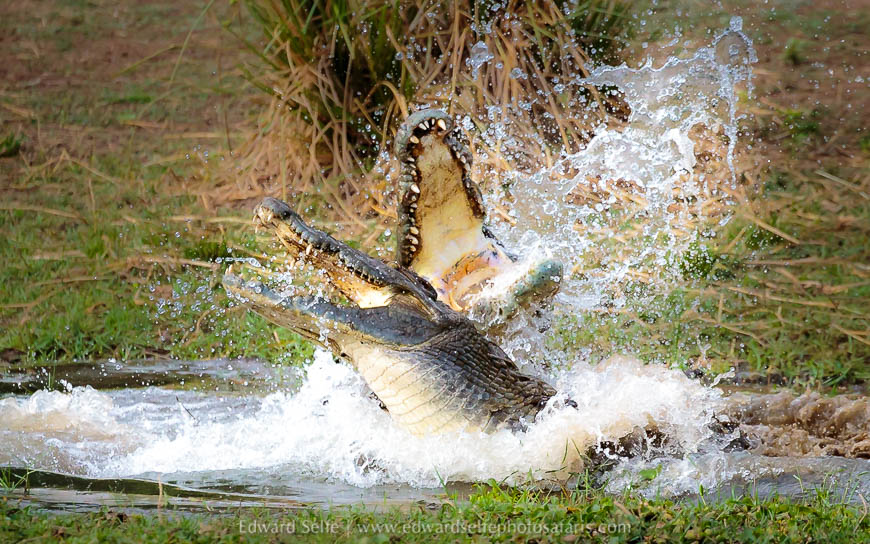
This was a fortunate moment and perhaps the most unusual shot of the trip. As we approached a narrow channel, I saw a crocodile moving through the water away from us. The water was shallow and I though perhaps it might appear above the water at some point. In fact, even better, it met another crocodile and there was a brief skirmish before the first one went on its way. If ever there was a case to prove the need to have your camera set up ready for action at all times, it was this!
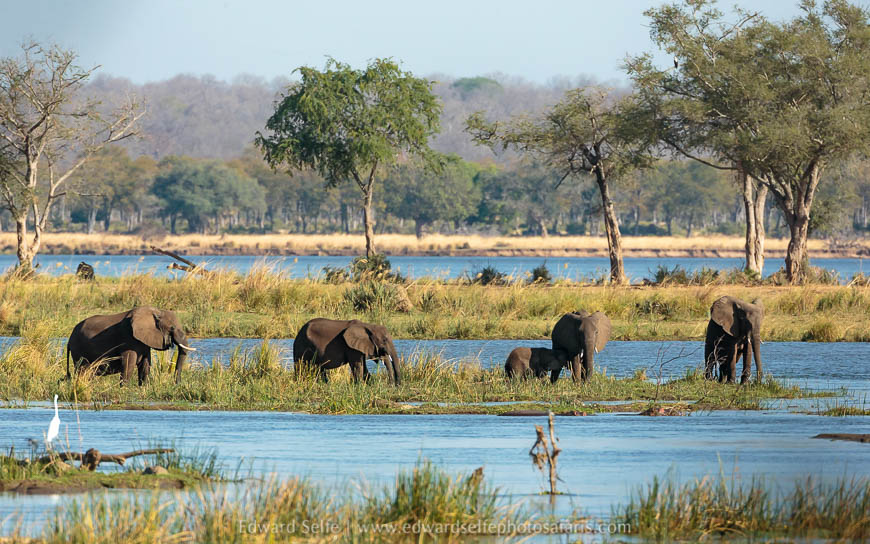
Our final two safaris in the Lower Zambezi came round way too soon…we had loved the different feel of this area compared to the Luangwa, and enjoyed very much the time we got to spend on the river.
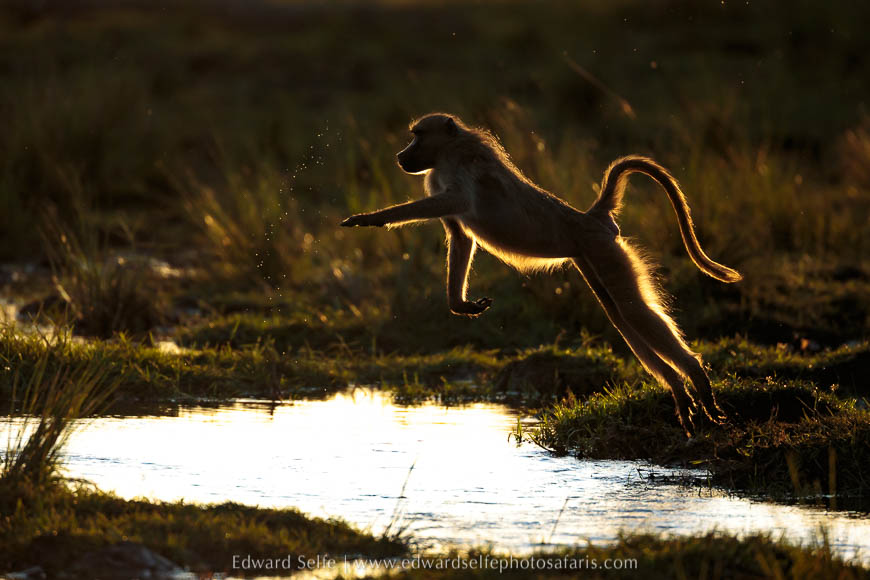
The light was exceptional on that last afternoon so we meandered through the woodland, shooting whatever came along. Baboons, in a long line, were crossing a narrow channel. We spoke about how to place them against the dark grass behind to accentuate the halo of light around them, and then shot hundreds of images until we had the shot we wanted.
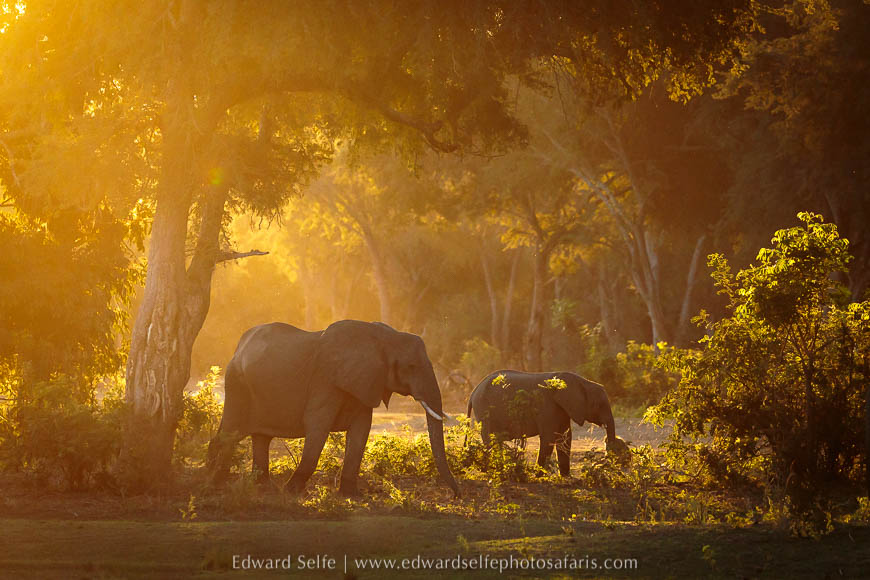
Just as we were tiring of that, a small family of elephants appeared, dripping in gold sunlight and that really capped our afternoon!
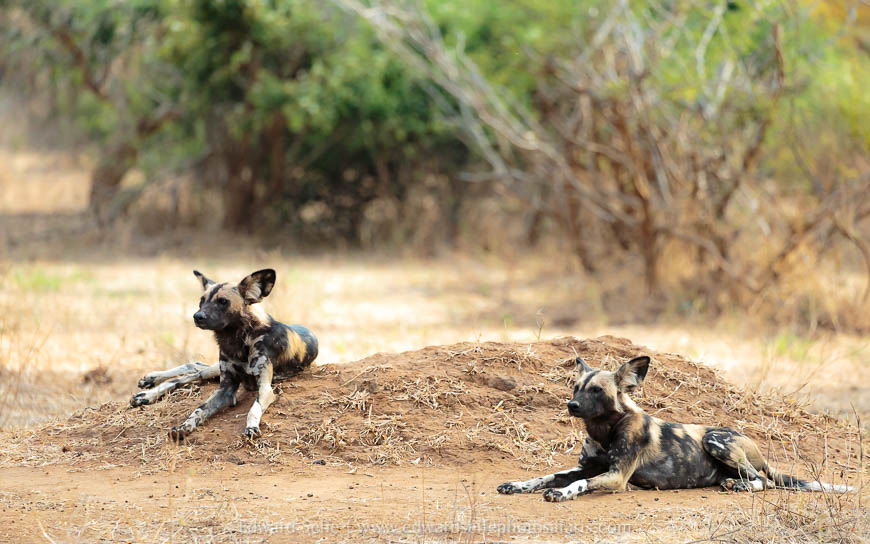
We had seen wild dogs the previous day just after our crocodile clash, but they moved quickly away and we lost them in the thickets. So we were happy to find them again on our last morning. They were lolling around on a termite mound, but we could only see 8 of the 21 that we knew were in the pack.
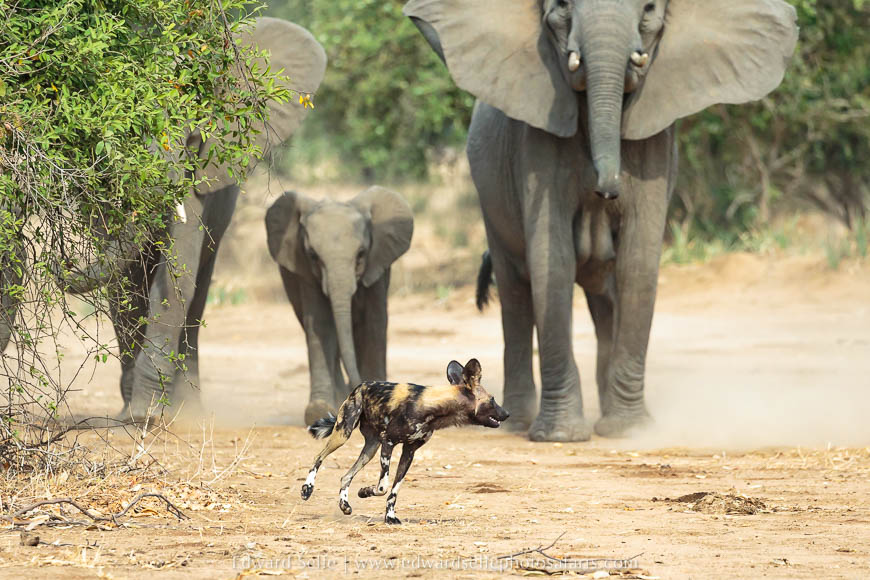
Soon enough, the rest of the pack began to emerge from the thickets followed by a herd of elephants who were very keen to chase the dogs! We enjoyed watching as they chased the dogs on multiple occasions, before the herd moved off towards the river.
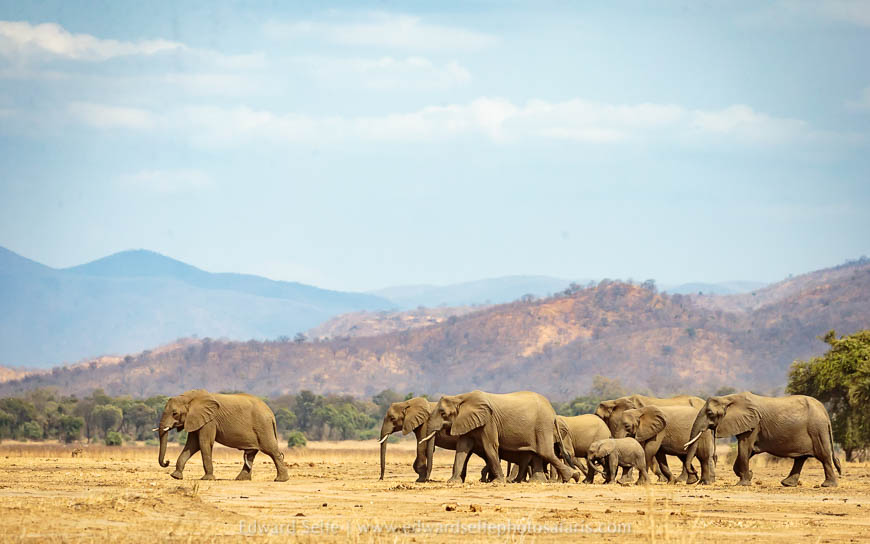
Spotting an opportunity, we left the dogs and I took us round in front of the elephants to capture them as they crossed the plain with the hills behind. This was a fitting final encounter for Lower Zambezi.
We had a brief coffee break and then drove the short distance to Jeki airstrip to begin the journey to Kafue National Park. While we still had 9 days to go, we realised we were over half way and this mega-adventure would, after all, sadly come to an end at some point. But there was lots to see in the meantime!
I first visited Kafue National Park in 2019 and then again in 2020. As I mention in those write ups, I wasn’t too sure what to expect. On the one hand, the web is full of stories of the tsetse-fly ridden Kafue where there is no game to be seen and when you do see something, the layer of flies on you and your subject is too much to handle….and on the other hand, long-term operators such as Wilderness Safaris have camps there, and new, young operators (such as Jeffrey & McKeith Safaris) are setting up there and making a success of it. So there had to be something in it!
From arrival in the Kafue, and every time since, I have been thrilled with the experience that we have had there. Where the Kafue differs from the Luangwa is in the density of game and it is possible to have a quiet period on a game drive where you see very few mammals, but it’s never for long and the variety of birdlife provides subjects and interest that fills in the gaps! So, what follows are the images and captions that illustrate the 10 days that we spent in the Kafue, using 3 different camps in the central, northern and Busanga areas of the park. The first was Musekese Camp, operated by JM Safaris.
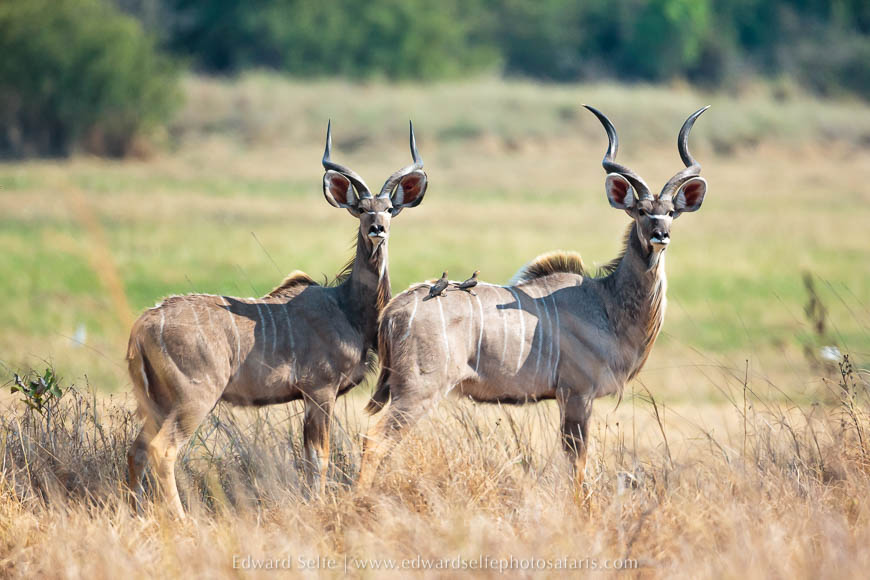
Our first afternoon on safari was a short one, as we had arrived late in the day from the flight. We stayed close to camp and explored a few likely areas in search of some of the area’s resident leopards (of which the guiding team know 19 by sight!). We didn’t have any luck with them, or the following morning, but we enjoyed what came along in the form of antelope, birds and simply enjoying being in a new ecosystem.
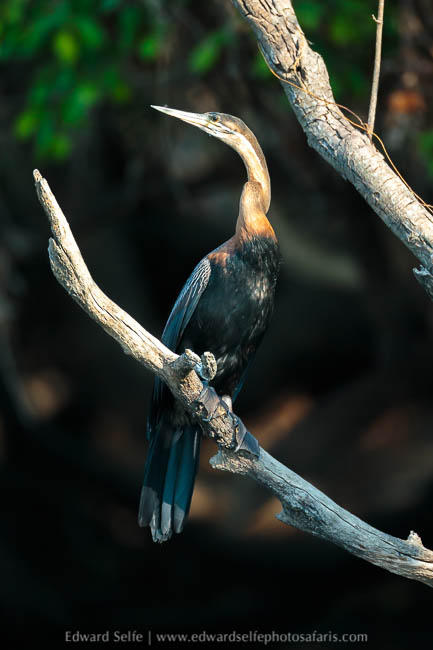
The following afternoon, we took the first of our 3 boat cruises from Musekese Camp. There is a good chance of finding predators resting on the cool, damp river banks in the shade of beautiful waterberry trees, and in between these sightings, there are so many beautiful ad interesting birds to enjoy, such as this African Darter, a relative of the Americas’ Anhinga.
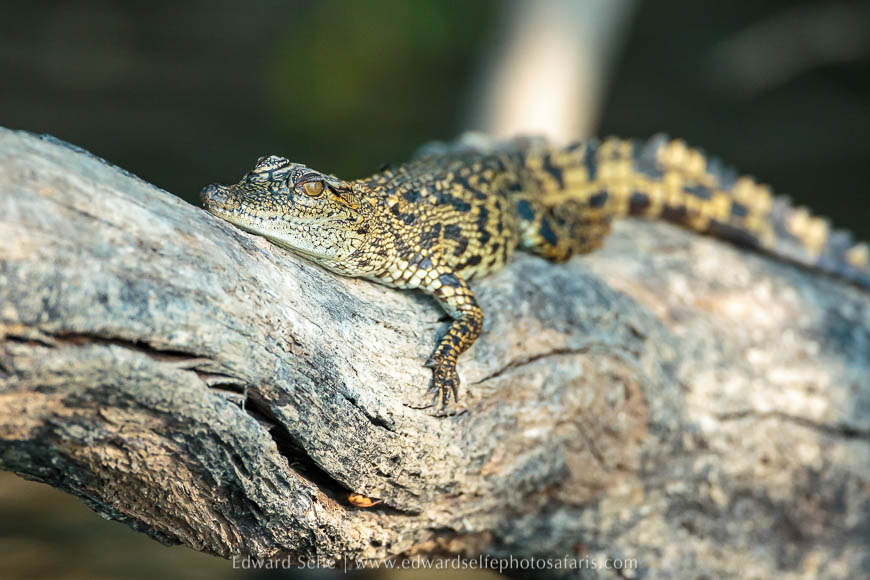
Young crocodiles…..
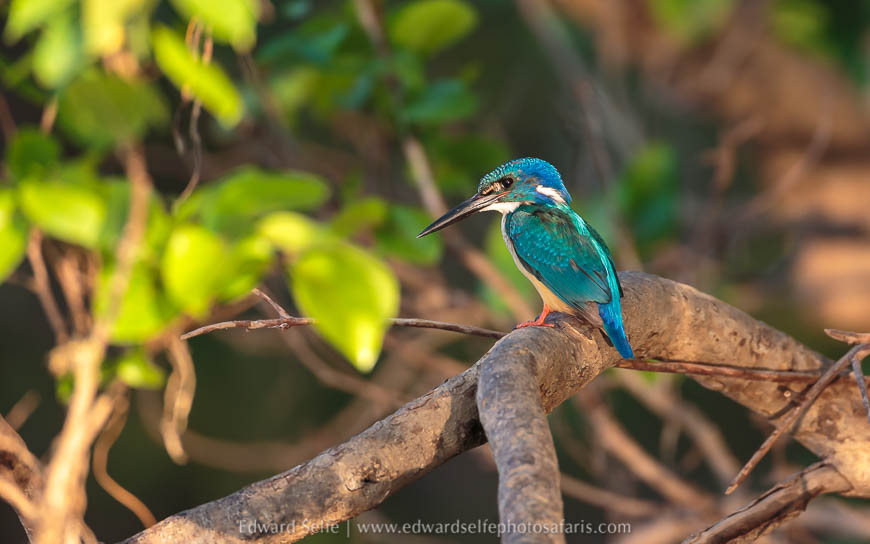
…and brightly-coloured Half-collared Kingfishers can be seen all along the banks….
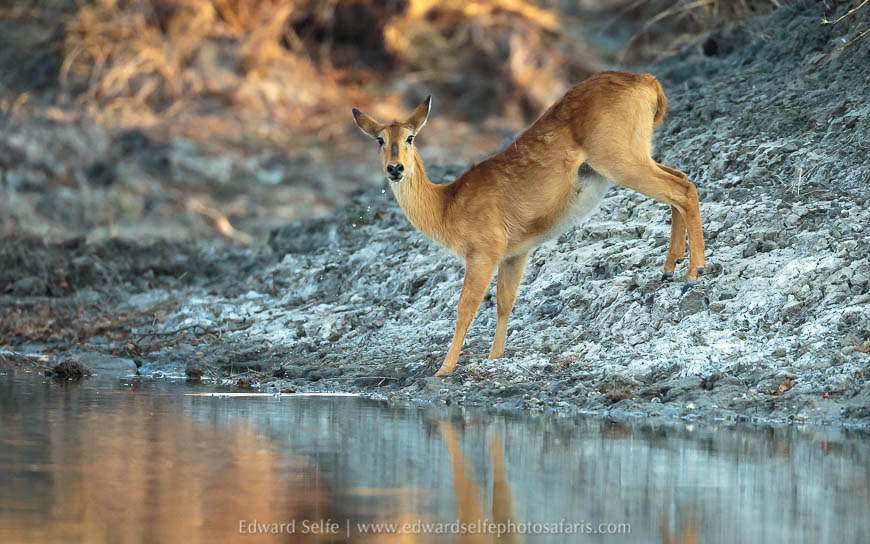
…and cautious antelope come to drink but keep a wary eye on the boat’s approach.
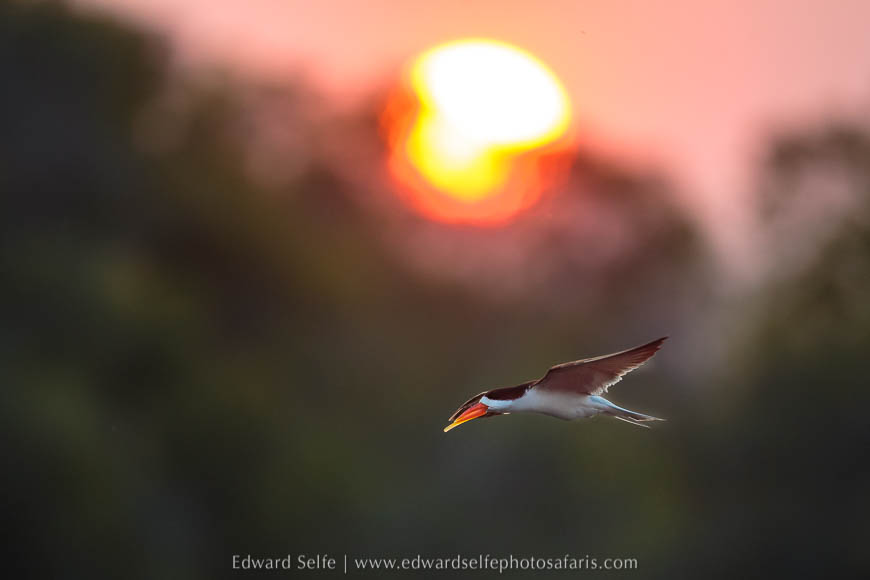
With water levels high, even at this late time of the year, there were fewer African Skimmers nesting on the islands than I had seen in the past. But 5 or 6 pairs still gave us an incredible show as we sat close to their sandy home and photographed them in all possible scenarios.
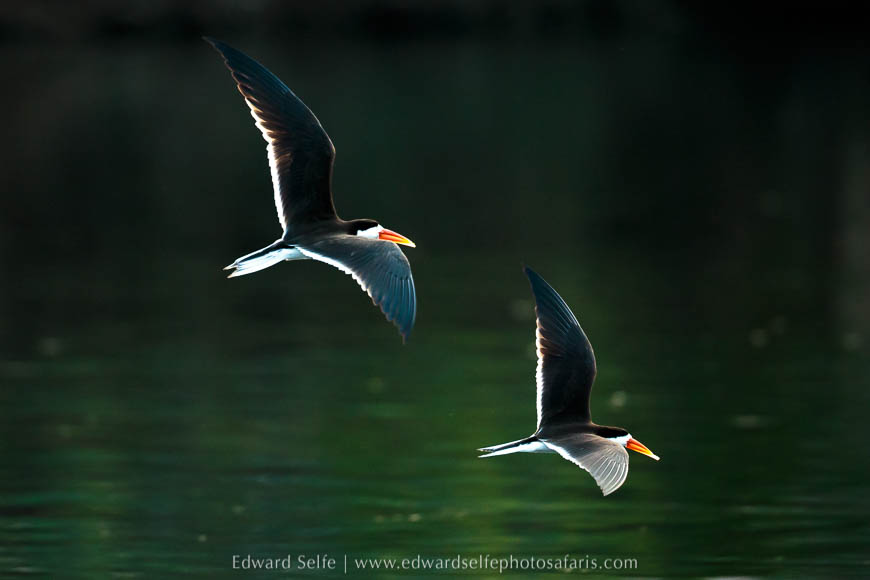
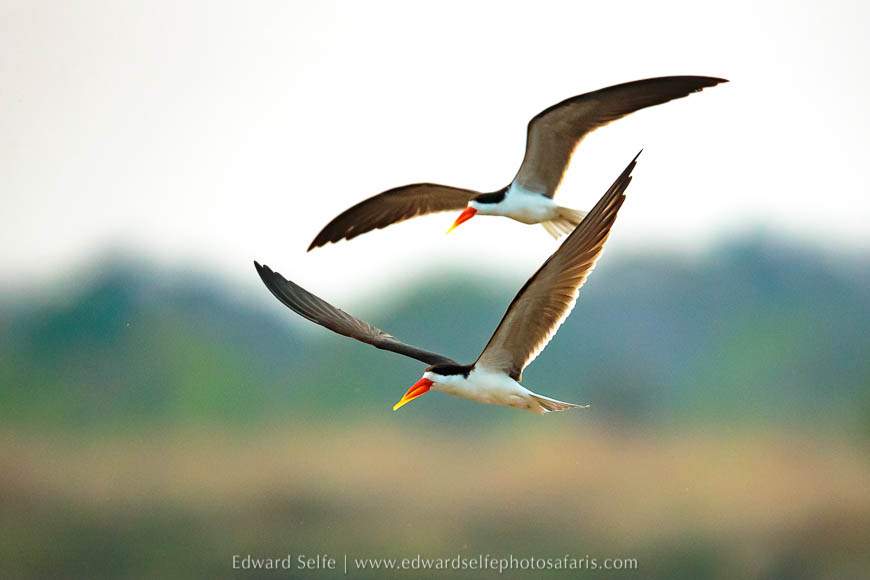
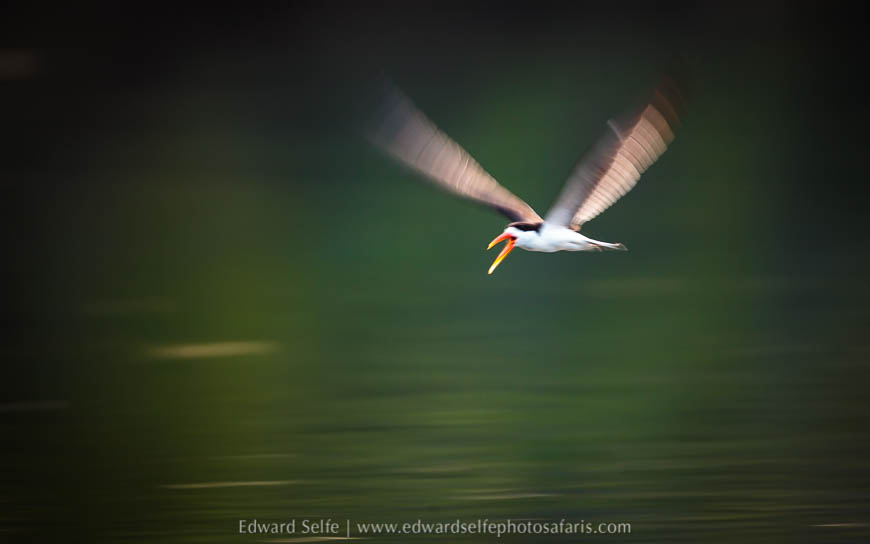
As the light dropped, and we struggled to get the shutter speed needed to freeze the movement, I suggested that we intentionally opt for a slow shutter speed and try for panning blur shots. It took time to work out the optimal speed to freeze the heads and allow movement in the wings.
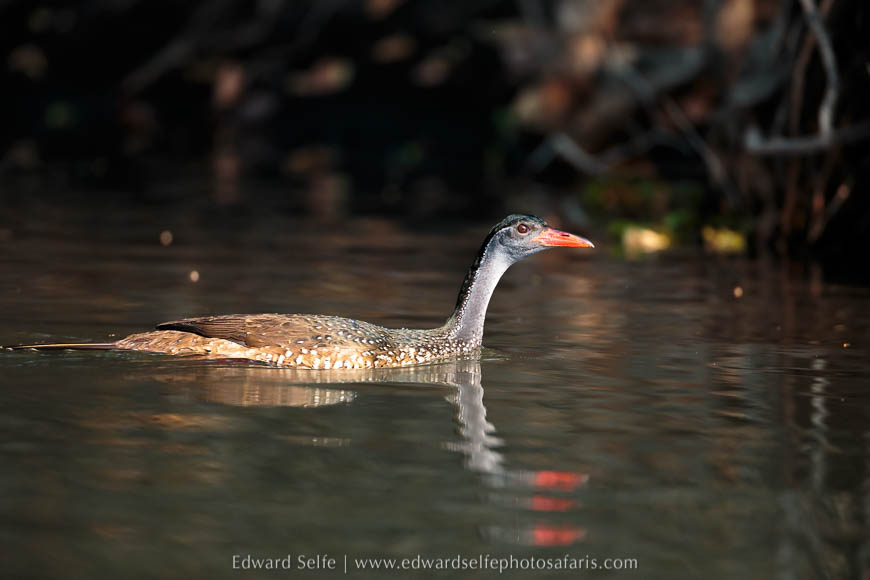
There is great birding generally along the Kafue River, including African Finfoot, a strange cormorant-duck like bird which prefers to swim but will climb out of the water and hide in overhanging tree roots if startled. When it does so, it reveals bright red feet which match its bright orange bill!
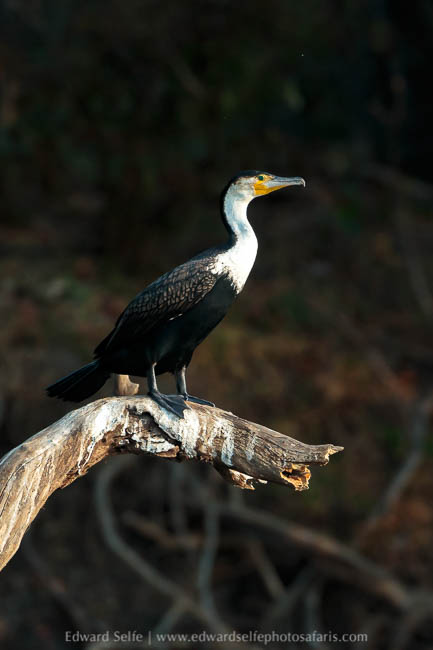
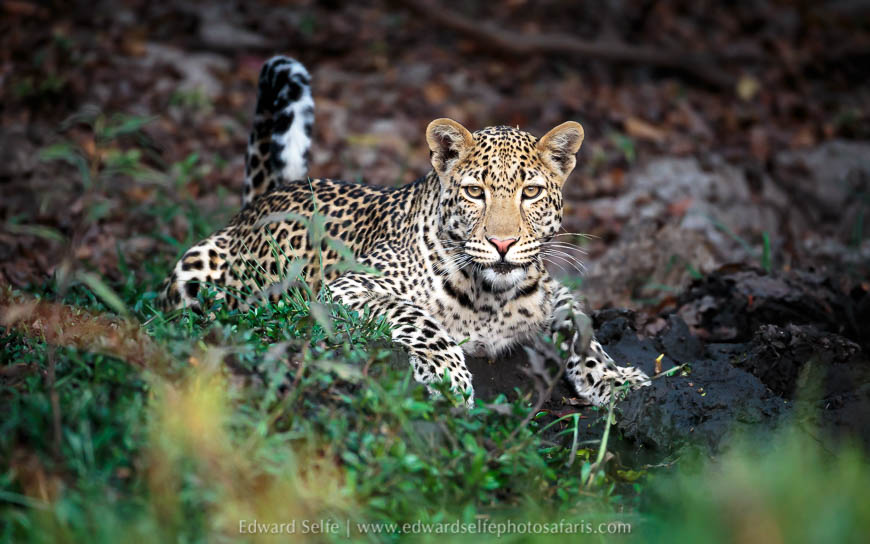
The river bank is also a fantastic place to find predators, especially in the late afternoons when they rouse and come to drink; this young male emerged from the bush and lay down to drink as we approached. The low angle, and the excellent dark background makes for a striking portrait.
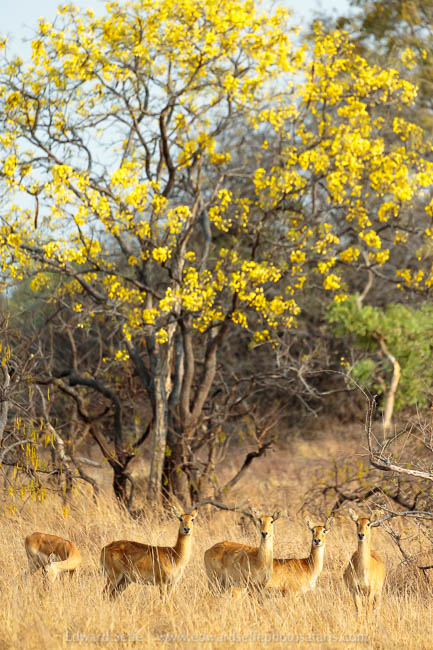
During our 4 days at Musekese we continued the pattern of morning game drives and afternoon boat trips. It served us well; the mornings often gave us good predator sightings and lots of chances to photograph birds both on the drives and in camp. The cassia trees were in bloom this time so we had a lovely background to use for subjects.
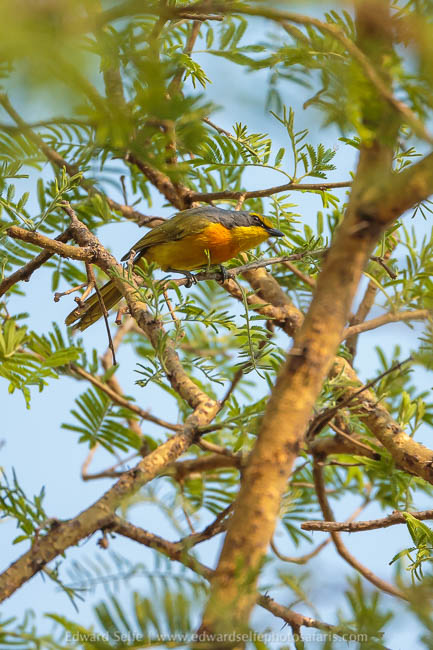
I was happy to get a shot of an Orange-breasted Bush-shrike, a shy and skulking bird that is always heard but rarely seen!
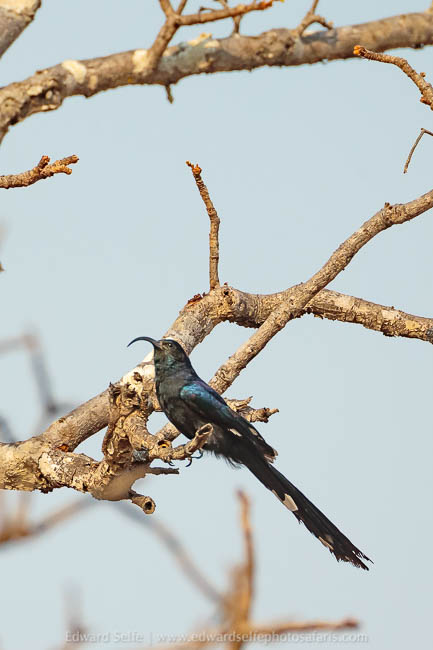
Another difficult species, the Common Scimitarbill, which I had not managed to photograph before.
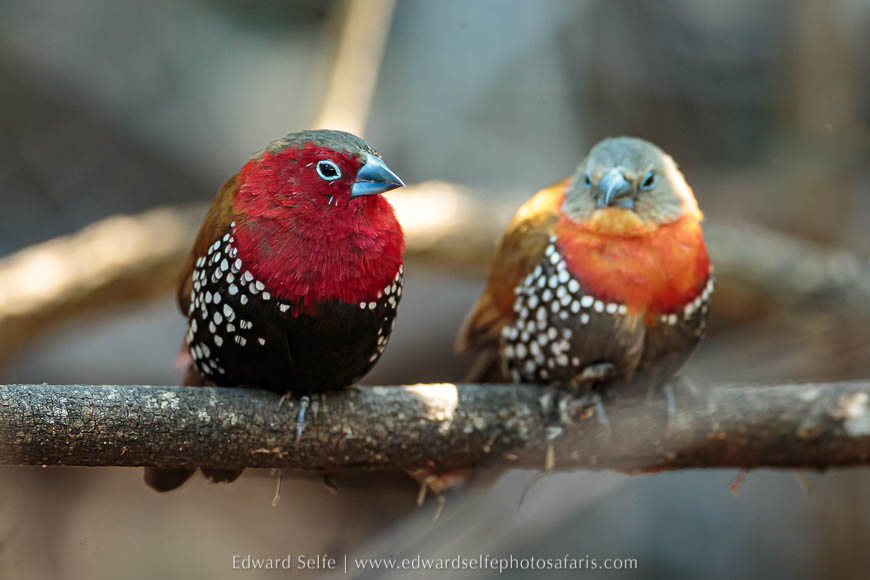
We spent an hour, looking like crazy people with our heads in a bush, trying to get a clear and sharp shot of these two Red-throated Twinspots….
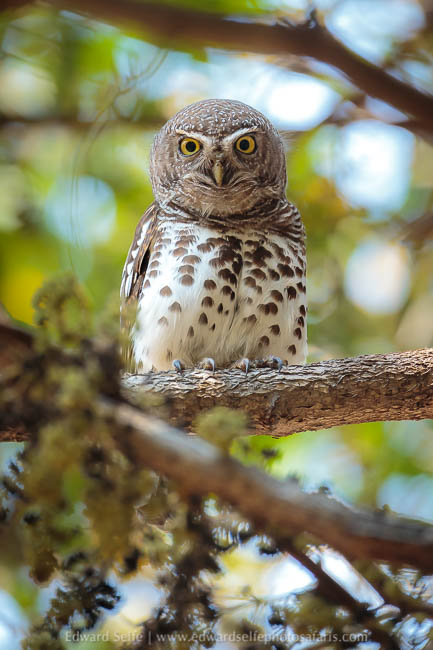
….and this African Barred Owlet was an ever present sound around the camp.
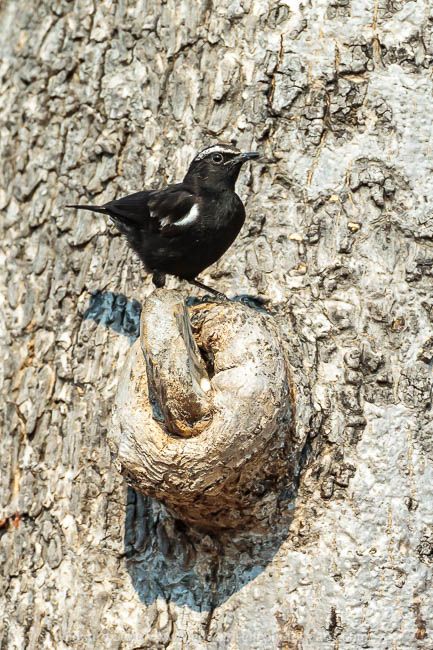
Arnott’s chat, a charismatic and noisy bird of mature woodlands….
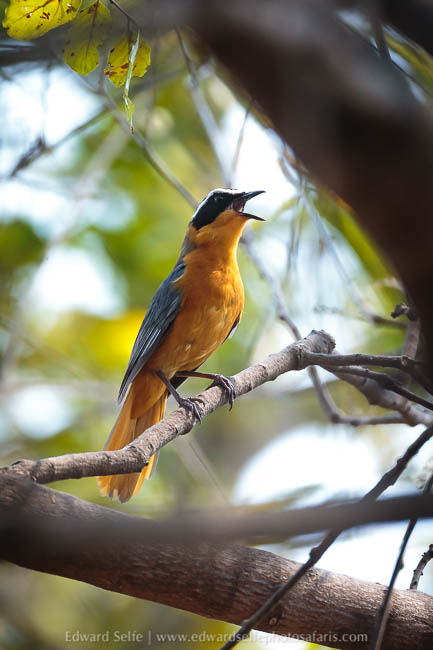
…and a White-browed Robin-chat, one of Africa’s most accomplished songsters.
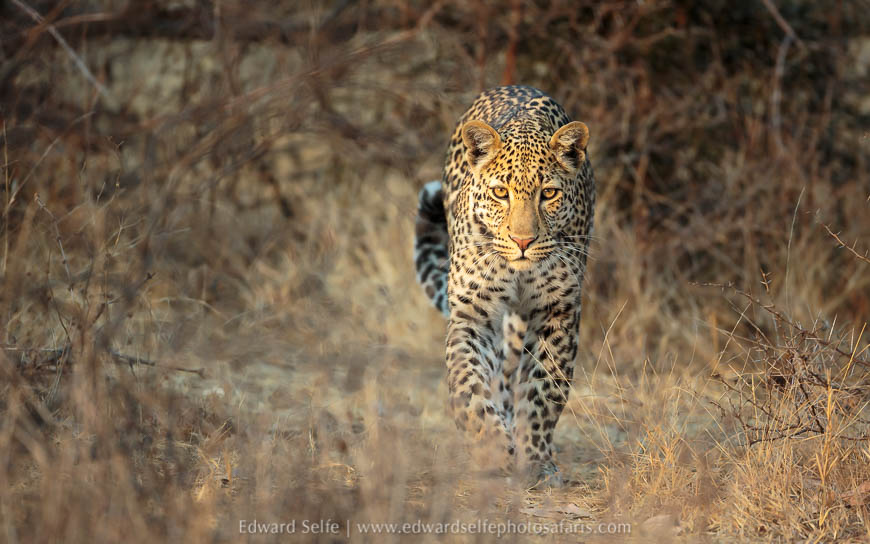
One very memorable day gave us 5 leopard sightings (which challenges even the Luangwa, the Valley of the Leopard) starring this beautiful guy in the morning….
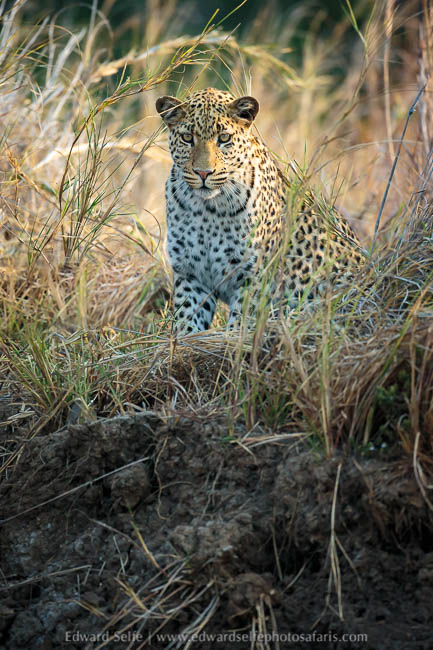
…and this young male in the afternoon!
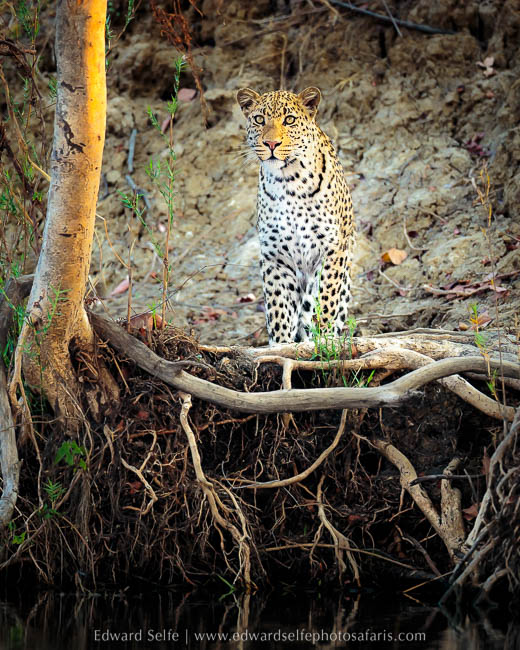
Zambia’s Kafue X Brazil’s Pantanal
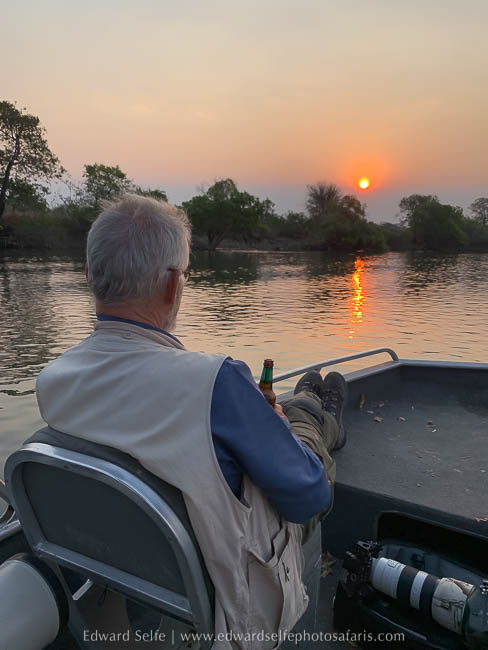
After a busy day of shooting, sometimes the cameras had to be put down and a cold beer put in their place!
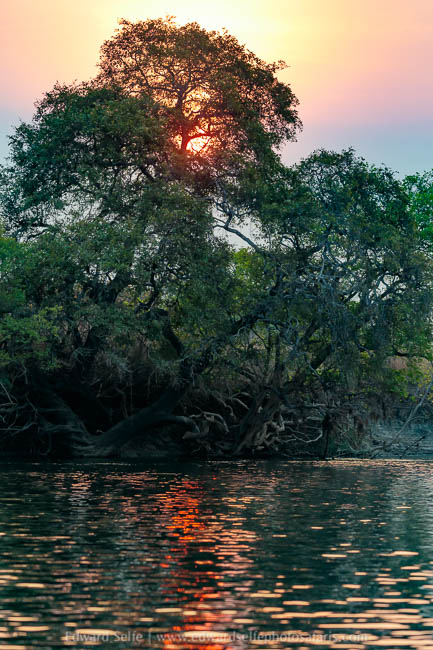
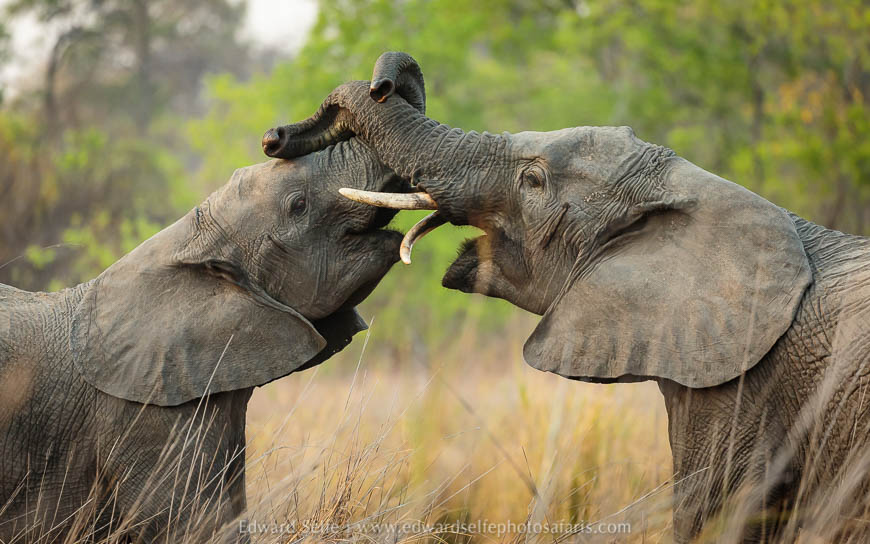
On our last morning at Musekese, we found a large herd of elephants as they emerged from the woodland on their way to the river. The herd was unsettled, and we didn’t know why, but soon enough another herd appeared behind and we knew that they had been waiting. The greetings were wonderful!
We’d had a great time at Musekese, but the allure of the Busanga Plains was strong and we were excited to head north. We had a 4 hour road transfer through some beautiful, but mostly unproductive country which was actually very instructive; it reminded us of the importance of the excellent work done by Musekese Conservation in the Musekese-Lumbeya area of Kafue National Park. Their anti-snaring work, combined with anti-poaching patrols and fire management have made the areas around their camp into wildlife hotspots. As their reach expands, the Musekese-Lumbeya area can hope to enjoy improved sightings everywhere.
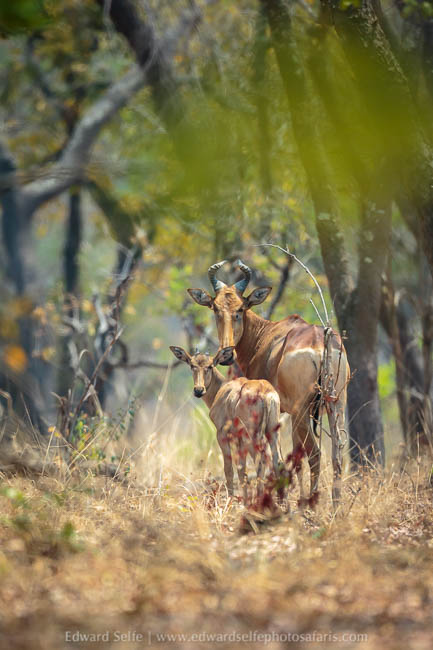
On the road north, we mostly kept moving to avoid collecting a lot of biting flies, but the sight of Lichtensteins Hartebeest with their calves was worthy of a pause!
Once we reached the start of the Busanga Plains, we knew we were getting close to Ntemwa-Busanga Camp, the small satellite camp for JM Safaris. This is a true bush camp, made from local, natural materials and based entirely on maximising your experience in nature with large, open-fronted chalets and a raised deck which looks over the plains.
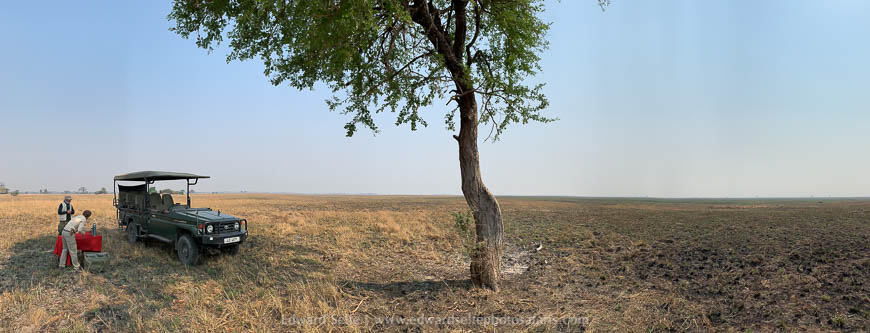
Compared to the bush country of the Luangwa and the Kafue, the Busanga Plains is a totally different world. In some areas there are so few trees, that you have to plan where you will find shade for a coffee break!
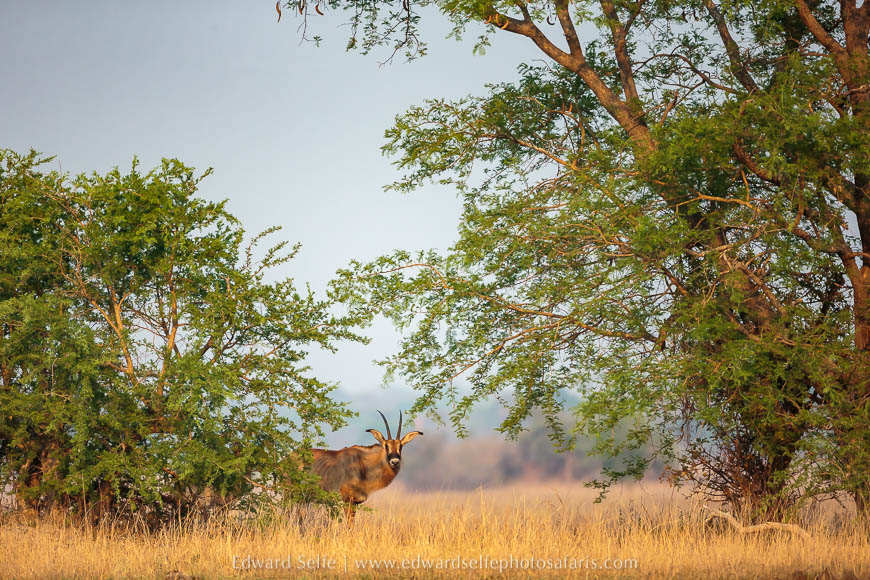
But the unusual sightings, as well as the diversity of species is really exciting. Here a shy roan antelope peeks out from behind some acacia scrub…
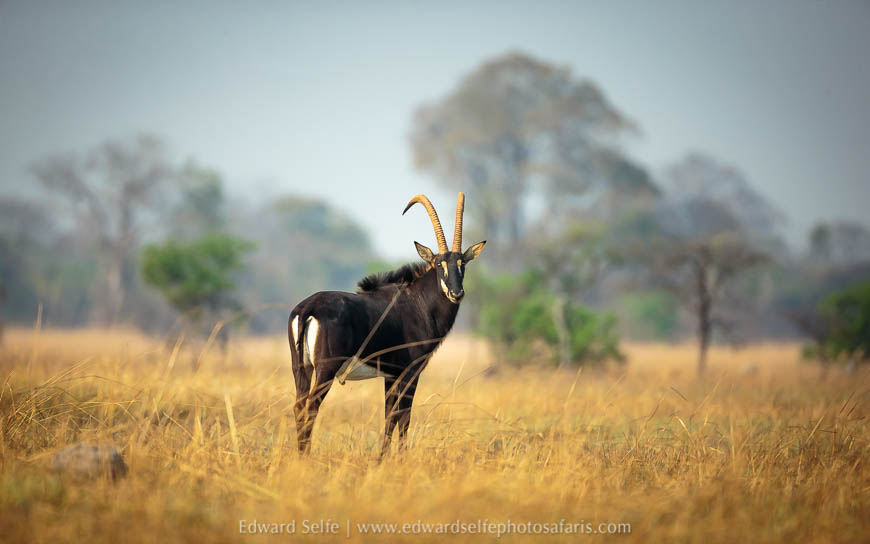
….while nearby a stunning sable antelope bull graced us with 15 minutes of his time, almost unheard of with these shy creatures. We were even able to get out and sit on the ground, which anyone who has experience with sable will know is special!
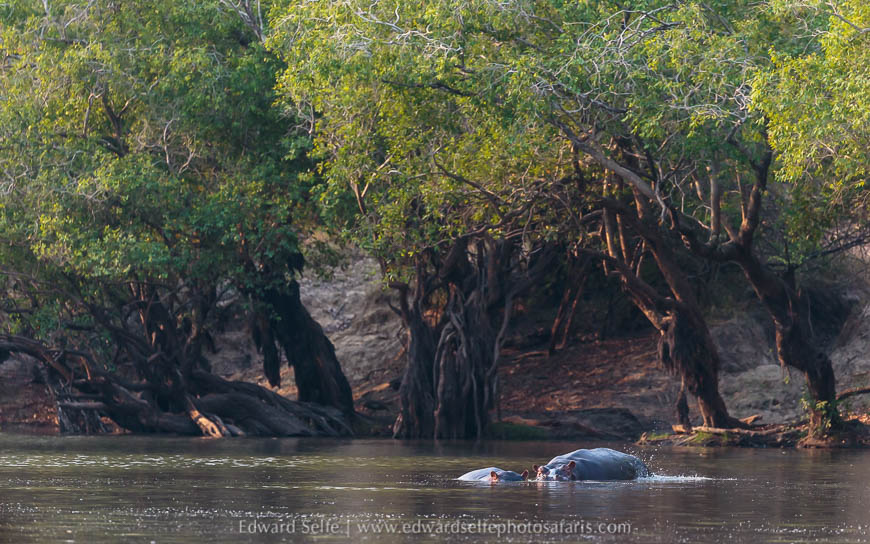
Where the plains converge and form the start of the Lufupa river, there are still some large pools of water, such as this one where a number of hippos were enjoying the cooling mud on. hot September afternoon.
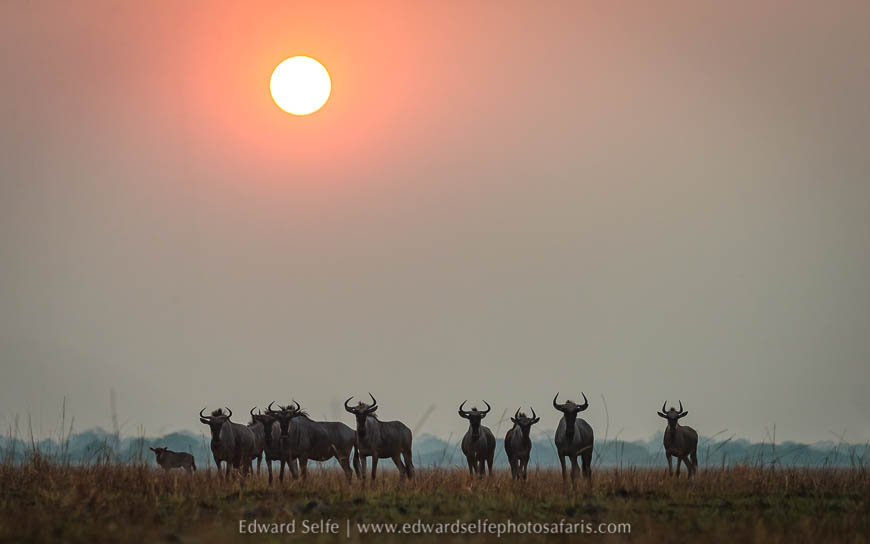
Dusty early morning light reduces the contrast and makes images such as this, where there is still some detail in the wildebeest, possible.
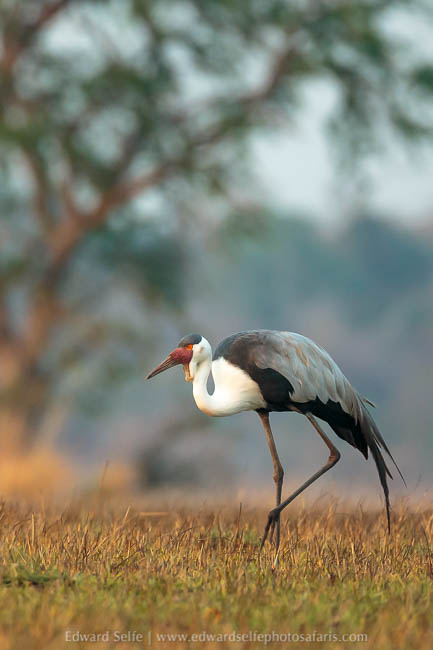
Wattled Cranes are a highly threatened species and Zambia is a hotspot for them and key to their survival. They tend to be very shy creatures, so we were thrilled to get this close to a pair….
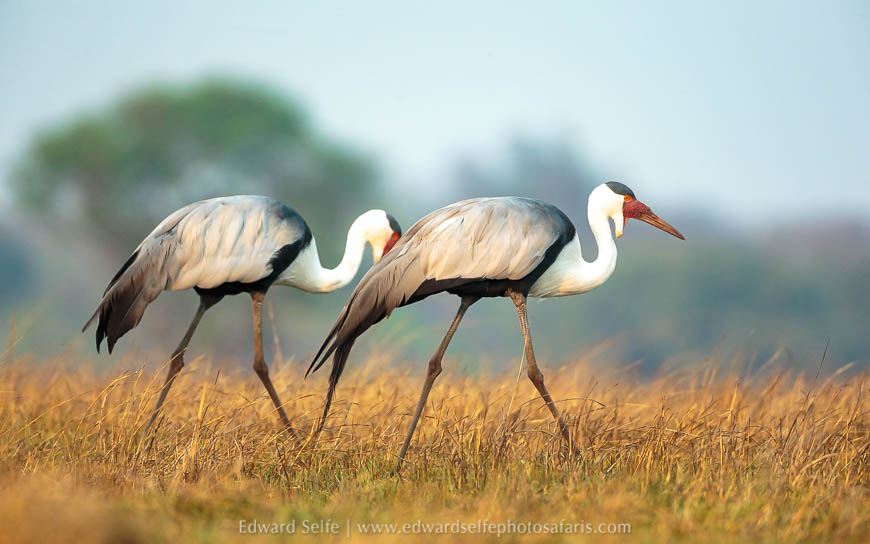
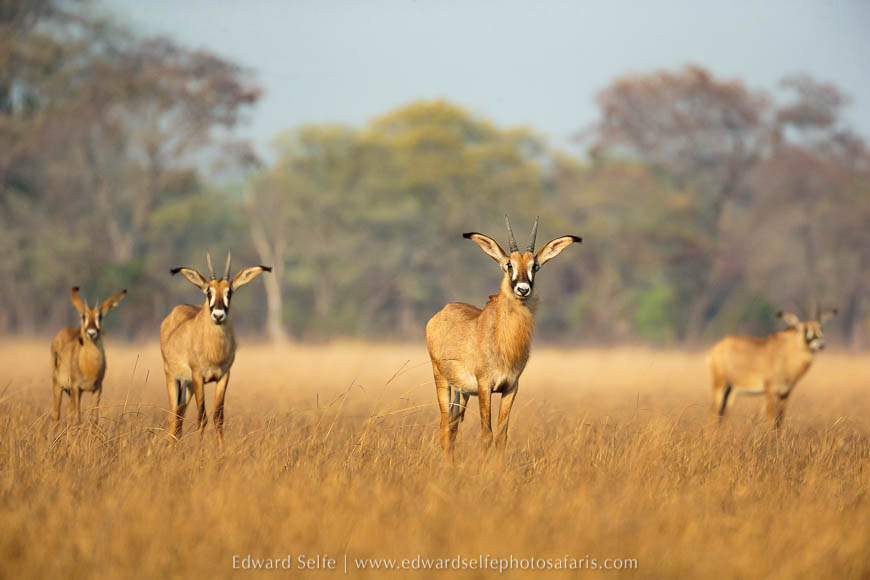
Mid-game drive one morning, we did a seamless handover from the JM Safaris vehicle to the Shumba Camp vehicle provided by Wilderness Safaris. As we set off from the meeting point with Isaac Kalio as guide almost immediately we found this group of roan antelope in the perfect morning light!
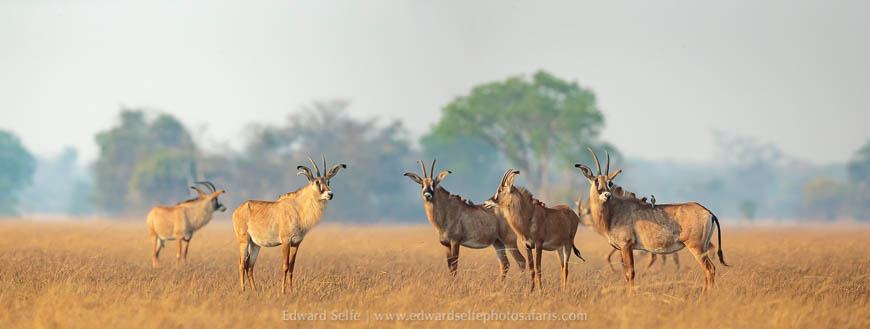
We spent much of the rest of the morning with them, knowing that it’s not often that the light, the subject and the surroundings line up so well!
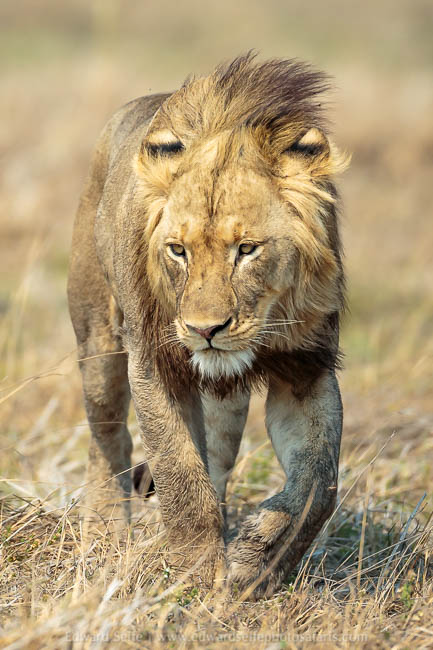
We still had a long drive to get to Shumba camp and Isaac had a surprise for us on the way into camp. 1 of a group of 4 young male lions who are resident around Shumba was resting in the morning sun close to the camp. As we arrived, he decided it was time to head for the shade, and we positioned ahead of him in a small depression to get the lowest angle possible. He led us to his 3 siblings who were already horizontal in the shade!
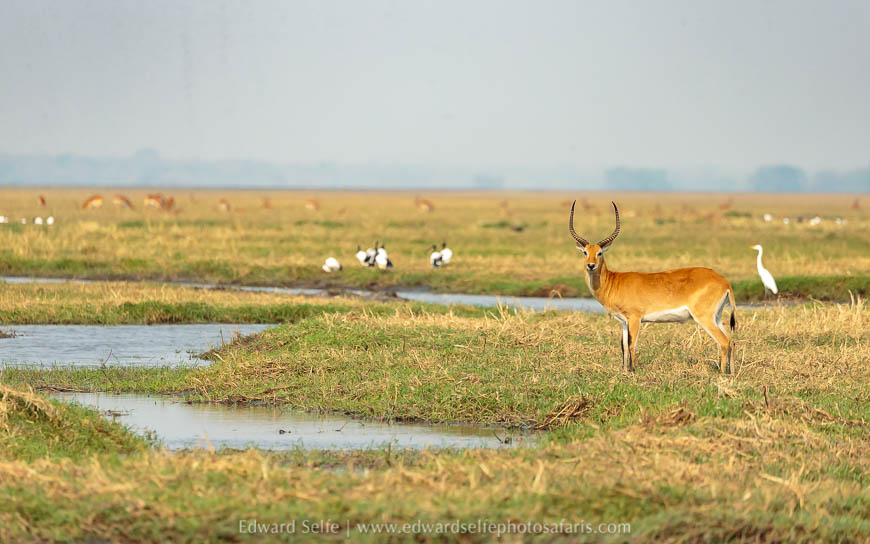
We didn’t expect too much from the males in the afternoon so we went in search of other sightings, and enjoyed red lechwe herds along the channels south and east of the camp. We wanted to capture images of these semi-aquatic antelope jumping across and running through the channels, but that took precision judgement about where and when the herds would cross…this time round, we didn’t get what we wanted.
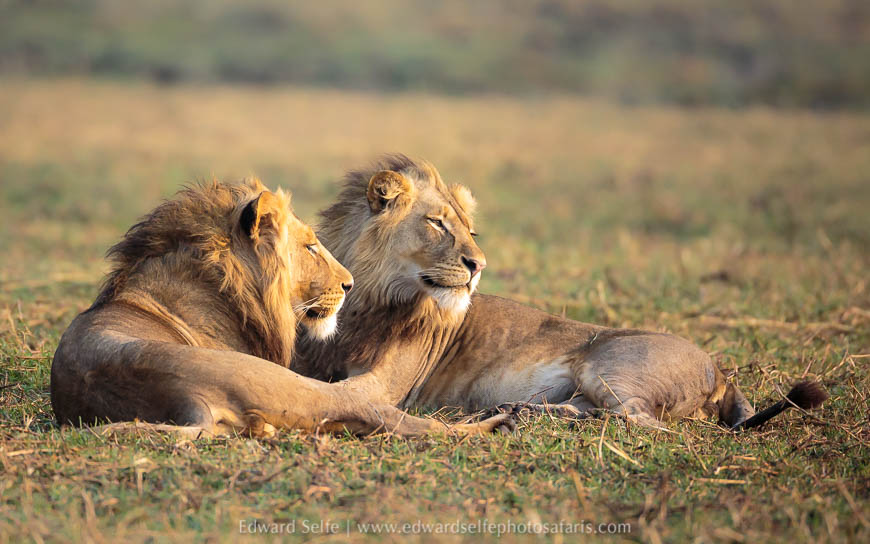
The following morning will forever be etched in my memory. It was highly memorable for what we saw, but also because it was a great example of how being super-patient often brings the best rewards. We found the 4 young males close to where they had been the day before. They weren’t doing too much, except occasionally moving position and greeting each other. The light was very low when we found them, but improved quickly and all the lechwe knew that they were there, so there were no hunting opportunities.
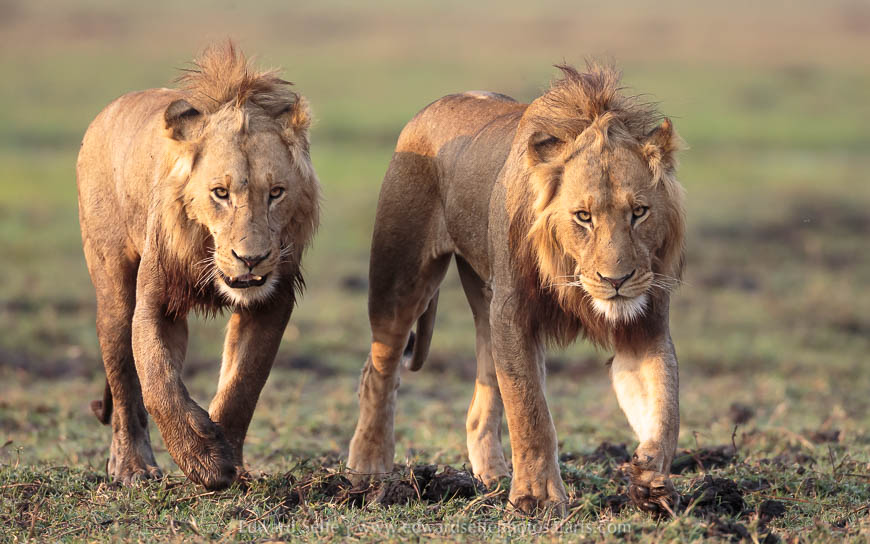
But we sat with them, taking photo chances when they came along and occasionally repositioning. We reasoned that they would have to head to the shade at some point, and that involved crossing 1 or 2 narrow channels. This might mean that we could get shots of them jumping, which was certainly on our wish list!!
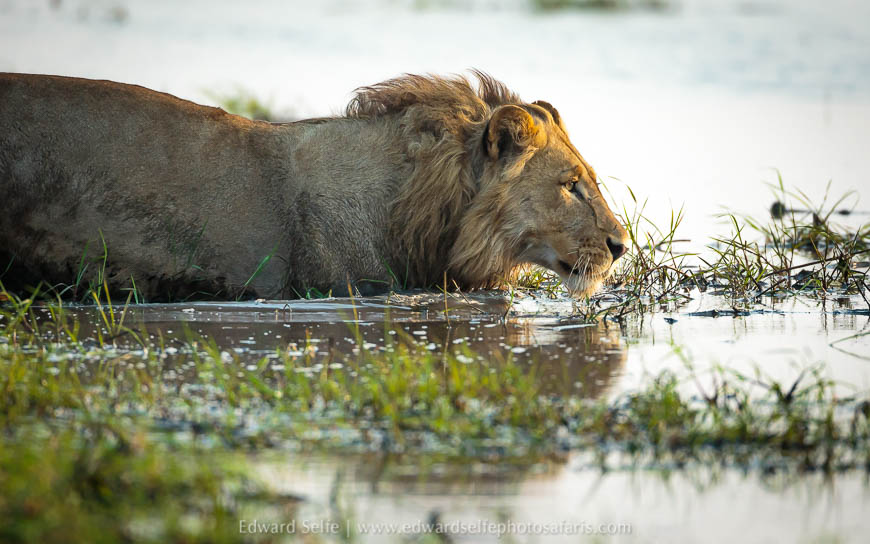
When they started to get restless, we positioned in the best spot based on light, likelihood of jump and a generous helping of good fortune! The first two lions gave us quite a show by going totally the opposite direction through the deep water; we hadn’t anticipated this, and the light angle wasn’t good….and it would have a been a long drive to get to the other side of that wide channel…
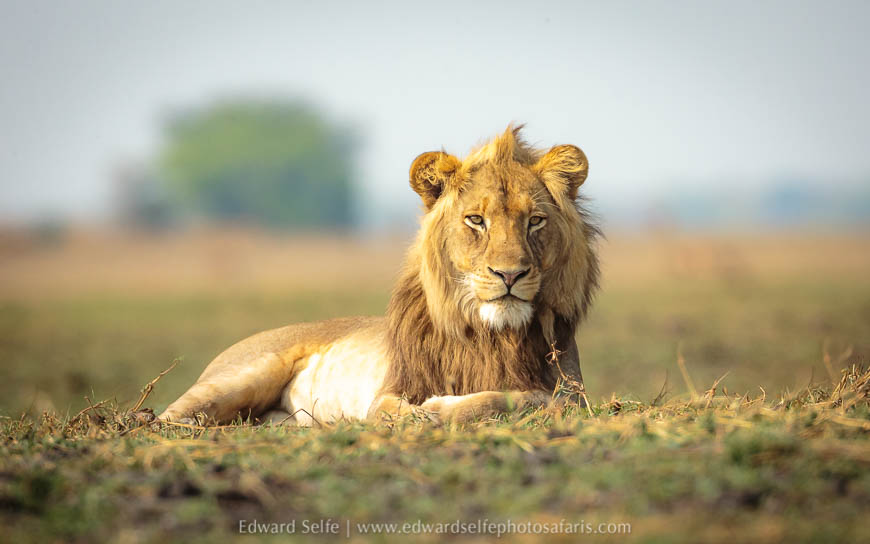
…so we waited, and hoped that the other 2 would not follow their siblings and would come towards us!
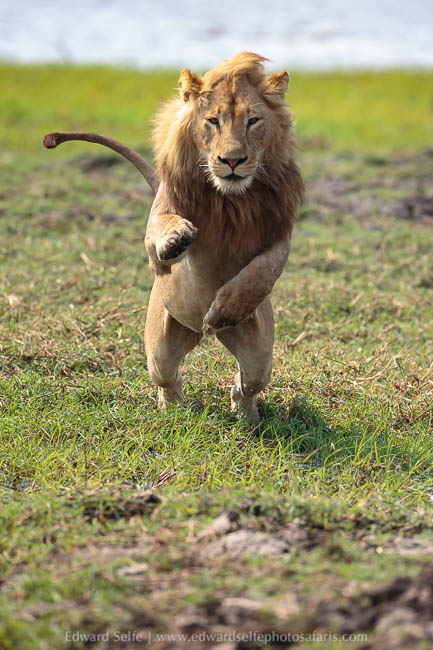
Bingo! We judged it right. The remaining two came our way, jumping first a channel towards us and then another across us. I chose to shoot the second on 500mm lens, hoping that I could keep all his limbs and tail in the shot and create the most dramatic shot — this is a full-frame image…not much margin for error!
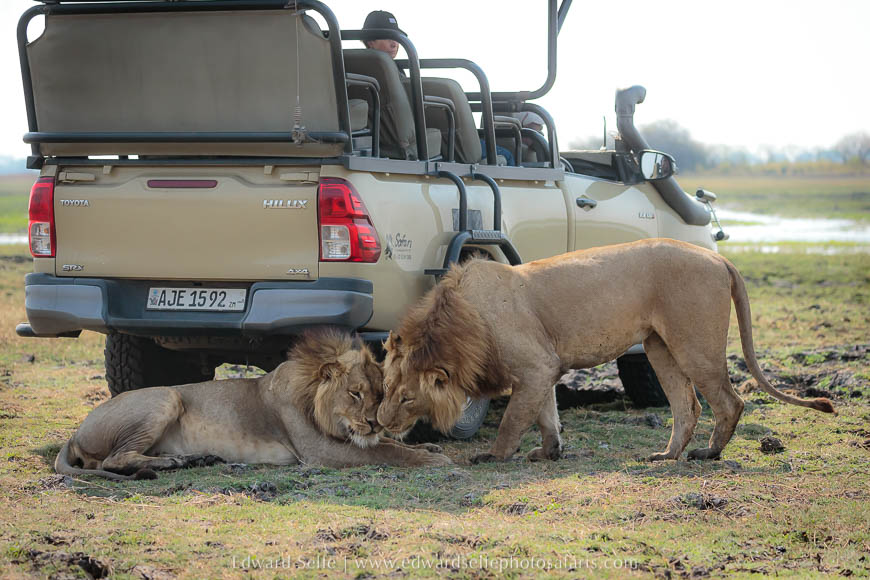
They finally settled down in the nearest patch of shade….!
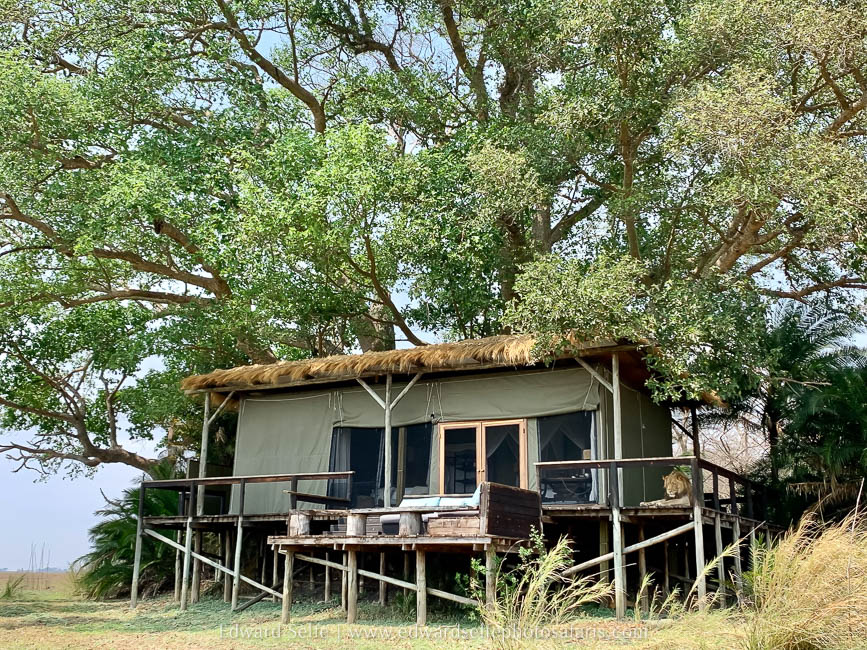
Returning to camp much later in the morning, we found that one of the lions which had swum through the deep water had walked to camp and taken up residence on my deck! He spent some time there and chewed on the fire extinguisher, before setting off to find his brother in the grass!
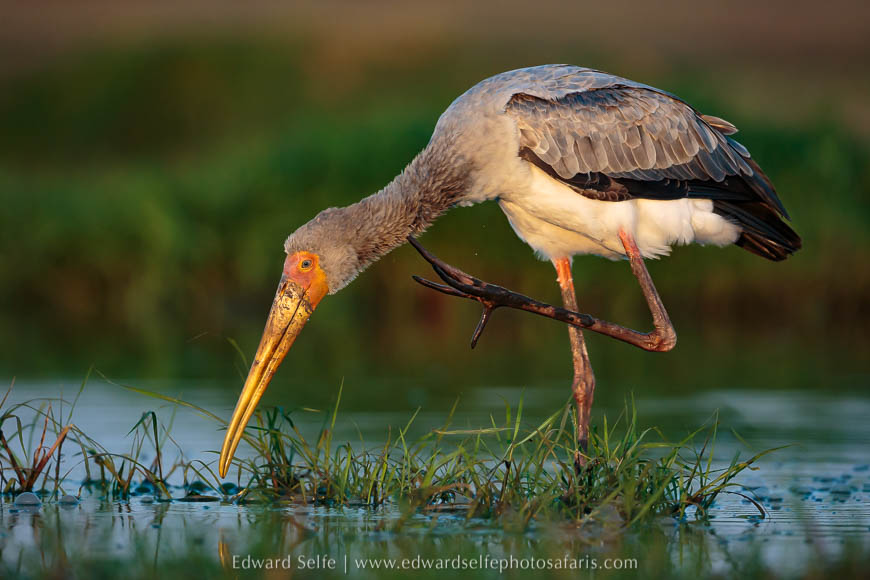
After a day like that, we really wondered what else Busanga could have in store for us….but there was more to come. First up was a very tame Yellow-billed Stork chick which fed in the channel very close to us….
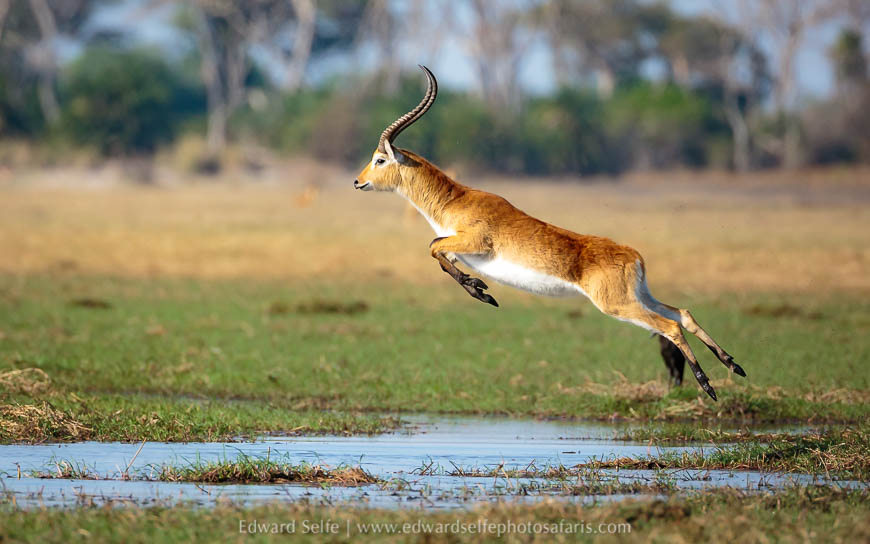
…and then we got our dream lechwe jumping shots….a whole herd ran towards a channel and jumped across, one by one, giving us endless chances to get it right. In fact, this ram was the first who jumped and his jump was the best shot I got!
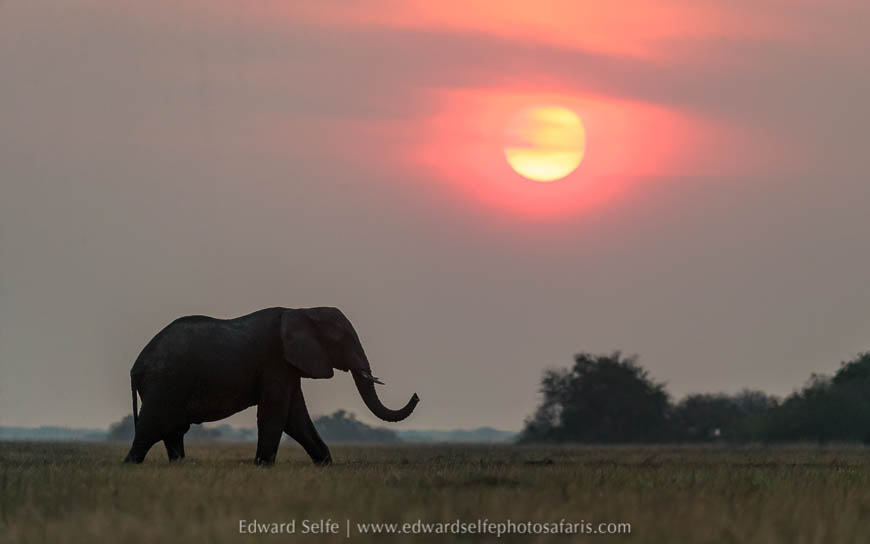
Our evening was spent with a fantastic group of elephants who drank, mud-bathed and then obliged us by crossing against the sunset!
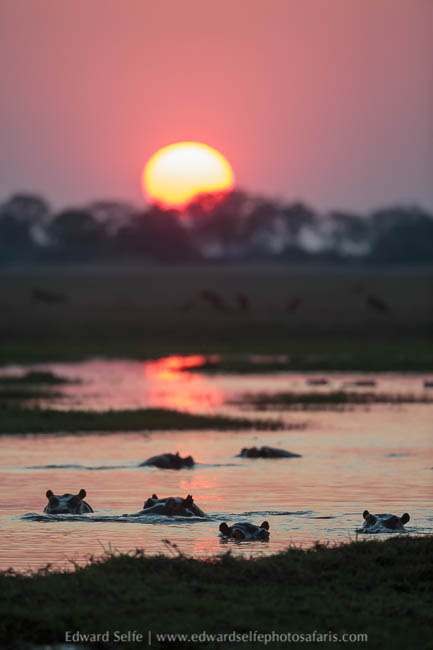
We ended the day with a sundowners at a waterhole with hippos bobbing up and down to investigate our smell.
I am often apprehensive about the final morning of safari on any trip. Invariably, we have had a great time already but I want guests to leave with a great final experience. Sometimes it works out, and sometimes the morning loses energy and tired guests follow suit. I always find something fun to do, even if it’s a memorable coffee break, but we are always working with wildlife and it just doesn’t want to play somedays. While I knew that we could not hope or expect anything more from this Zambia trip (how could we, when we had seen so much!?) I quietly hoped that the forecast cooler weather would bring some mist to our final morning on safari in Busanga. As soon as I got up in the morning, I checked out of the front of my room and saw the thick carpet of mist lit by the remaining moon. This was what I had been hoping for, and now it was up to me to find some great subjects to place in the scene!
Well, when we left camp and stopped just 200m from the gate to scan for wildlife, I was pretty excited to see lions approaching us! What if we could line up the lions, the mist and the sunrise all at the same time?! We positioned carefully, with space to adjust if we needed to, and waited…..
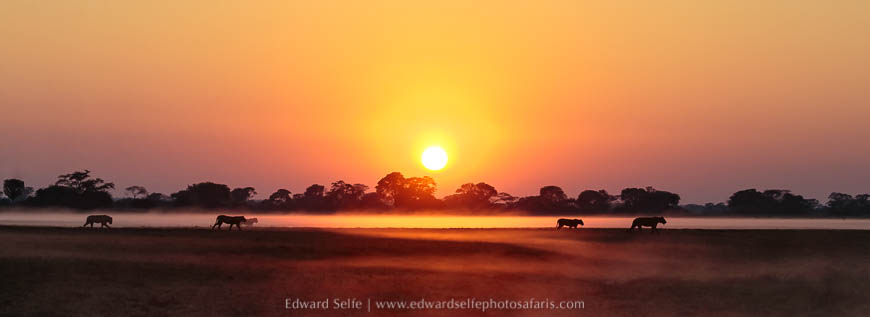
We didn’t even have to move position…as the sun broke the horizon, the lions started to move across in front of us. The mist layer thinned but remained as the lions crossed in front of the sun!
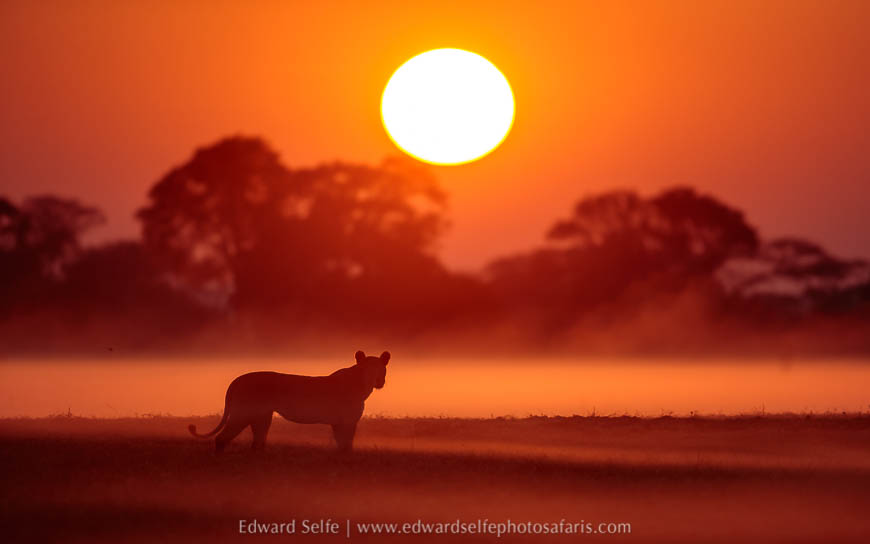
And, as a final gift, the last lioness stopped as she moved into the frame and looked towards the sunrise….absolute magic. With wildlife photography, we can increase our chances of getting great photos through experienced guides, good planning, careful positioning of vehicles and guests…but we still need the luck to go our way. 2 minutes earlier or later and the sun would have been too low or too high for this shot to work.
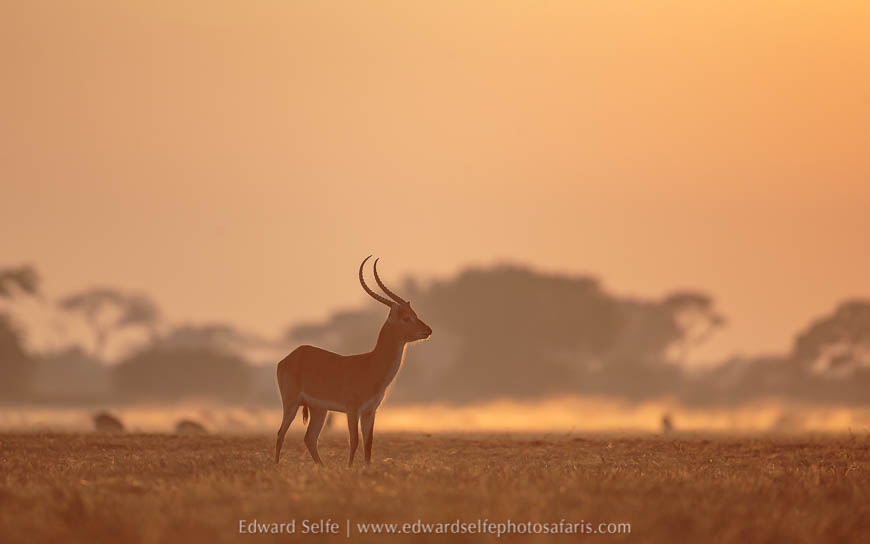
As the lions moved on, we shot images of anything else that was still standing in the mist….
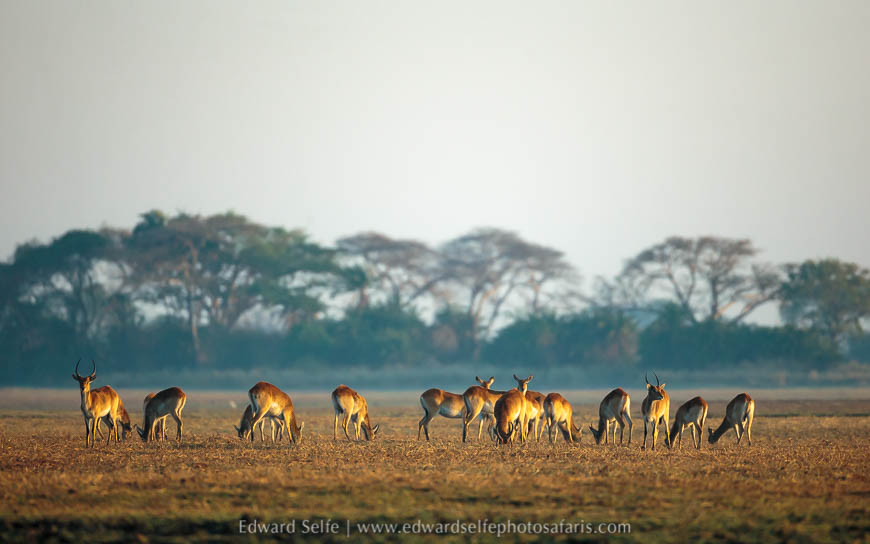
…and then noticed that the mist had cleared a lot of the haze and the strong, beautiful light on the lechwe herds was just as beautiful as the misty morning had been!
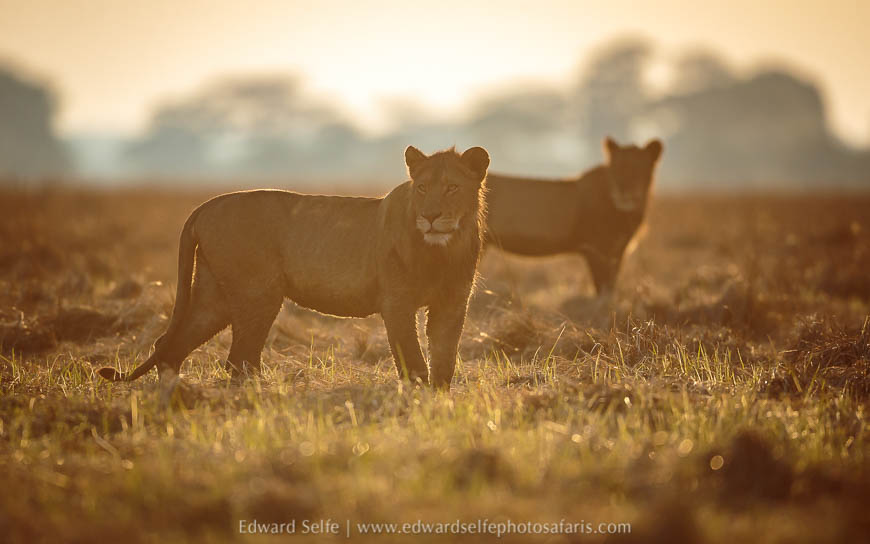
As the light brightened, we set off to follow the lions, and spent the rest of the morning with them. We could hear males calling in the distance and they seemed to be moving away from them, so they were active for much longer than we could have expected.
Well as final mornings go, we could not have dared to wish for more. And in fact, as I look back on the trip, I see that we were extremely fortunate in all the camps and parks that we visited. We had given 8-9 hours each day to the bush and had built an up-to-date knowledge of the sightings in all the area we were staying but, as the final morning shows, in the end there is still a bit of luck involved.
This was a massive and wonderful adventure. For my guests of course, but for me too. I am so fortunate to do the job I do, and I am very grateful to Tom & Kent for making such a trip possible. Thank you also to so many of you who follow these adventures. I share these stories with the hope that more travellers will take a chance on Zambia and choose to safari here rather than in some of our better-known neighbours. Zambia’s hard to beat.

